 Leading Blog | Posts by Category |
 Leading Blog | Posts by Category |
04.07.25

What The Senate Hearings on the Signal Chat Security Breach Reveal About the Dysfunctional Disconnect Between Internal/External Conversations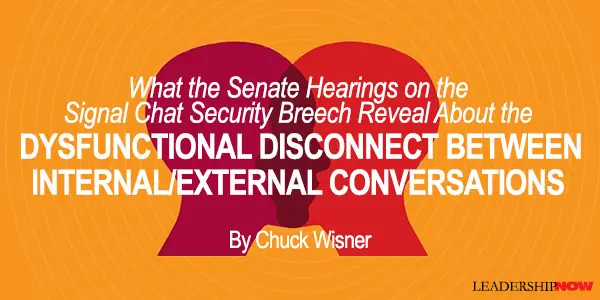
OUR internal conversations may seem inconsequential, but they determine the success of every interaction. They hold secrets to how we can have authentic conversations with others. When CIA Director John Ratcliffe and Director of National Intelligence Tulsi Gabbard recently testified before the Senate regarding the breach of security using Signal’s group chat during an attack on Yemen, their carefully measured responses revealed something profound. As they faced direct questions about the Signal chat, including an accidental text that included Jeffrey Goldberg, editor-in-chief of The Atlantic, viewers witnessed a rare moment when the divide between Ratcliffe and Gabbard’s private thoughts and public speech became apparent. Their shifting gazes and carefully chosen words highlighted a universal human struggle: the gap between what we think and what we say. This chasm creates the tension we carry, the anxiety that keeps us awake, and the misunderstandings that damage our relationships. We all have private conversations with ourselves that no one else hears — the running commentary in our minds, interpreting events, assigning meaning, and shaping our responses to the world. The stories we tell ourselves profoundly shape how we interact with the world, yet we seldom examine these narratives with the scrutiny they deserve. Instead of creating stress by tamping them down, our hidden conversations can be an untapped reservoir of wisdom. Our unprocessed inner dialogues hold insights that could transform superficial exchanges into authentic connections. Our brains as story-making machines Human beings are natural storytellers. Our brains weave narratives to make sense of experiences and create the stories we believe and live by. These internal narratives reflect our beliefs, identities, and perceptions and drive behaviors in ways we often fail to recognize. When we encounter new information, we don’t process it objectively — we filter it through existing stories about ourselves, others, and how the world works. These narratives provide comfort but can trap us in limited perspectives. When your story becomes the only story We are socially conditioned to have “the answer” and rewarded for being the smartest person in the room. Unexplored, our attachment to our narratives can get us into trouble. When we hold tightly to our version of reality — our story about what happened or what something means — we leave little room for mindful listening, alternative perspectives, and collaboration. Like the officials questioned in the Senate hearing, our inability to process and gain wisdom from our private thoughts will trap us in stress. There’s no space for productive dialogue between concerned parties, which guarantees communication breakdowns. When we fail to question our automatic interpretations, we respond to imagined threats rather than actual circumstances. We hear criticism where none exists, assume malicious intent behind neutral actions, and react defensively to perceived slights. Think about your thinking We can develop greater awareness of our internal patterns through metacognition — or thinking about our thinking and creating space between stimulus and response for more intentional communication. Here are practical ways to build this awareness: 1. Expose the stories behind your emotions. When strong emotions arise, identify not just what you’re feeling but the underlying narrative driving that emotion. Our emotions don’t drive our thinking; they’re physical upheavals of our thoughts. Ask yourself: “What story am I telling myself about this situation? What story am I telling myself that’s beneath the negative judgment?” For the officials questioned in the Senate hearing, imagine if they’d felt safe and confident enough to speak their truth and admit their mistakes. This may have led to a commitment to follow the norms that protect confidential information. 2. Mine the facts. Separate observable facts from your interpretations. If someone arrives late to a meeting, the fact is their arrival time. One could assume they are being disrespectful, or one might learn that their child had a bad morning. Grounding yourself in verifiable reality rather than assumptions creates a solid foundation for communication. 3. Process internal opinions through four essential questions When forming judgments, examine them through these lenses: • What are my desires? Identify what you want from the situation. In the Senate hearing, were the officials questioned aiming for obstruction, distraction, or disclosure of truth? • What are my concerns? Acknowledge your fears or worries. Within any opinion lies concerns about outcomes. What worries drove both questioners and the questioned officials in that hearing? Were they able to discuss them? • What power issues are at play? Every conversation involves power issues. Recognizing authority dynamics helps you to navigate conversations. The Senators had the authority to seek facts, but to what authority were the questioned officials committed? • What standards or values are shaping your opinions? Identify the principles or expectations that form the foundation of your judgment. Every judgment we have is fueled by standards that we hold mostly unconsciously. What if all parties in the hearing held the standard that upholding their oath to the Constitution was fundamental? Revealing our inner dialogues — even to ourselves — may initially feel uncomfortable. However, a willingness to examine what usually remains hidden will ultimately lead to more authentic communication. Developing awareness of our inner dialogue exposes patterns we might never notice. This heightened consciousness doesn’t just minimize internal stress — it fundamentally transforms how we connect with others. When we understand the stories driving our reactions, we can choose whether to believe them. As we separate facts from interpretations, we create space for curiosity rather than judgment. And by examining our opinions through multiple lenses, we develop more nuanced perspectives that foster genuine understanding.  
Posted by Michael McKinney at 11:18 AM
03.21.25

Red Flags at Work: Recognizing Problems and Delivering the Bad News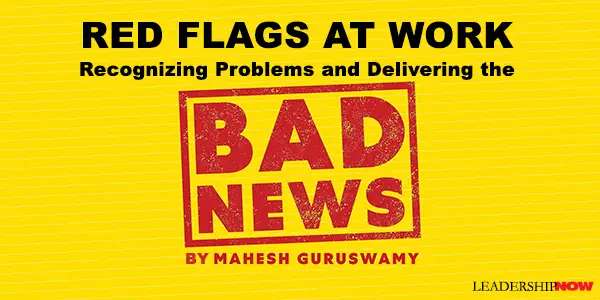
IN MY early managerial days, I would often ask my bosses and peers how they learned the skill of delivering bad news. Almost always, their answer was: “You will learn it over time,” “There is no compression algorithm for experience,” or some variation of needing to put in the time. Granted, experience is one of the best teachers, but I have discovered there are tactics that can be learned so you don’t have to navigate without help. Spotting Problems at Work Detection is about how to spot problematic situations that might require you to intervene and deliver bad news. This might include an employee who is not pulling their weight, runaway projects, and so on. As a manager, you are responsible for making sure you are getting the most out of your team and for delivering a positive return on investment for your company. You are, by default, supporting all the decisions your team is making, and if you keep backing bad decisions, you will be the one held responsible. So, how do you decide when it’s time to take notice? Employees and their personal work-related issues are the bane of every manager’s existence. There are two broad categories of people-related issues in which a manager needs to intervene: individual performance issues and personnel conflicts. They can cause a lot of damage if left unchecked. I suggest you create tenets that employees can use to resolve conflicts on their own versus solving it for them. Project management, encompassing issues that crop up during planning and issues that show up during execution, is another area that may require your overview and handling. The key to spotting problems is to ask the team to break the project down into milestones, and ensure that the distance between each milestone is less than one month. If they are unable to scope the milestone down, then start cutting scope until you get a milestone that is reasonably timed. If your team is absolutely unable to figure this out after a lot of hand-holding, you probably have the wrong people on your team. Preparing to Deliver the News The focus of preparation is on tailoring the tone and temperature of your bad news to match the situation. For example, your response to an employee slipping on their commitments for the first time must be softer than it is for the third time. Pressure, conflict, or disagreement situations all require a different tone of voice compared to peaceful situations. There might be times when you want to get your frustration across with immediacy and clearly to the other person (or group), but other times, you might not want to go there just yet. In my career, I have always taken the approach of raising the temperature slowly, and I wholeheartedly recommend that approach as you prepare to deliver bad news. Most people are not good at handling disagreements or conflict situations, especially if they end up on the losing side. The stronger and longer the disagreement, the deeper the resentment by the people who are in it, even if the outcome is a compromise that benefits both parties. They will remember the pain and the emotional toll of the conflict rather than the relief of the outcome. They will personalize the conflict. They will remember names and times. Raising the temperature slowly doesn’t get people’s dander up, and hence they are more open to sharing what they are actually feeling. They will be more open to compromises and less inclined to hate you if they end up losing their argument. Raising the Temperature Slowly Raising the temperature slowly means starting off by presenting an alternative hypothesis (after fully understanding the option on the table), instead of downright dismissing the one presented by the other person (or team) and taking care not to elicit a strong emotional reaction. For example, when I disagree with a design decision my team is making, this is what my low-temperature pushback will sound like: I am not sure this is the right way to go about it. I have seen evidence from [insert relevant career anecdote] that this won’t work. Have we considered solving this by doing [insert your option]? The emphasized words are what make this work. You are starting the conversation by not outright shooting down the other person’s idea. This gentle pushback will invite a healthy, thoughtful, and objective debate, as opposed to an unhealthy emotional response. In general, stay away from absolutist statements. Those will almost always elicit a strong emotional response instead of a robust discussion and debate. Start with low-temperature pushback and see if you can get your team to see your side of the equation. If it doesn’t work, you may need to increase the temperature. Here is an example of high-temperature pushback for the same situation I previously discussed: This is a bad idea, and I disagree with this decision. I have seen evidence from [insert relevant career anecdote] that this won’t work. It will affect our company by [some catastrophic outcome]. We should do [insert your option] instead. Be aware that just saying the words “I disagree” will elicit a strong emotional reaction from the other person, but such high-temperature messages will get your point across. Note, too, that there is a fine line between a high-temperature message and rudeness. Don’t cross it. The bottom line: If you want to build trust with your team and create an environment of two-way communication, you have to know how to detect problems and address them using the most suitable communication possible.  
Posted by Michael McKinney at 07:21 AM
11.27.24

The Seven Frequencies of Communication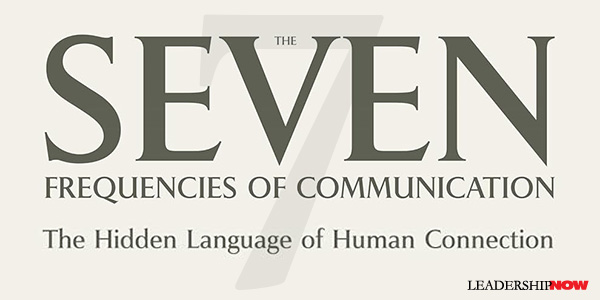
WORDS have power. And how we communicate those words determines their resonance. It is the frequency the speaker uses that connects with us or not. Understanding the frequency with which you are trying to communicate is crucial to reaching and connecting with others. Erwin McManus has provided the map to help us understand how we are heard by others and, importantly, how we can identify what frequencies resonate with those we are speaking to. If we speak at a frequency the listener cannot hear, we don’t connect. The Seven Frequencies of Communication helps us identify and develop not only go to frequencies but also expand our capacity to use other frequencies to connect with others. We all have a core frequency that we use most of the time. As you read through McManus’ descriptions, ask yourself, are you a Motivator, a Challenger, a Commander, a Healer, a Professor, a Seer, or a Maven? When you unlock your frequency, you unleash your potential. What follows is a brief overview of each frequency type. Motivator A Motivator is driven to encourage people and for this reason is probably the most popular. They speak to our needs for energy and self-belief. “When a Motivator speaks, their frequency gets inside of us and elevates our self-belief. A Motivator helps us find energy and strength we did not know we had.” They create a positive, optimistic culture. Motivators understand that people need the energy to take on great challenges, but more than that, they need a foundation of self-belief. Challenger Challengers are all about improvement. They see potential and possibilities, and they define direction. “A Challenger does not believe you need their affirmation as much as you need their drive. The Challenger sees the world as in need of courage. This is the basic need the Challenger tries to meet through communication. The Challenger believes their audience could accomplish anything if they had courage. If you use the Challenger frequency, your role is to elevate and deepen the amount of courage the listener is able to access for their own life.” Commander The Commander frequency is about knowing what needs to be done. It is authoritarian, and at the right time and in the right circumstances, it is invaluable. It carries authority, but to be useful, it must come from a trusted source. “The Commander meets a high need in us for direction. People need to know what to do next in any aspect of their lives. Receiving that direction from someone is a critical part of effective communication.” When you have the Commander frequency, you understand that in certain environments, you must lead with authority. Any place there is danger or alarm. You know what to do and you direct others to get it done. Healer The Healer frequency helps others see their brokenness. “When you use the Healer frequency, you make people feel seen. You help them face their wounds. This frequency embodies the universal truth that no matter who you are or what you have been through, all of us have wounds. Some wounds are obvious. Some wounds are more hidden. Healers have the ability to speak to the deepest wounds in our lives we think no one else can see. When in concert with a complimentary frequency such as Commander, Challenger, or Seer, extraordinary things can happen.” Professor As the label implies, the Professor frequency is all about teaching and helping people to gain knowledge to be successful in whatever they are doing. “This frequency is about more than acquiring knowledge. It is about the love of transmitting what you have earned to others. When you enjoy taking the information you have gathered and turning it into insight for others, you know your frequency is that of the Professor.” Seer The Seer is about imagination and vision. “Their communication opens up possibilities and opportunities for those who are listening. The Seer has the compelling ability to paint a picture of the future no one else can see until they speak.” The Seer lives in the future and is not confined by the past. “Wherever there is a Seer in leadership, their frequency creates a culture of innovation and risk-taking.” Maven The Maven frequency is curious and expresses a need to shift the present paradigm. They seek questions, not answers. They help people see things differently. “To the majority, the Maven frequency brings distress. The Maven is innately heretical, treating the sacred as open to questioning and inquiry. Their violation of orthodoxy is rarely соnscious or deliberate.” The Maven is often not an expert but a student with endless curiosity. They are seen as connoisseurs of new ideas. They can become the one everyone looks to for expertise in a particular domain, topic, or area. McManus has provided an assessment to help you identify your core frequency and primary frequencies and includes a custom report with detailed insights about how to discover the full power and potential of your primary frequency. Like the overuse of a strength, these frequencies have a dark or shadow side. “The shadow of your frequency appears when your frequency is inverted from focusing on others to focusing on yourself. Shadows reshape how you communicate. Where a natural frequency will seek to serve others, a shadow frequency serves only you.” For example, the Challenger can be a manipulator, the Commander a dictator, and the Seer a perfectionist. The Professor can become a diminisher as they demonstrate how intelligent they are rather than using their knowledge to enlighten and build others up. You become most effective when you can move from one frequency to another depending on the needs of those you are speaking to. When you only speak from your core frequency, you create gaps in your communication. You lack empathy. “Empathy is not simply about understanding someone; it is about resonating with them. Empathy is not about transferring what is inside of you to another person, but transferring what is inside of them into you.” The goal of communication is connection, and when you hear and respond to the frequency of others, they feel heard and understood. “Communication at its most human level is not simply the transference of ideas but of hope and love.” 
Posted by Michael McKinney at 11:47 AM
09.25.24

10 Habits of a Peacemaker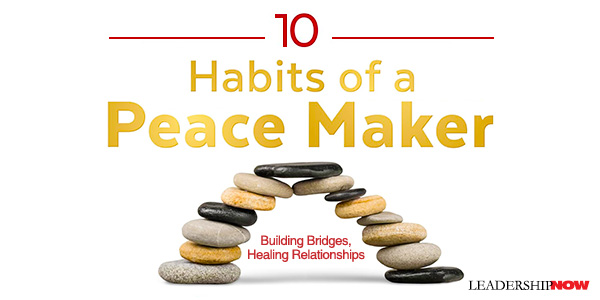
LAW professor Steven Collis is no stranger to polarized arguments. He specializes in the First Amendment. But he has found a way to have constructive discussions without them devolving into shouting matches or accusations. In Habits of a Peacemaker, he provides practical habits and skills to talk about hard topics in a productive way. These habits are more than tactics. They are a way to approach life and see other people. HABIT ONE: Intellectual Humility and Reframing Collis begins where all relationship (leadership) discussions should begin—humility. He states, “Most of us need to recognize that, most of the time, we don’t know what we’re talking about. That may seem offensive, but the sooner we recognize it, the sooner we can open our minds to open our minds to peacemaking and close the door on the kind of contentious behavior that damages relationships.” This is the foundation of all that follows. Judging others creates discord. We should know, too, that when we judge others, we don’t have all of the facts or context. We should take it slow. Conversations must be framed in such a way as to acknowledge the fact that we don’t have all of the information, and the interaction is really about seeking more information and not proving a point. “If someone else brings up the topic in a way that will inevitably lead to fighting, you can move to reframe the issue.” HABIT TWO: Seek Real Learning Building on Habit One, we need to learn from both those around us and from those who have come before us. It means that “we cannot be in a state of constant conflict with either group.” We are all subject to misinformation (really!). We get caught up in catchphrases that circumvent critical thinking. They are often misleading and imprecise, lacking in the intended meaning and nuances. We think we know what they mean by them, but most likely don’t. “It’s entirely probable that both you and the person invoking them place different meanings on them. It’s entirely probable the person invoking them knows exactly what the catchphrase means and has thought long and hard about that meaning. But it’s also likely that a person repeating the catchphrase isn’t sure they know what they mean by it.” Most catchphrases we hear have become an “unsophisticated argument for a sophisticated problem.” We need to diversify our sources of information. Understand the biases coming out of the sources you agree with and those you don’t. It will improve your understanding and knowledge and strengthen your position. And importantly, “Part of seeking real learning is recognizing that whatever conclusion we have reached may be proven wrong as we learn more than we know now.” HABIT THREE: Assume the Best about People Assuming positive intent is assuming the best about people and their intentions. Ask questions. By asking questions, we can better understand others and help them to understand their own views. “In all your inquiries, it’s important to remember why you’re asking questions. Remember: you are not trying to prove a point. You are trying to understand them better so that the two of you can seek ideas and solutions that will speak to both of you.” People act on what they know and understand, which may be very little. “What they have learned about humans is that we tend to reach conclusions based on our gut reactions to any given set of facts, then reason backward to justify conclusions.” We all have insecurities, and we are all subject to confirmation bias. We often project onto other people what we think about them, instead of discovering what they actually think. When we’re dealing with someone who we think is assuming the worst about us, our first step should be to ensure we aren’t just heaping upon them our own insecurities. HABIT FOUR: Don’t Feed People’s Worst Fears Kindness goes a long way and has more constructive powers than sarcasm and anger. Controlling our own emotions is key but not always easy, especially on certain topics that have a powerful hold on us. “The challenge, then, is not to change who you are. It is to reach a point where the topics no longer affect you as much.” Peacemakers are slow to state strong opinions. Listen more than you speak. HABIT FIVE: Hunt for the Best Argument Against You I love this point. Those who disagree with you generally have strong arguments for their position, but by seeking those arguments out “it will force you to better understand, articulate, and defend your own opinions. It may even cause you to—gasp—change your mind.” Peacemakers are not afraid of arguments or facts that challenge their worldview. They seek them out. They analyze them. If arguments or facts make them uncomfortable, they seek to understand why. Seek to learn where you might be wrong. HABIT SIX: Be Open to Change All of these habits come to nothing if you are not willing to consider the need to change your views. “With intellectual humility comes the recognition that there may be more to learn about any topic and that as we learn, our positions may change. Peacemakers do not fear that.” HABIT SEVEN: Spend Time with People The author confesses that he struggles with implementing this on a consistent basis because, as a law professor, he enjoys thinking about some of the hardest topics—constitutional law—of the day. The advice is simple: “Spend time with people doing uplifting things and talking about topics other than the hardest issues of the day.” Considering the delegates that drafted the Constitution of the United States, he observes: “In an environment where hostility could have easily prevented anyone from getting along, the delegates worked well with each other because they were forced to spend time together outside the debating framework. In short, they became friends. It’s hard to hate or discount the people you know well.” We are all on a journey. Key lesson: When we spend time with others and truly get to know them and the circumstances that led them to behave as they do, we tend to be less judgmental of them and more understanding of who they are and why they make the decisions they do. HABIT EIGHT: A Sliver of Humor Humor disarms your listeners. Not everyone finds everything funny. There are different types of humor. Collis lists five. It is important to figure out what kind of humor your audience prefers. Read the room. “While humor can be an effective tool, you must know when it is appropriate. Humor is like social media; use it deliberately, at least in the context of discussions about hard topics.” HABIT NINE: Seek Inner Peace “Peacemakers take the time in their lives to engage in habits that cultivate inner peace, which then permeates outward into the rest of their lives.” You can achieve this through practices like mindfulness, prayer, journaling, and reading. Schedule time to engage in any or a combination of these practices. HABIT TEN: Embrace the Discomfort of Non-Closure Human beings do not like to leave things open-ended. We lean into black-and-white thinking. This kind of thinking can lead us down the wrong path and into toxic discussions. Get comfortable in the gray areas and savoring differences. Obtaining education is not the same as obtaining degrees. True education, not mere degrees, seems to be able to soften our tendency toward dichotomous thinking. It allows us to bask in new information and in new discovery. That said, there are things we can be certain about. But keep in mind, “The decided are always gentle.” That means “there is a calmness and tranquility that comes to us once we have already made up our minds on a particular issue. We need not revisit it again and again every time we face it.” A life rule to follow: “Resolve to behave toward other people with a selfless desire to lift them up regardless of the consequences or who they are.” We can all strive to make other people’s lives better and brighter. 
Posted by Michael McKinney at 12:02 PM
05.13.24

4 Rules to Unlocking the Secret Language of Connection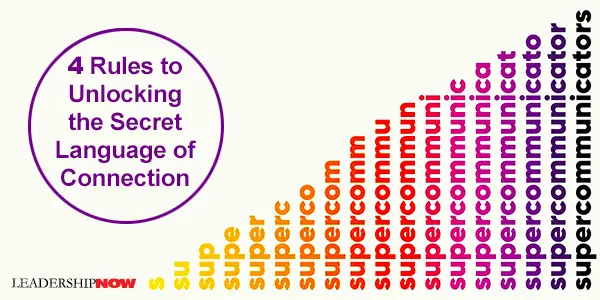
THE GOAL of any communication is to connect. Some people are supercommunicators. That is, as they talk, they align with the person they are speaking with, constantly adjusting how they communicated in order to match their companions. In Supercommunicators, Charles Duhigg explores how we communicate and connect. He explains why our communication sometimes goes awry and what we can do to make it better. “Anyone can become a supercommunicator—and, in fact, many of us already are, if we learn to unlock our instincts.” To begin, we need to understand that many discussions are actually three different conversations, and if we want to connect, we need to be “engaged in the same kind of conversation, at the same time” as the person we are communicating with. There are practical, decision-making conversations that focus on What’s This Really About? There are emotional conversations, which ask How Do We Feel? And there are social conversations that explore Who Are We? We are often moving in and out of all conversations as a dialogue unfolds. However, if we aren’t having the same kind of conversation as our partners, at the same moment, we’re unlikely to connect with each other. With that in mind, we can see that the most meaningful conversations should be characterized as learning conversations. We want to learn how others see the world and help them to understand how we see the world too. Learning conversations are based on the following four rules: Rule One: Pay Attention to What Kind of Conversation Is Occurring We miscommunicate when we are having different kinds of conversations. “Effective communication requires recognizing what kind of conversation is occurring, and then matching each other.” When we connect with others, it is because our brains have come into a kind of alignment. When we dominate a conversation, we make it difficult for others to sync up; they become pushed into their own thoughts.
Effective communication requires recognizing what kind of conversation is occurring, and then matching each other. Characteristics of Supercommunicators:
Rule Two: Share Your Goals and Ask What Others Are Seeking Every meaningful conversation begins as a negotiation about what this conversation is to achieve and how it’s going to go or how we’ll make choices together. Matching is understanding someone’s mindset—what kind of logic they find persuasive, what tone and approach makes sense to them—and then speaking their language. And it requires explaining clearly how we, ourselves, are thinking and making choices, so that others can match us in return. Rule Three: Ask About Others’ Feelings, And Share Your Own Emotions are a part of nearly all conversations if we choose to acknowledge it. When we do acknowledge it—their emotion, their vulnerability—and are vulnerable in return, we build trust, understanding, and connection. You begin by asking someone how they feel about their life as opposed to the facts of their life. Margaret Clark, the Yale psychologist, said, “The best listeners aren’t just listening. They’re triggering emotions by asking questions, expressing their own emotions, doing things that prompt the other person to say something real.” Laughter is one of proving that we hear how someone feels. We exhibit emotional intelligence by showing people that we’ve heard their emotions-and the way we do that is by noticing, and matching, their mood and energy. When we match or acknowledge another person’s mood and energy, we show them that we want to understand their emotional life. It’s a form of generosity that becomes empathy. It makes it easier to discuss How Do We Feel? Acknowledging emotions is critical when dealing with conflict. If you don’t get to the emotions, you’ll never know what the fight is actually about. “This is the real reason why so many conflicts persist: Not because of a lack of solutions or because people are unwilling to compromise, but because combatants don’t understand why they are fighting in the first place. They haven’t discussed the deeper topics—the emotional issues—that are inflaming the dispute.”
Lessons from Martial Conflict Nearly all couples fight from time to time. And whether happy or unhappy, they tend to fight about the same things. For the most part it comes down to control issues. Consider these findings: Researchers noticed that many divorces happened after major life changes, in part because these changes had triggered a sense of losing control. It might be an illness—control over our health—or a big upheaval as retirement or kids leaving for college, which makes the future seem less predictable. These shifts made people exhausted, lonely, anxious, as if they had lost agency over their days and bodies and minds. Lesson: Share control. Good thought: “It’s a complicated world, you know? You need friends who are different if you want to figure it out? Rule Four: Explore If Identities Are Important to This Discussion Our social identities shape how we speak and how we hear. In crucial conversations, we often get locked in on one identity. But we possess multiple identities so we need to look for identities we have in common. In a Who Are We? conversation, we sometimes latch onto a single identity: I am your parent or I am the teacher or I am the boss. In doing so, though, we hobble ourselves, because we start to see the world only through that one lens. We forget that we are all complex and that, if we were thinking like parents instead of doctors, we might also ask skeptical questions about the drugs a stranger wants to inject into our kids. We might remember that asking questions is what good parents are supposed to do. So, in a Who Are We? conversation, we need to begin by drawing out our conversational partners’ multiple identities. Second, we need to put everyone on equal footing. “Don’t offer unsolicited advice or trumpet your wealth or connections. Seek out topics where everyone has some experience and knowledge, or everyone is a novice.” Finally, look for similarities and create new groups by building on existing identities. 
Posted by Michael McKinney at 12:09 PM
10.30.23

Unlocking the Secrets of Ideal Relationships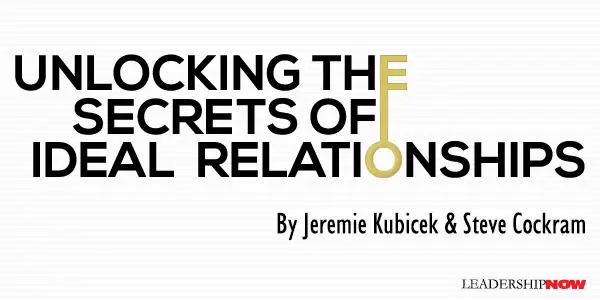
COMMUNICATION is a two-way process. It is imperative that we understand how to transmit and receive in order to have the appropriate communication that builds stronger relationships. The Evolution of Communication From the hieroglyphics of ancient Egypt to the tweets of today, communication has always been humanity’s compass. By the firesides of our ancestors, stories shaped cultures and defined communities. Today, we navigate through torrents of emails, texts, and posts. Yet, one thing remains unchanged: our innate need to connect meaningfully. If we do not treat communication as a strategic tool, then we just might become accidental and not intentional, which will continue to erode the power of relationship. Every conversation is an art form. It involves a choreography of words, gestures, tones, and even the silences in between. Each dialogue is colored by personal histories, beliefs, and emotions. Without intention or clarity, such interactions risk devolving into cacophonies rather than harmonious exchanges. We have tried to codify these interactions with The Communication Code. We are seeing the need in this viral landscape to teach people how to verbalize their needs practically inside each conversation to ensure that expectations are met and not discounted. Our Inherent Need to Connect Humans are wired to seek connections. Our success, survival, and emotional well-being hinge on our ability to bond. In today’s hyper-connected yet often impersonal world, nurturing these bonds demands renewed focus and commitment. It requires us to be thoroughly intentional in a world that awards the laziness of accidental living. It’s about ensuring messages aren’t just sent but are received as intended. It’s crafting an environment where interactions foster understanding, trust, and mutual respect. Imagine if you had a language and a set of code words that were used as a guide to help each party minimize the chance of creating dangerous misunderstanding. We are writing this because of our own experiences and want to save you from what we have gone through ourselves. Tales of Misunderstandings In a bustling London café, two business partners met after not being in the same city for a few months. One narrated a business success, expecting to celebrate. The other, thinking they were helping, offered critique on a better way to have held the meetings. Expectations were unmet, and voices were raised. Why was it so hard to celebrate? Why didn’t the business partners know how to set up the desired communication so that expectations could be met? Such instances are commonplace and emphasize the need for alignment in conversational expectations. Decoding “The Communication Code” Because of the above episode, we have created a system that allows each of us to have a code word that allows people to understand the expectations of the other person. It’s called “The Communication Code”. The “code words” are more than vocabulary; they’re signposts, guiding conversations:
Imagine understanding the code word of those closest to you. If you know that someone wants Clarity before Collaboration, then you will begin the conversation by asking clarifying questions. Once the other person feels like you understand them, then they will be open to your Collaboration. The same is true with all of the code words above. Each of us has a desired expectation, but very rarely do we share it with others. If you are given the code words of what others desire, then active listening becomes more automatic than what most experience in daily conversations. Code words are, in essence, packed expectations. If you can both share and discern, then you are on your way to becoming relationally intelligent. The Power of Mastering the Code By mastering “The Communication Code,” one can transform not just individual interactions but entire communities. It becomes the bedrock for harmonious families, efficient workplaces, and more compassionate societies. In a broader sense, mastering genuine communication can bridge societal chasms. From resolving local community issues to diplomatic negotiations on global stages, the principles of effective communication remain paramount. If we can commit to proper communication, then we can unlock relationships through every conversation we have, which might lead to peace at levels unimaginable. “The Communication Code” is a compass for the modern communicator. It’s an invitation to journey back to the essence of genuine connection while navigating the complex terrains of contemporary communication landscapes. By internalizing its tenets, one not only hones their communication prowess but also enriches every facet of their life. Embrace its insights, let every conversation be a bridge, and transform every relationship into a cherished bond.  
Posted by Michael McKinney at 07:54 AM
10.17.23

5 Leadership Lessons: The Leader’s Voice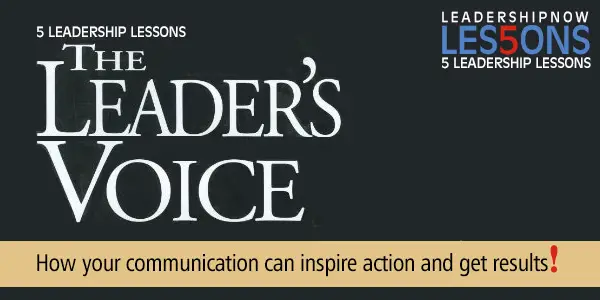
LEADERS HELP FOLLOWERS find causes worth signing up for—something they can make an emotional investment in. That highlights the importance of leadership communication. Effective leaders communicate who they are and move the whole organization. Boyd Clarke and Ron Crossland are the ones who said, “The biggest problem with leadership communication is the illusion that it has occurred.” Here are five takeaways from their book The Leader’s Voice: How Your Communication Can Inspire Action and Get Results!

Posted by Michael McKinney at 03:23 PM
07.17.23

Afraid of Public Speaking? You Should Be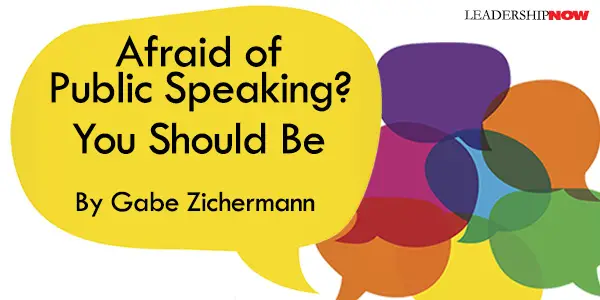
RECEIVED WISDOM is that public speaking is one of people’s greatest fears. But the Chapman University Survey of American Fears (yes, that’s a thing) — the gold standard for fear assessment — doesn’t seem to agree. In the 2020–2021 findings, public speaking is fear #54 on the list, scoring lower than another pandemic (#6), identity theft (#21), and even sharks (#51). This seems reasonable. You should be more afraid of pollution (#9) than giving a toast at your best friend’s wedding — though the obvious connection between the two (cocaine, hairspray, tik-tok based dances) — need not be underestimated. It never really made sense to me that public speaking caused this much fear in a world filled with so many things to be fearful of. So I was naturally relieved to see in my research that most Americans were plump with the same anxieties that actually keep me up at night. Make no mistake — public speaking put in a great showing. It’s basically the only work-related fear that even makes the top 100, other than the quirky “fear of being caught in an embarrassing zoom moment” (#87) — a perfect distillation of the pandemic’s mental health hangover if there ever was one. Thanks, Toobin. But does that mean that public speaking is no longer something to be afraid of? Does this mean that if you fear getting up on stage or Zoom or leading a meeting — assuming you’re fully clothed — that you should be derided like someone with a debilitating fear of clowns (#94)? Or does this mean that you don’t have anything to worry about if you’re pursuing a career path that involves public communication and effective persuasion? Au contraire. You should be afraid of public speaking. Very afraid. I’ve been a paid, professional public speaker for the last 20 years and have coached many executives/founders on their speaking skills. I have seen firsthand the fear that grips newbies or professional aspirants as they work to master the skills of the stage. Whether they are doing their first TEDx talk or just trying to scale the leadership ladder at work, they almost always feel fear and anxiety about the effort. And I’ve heard, hundreds of times, people saying, “I want to be confident and unafraid of public speaking” when asked about their goals. Yet, this is impossible. Unless you’re a sociopath — and if you are, stop tracking my data (#17) — you should fear public speaking. I still do. You’d never be able to tell from my talks, but I get anxious every time I get up on stage. Hundreds of speeches, panels, and sessions later — most folks are shocked to hear this. “But you don’t look nervous,” they’ll say about my TED talks, or “I couldn’t even see you sweat,” they’ll intone if I wear dark colors. When working with me or taking my courses, they’ll try to emulate that cool, calm exterior — thinking it matches the interior monologue. But the truth is that being afraid of public speaking is part of what makes me really great at it. I do two things with fear and anxious energy when I’m presenting, and you can too: 1. Lean into the fear.
Leaning into Fear First and foremost, acknowledge that you’re going to be nervous/anxious/afraid, and that this is expected. Instead of trying to completely remove fear in the hour before a talk or pitch, I’ll focus my energy on using that nervous bubble to propel me forward. I know from experience that my fear and anxiety will subside by around 90 seconds into the presentation, and I’ll naturally pop into a “flow” state. Then, I won’t notice the room or my nerves or anything other than being one with the material and the audience. The anxiety is great fuel for success, and I know that as long as it doesn’t control me, I control it. Channeling the Fear Focusing the fear in the right way also tends to produce superior results. Most novice speakers are primarily afraid of forgetting the material. That is, getting up on stage, blanking on what they’re going to say next, and being embarrassed. This is the reason many newbies focus on scripting every word they’re going to say tightly — as if more and more and more anxious, angry work will produce optimal results. Spoiler: this never does. But what experienced speakers know is that the “right” kind of fear in a talk is not the fear of forgetting the material but rather that the audience won’t pick up what you’re trying to say. That is, will you have persuaded them that your ideas matter, that you are credible, and that they can change their lives/the world with what you’ve told them? This is a great fear to have and means you care about what the audience gets from your work. If you have a good technique for memorization (spoiler #2 — I teach a great one), over time, you’ll learn to feel that fear and direct it toward the audience and your delivery rather than toward the risk of something bad happening. This also tends to produce great results. You should be afraid of public speaking, therefore, because it is a job with tremendous impact, and you have an obligation to deliver on that promise. After all, a room (or Zoom) full of people — on someone else’s advice — are giving you their attention for 20, 30, or even 60 minutes. They are there because they expect to be entertained and informed, and this is time they will never get back. It’s also a time when you’re able to plug directly into their minds in a way that is impossible in any other medium. The pores of their learning faculties are opened as wide as they will ever be, and you are the thick, delicious, intelligent moisturizer that’s going to plump their brains with knowledge and empowerment. Squandering this limited opportunity would be a waste. No matter how small the stage, or how familiar the audience, treating every talk as important — and every fear of failure as valid — is your opportunity to change the world. Setting aside for a moment all the psychological explanations for why you might be afraid of public speaking, let’s just take it as a given that it is intimidating. Know that even experienced speakers feel some kind of anxiety, but that we’ve learned to harness it. Understand that there are skills you can use and techniques you can deploy to help you perform at your best, and that putting in the work to channel your fears and improve your communication skills will help. Maybe then you’ll be able to get your fear of speaking down to something more reasonable, like murder hornets (#77), ghosts (#88), or zombies (#89). Really? Zombies?  
Posted by Michael McKinney at 06:19 AM
05.24.22

Amplify Your Influence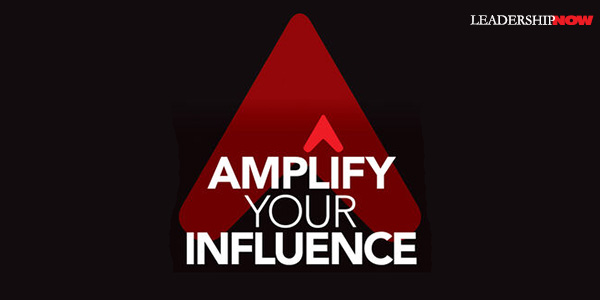
LEADERSHIP is intentional influence. Influence is a science that can be learned. Understanding how the brain functions is key to developing greater influence. René Rodriguez, the author of Amplify Your Influence, says influence is “about understanding how our brains, and those of our audience, process information.” The brain uses the reticular activating system (RAS) to sift through all of the messages we are bombarded with at any given time. From our vantage point, it filters out what is important and what we can ignore. As communicators, we have to learn how to appeal to our audience’s RAS to gain their attention. Working with the brain, our ideas can gain faster acceptance and is the idea behind the Amplifii Method. Frame > Message > Tie-Down The Amplifii method is a three-step sequence. Rodriguez tells us that sequence is everything. “Sequence is positioning your message and delivery of a message, story, or presentation in a way that aligns with the biological and neurological makeup of how our brains are wired to receive it.” Frame If you don’t provide the frame for your message, the audience will provide their own frame based on their past experiences, which may run counter to your intended message. If we don’t frame the message, we will lose it. “Story is a powerful device to control the narrative. But there are many other framing devices, too, including props, quotes, jokes, statistics, and even music.” The frame is designed to draw in your audience, create credibility, and build trust. But it does not build influence. “The frame sets the context for you to deliver your value proposition or core message. If delivered effectively, the message sets the stage for influence.” Message The goal of the message is to be clear and eliminate the need for assumptions of the part of your audience. It is essential to have a unique perspective. “To have influence, we must not only get others to see things from our perspective but fully understand their perspective as well.” When using clichés—and they can be powerful and sum up a lot of meaning—always qualify them. Acknowledge it is a cliché, and then explain exactly what it means to you and your audience. With the frame and your message, your audience doesn’t know where you’re going until the tie-down. That way they don’t jump ahead and fill in their own frames and conclusions, and so they remain open to your message and tie-down. Tie-Down The tie-down gives meaning. The frame and message without a tie-down are “like a joke without a punchline. It’s unfinished and doesn’t add value.” The tie-down explicitly outlines the precise value of the message in the context of what is important to the audience and their current needs. When you can accomplish all that, the magical outcome is influence. Naturally, self-awareness plays in your ability to influence anyone or anything. “Anyone can learn the skill of influence, but if we lose sight of how our behaviors affect those around us, those skills are for nothing. No skill or technique will make up for a lack of judgment or being tone-deaf.” A Very Simple Example Of all the examples Rodriguez gives, this example quickly gives you a taste of the Amplifii process. In a job interview, Janice is asked, “Tell us something you’re proud of in your life.” She responds, “I earned straight A’s my senior year in high school.” The answer is straightforward and direct. And gets the job done. But it leaves the listeners open to process it any way they want through their own biases and experiences. They can think she finally worked hard her senior year, or maybe she was privileged and had everything handed to her. Without providing a frame, what she was trying to convey could easily be lost. A better answer using the Amplifii process looks like this: FRAME: “Unfortunately, growing up, I was surrounded by adults who told me I wasn’t very smart. When adults tell you that as a child, you begin to believe it, and I hard a hard time in school. But something happened in my senior year in high school. I looked at myself in the mirror and said, ‘I’m either going to believe them forever or I’m going to do something about it and prove them wrong.’ I decided I was going to do something about it. And I did. 
Posted by Michael McKinney at 02:29 PM
05.06.22

Disagreeing Agreeably: Using Conversational Aikido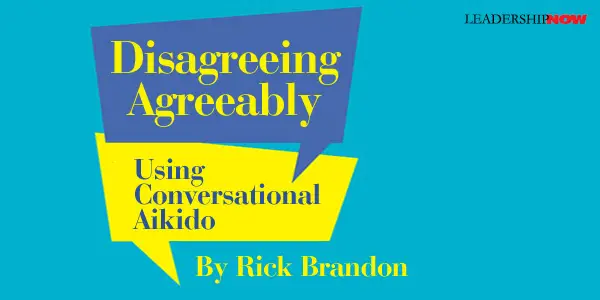
YOUR boss tells you to implement a new idea or policy that you believe will cause problems (because it’s a boneheaded idea!). You’d be out of integrity not to raise your concerns or tactfully disagree. Still, you don’t want to commit a career-limiting move. Or, you’re comfortable with the overall idea, but you want to foster deeper thinking about potential obstacles, and oh, yeah ... you want to live to talk about it! You’ll Disagree Agreeably by using the Conversational Aikido Technique with managers, associates, clients, vendors, friends, family (especially kids), and others in order to:
Aikido Philosophy. The Eastern martial art of aikido is about harmony, not conflict, and equates well to Disagreeing Agreeably. Western boxing involves overpowering a foe—force against force. Aikido isn’t about striking, overpowering, or forcing an opponent to comply. It entails moving with and aligning with the other’s energy to remain in control. Conversational Aikido involves understanding their viewpoint and finding its merit before expressing your differing point of view. Using Political Savvy. Conversational Aikido is interpersonally savvy and politically savvy. When power, politics, and ego are involved, this tool helps you to fly under the radar of a superior’s “hyperactive ego gland.” Your well-intentioned feedback may be interpreted by ego-trippers as unwarranted criticism or an implied threat. Politically naïve people put their foot in their mouth so much they contract Athlete’s Tongue. They could floss with shoelaces! The Conversational Aikido Technique prevents you from wounding the king or queen. The king or queen is still alive. Your head may get chopped off! Don’t let your intellectual “rightness” or subject matter expertise lure you into criticizing an idea in an overly zealous way, even if the egotist doesn’t possess positional power. Being in someone’s doghouse is unwise regardless of their status. The Conversational Aikido Technique: Step-by-Step Influence adeptness requires awareness of the impact of your behavior. You already know that direct but respectful wording and tone must supplant inflammatory (Aggressive) language or weak (Passive) language. Let’s plug Assertive Speaking, Active Listening, and the Straight Talk Mindset into the steps of the Conversational Aikido Technique for Disagreeing Agreeably:
1. Listen Non Judgmentally and Empathically to the Idea. Focus your body in order to pay empathic, nonjudgmental attention to the person’s idea or request, regardless of what you’re thinking. Paraphrase thoughts and feelings to capture the idea’s essence, rationale, and emotions behind it. This demonstrates respect for the person, proves that you’ve understood their idea, and conveys that you accept its validity for that person. You’re absorbing the idea instead of prematurely reacting, evaluating, or dismissing it. This is akin to aikido’s aligning philosophy, as is the next step. 2. Generously State the Merits of the Idea. Before expressing negative reactions, first show that you see the pluses of the idea or proposed action. Genuinely say everything you like about the idea, and not just in a token way. Really lean into this step with multiple, specific, and sincere, positive comments about the idea’s redeeming qualities and benefits. Like Mary Poppins sings in the movie, “A spoonful of sugar helps the medicine go down.” You’re helping the person consider their idea’s downsides by first being in harmony with its upsides (acknowledging). This “spoonful of sugar” does NOT mean you are BS-ing or sugar-coating your viewpoint about the idea’s cons or drawbacks. Most ideas have some merit, even if it’s just the passion that the person has for it or the energy they invested into developing it. If you can’t find anything positive to say, can you spell r-i-g-i-d? Aren’t you being a crap-detector? Show good faith by digging deeper to find some aspect of the person’s idea that you respect. It’ll pave the way for what comes next—your concerns or disagreement. Lead-in phrases for this merits step include: “What I like about your idea is ... I can appreciate ... You’ve done your homework ... What’s admirable is how you ... The upsides are clear, like ... I support your goal of ... Some merits I see are ... We’re really aligned on ...” 3. Tactfully Surface Your Concerns. You’ve earned the right to candidly share the idea’s variables they haven’t considered or missing pieces. You’ve generously shared the pros, so don’t be shy about voicing the cons. This step’s lead-in phrases include: “Let’s also consider the possibility that . . . An issue might be ... One concern is ... A major challenge could be ... I’m not as confident as you since ... How will we respond to ... A downside I see is ...” When bridging from acknowledging the idea’s positives to voicing reservations, steer clear of the word but or its cousins, however and nevertheless. They erase everything you said before them. The person will only hear the “but,” not the merits you’ve cited. You know what I mean if a romantic interest has ever said to you, “I really like you as a friend, but I’m not interested in dating you.” Ugh. “But” risks your “likes” about an idea coming across as merely going through the motions. 4. Give Your Conclusion. You’ve conveyed both sides of the coin—the idea’s pros (merits) and cons (concerns)—acknowledging that they can stand side by side in the universe. Now, give your bottom-line conclusion, which might be to problem-solve around your concerns and move forward, to withhold support until later, or to graciously decline supporting the idea. You still can convey respect for the person. You’re not rejecting them, just their idea.  
Posted by Michael McKinney at 07:09 AM
02.23.22

Crisis Communications: Not If, but When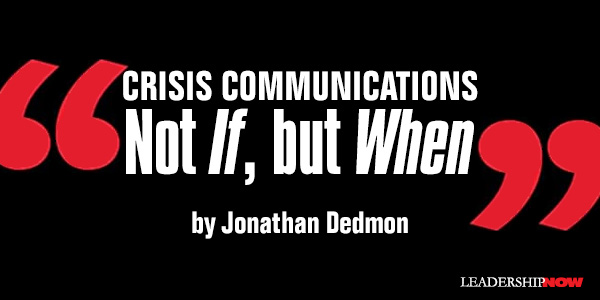
You never want a serious crisis to go to waste. THE quote above is from former Chicago mayor Rahm Emanuel, who was President Barack Obama’s chief of staff during the 2008–2009 economic crisis and Great Recession. However, similar comments go at least as far back as Italian diplomat, philosopher, and writer Niccolò Machiavelli in Renaissance Florence. Of course, no one and no organization wants a crisis, but inevitably one will happen. Crises come in all shapes and sizes, but generally share several attributes:
As the late management guru Peter Drucker noted, “Turbulence—for those who still remember a little mathematics—is characterized by unpredictability. It is certain that the unpredictable will happen; but it is impossible to predict where, when or how.” So it is with crises. While no organization can avoid turbulence at some point, it can keep its seat belt fastened and be prepared BEING PREPARED The Team The first step is to establish a core team that can manage crises effectively right when they occur. The team should include:
Depending on the nature of the crisis, the team should be expanded to include appropriate senior executives. They could include the following leaders and department heads:
However, it should not be too large. More than ten people is too large. Identify and notify the core members of the team, and hold a meeting before any crisis occurs. A word about legal counsel. Counsel can be expected to ably assess the legal risk of the crisis and suggest specific actions to address it. Almost inevitably, the plaintiffs’ bar will file lawsuits for millions and even billions of dollars in damages on issues ranging from company products being linked to cancer to violations of securities laws over the nature and timing of disclosure of the issue. You must realize, too, that there is also what could be called “brand risk” involving a range of organization stakeholders that can be extremely important to the overall strategy. For instance, corporate boycotts over specific company policies, while generally not that successful by themselves, can and do generate significant negative media and public attention that leads to change. Boycott examples have included Chick-fil-A for its opposition to same-sex marriage, Caterpillar for selling construction equipment to Israel that was used to bulldoze Palestinian homes, and products from South Africa over apartheid. Two of the most famous boycotts:
Boycotts demonstrate the need for companies to do the right thing in the first place Taking Inventory Before a crisis hits, the first task for the core team is to take inventory of the type of crises that have occurred in the organization’s past and that might occur in the future, given its business. For instance, for an oil company it could be a major oil spill, such as the Exxon Valdez tanker off the coast of Alaska or the Deepwater Horizon oil platform explosion in the Gulf of Mexico, causing severe environmental damage and, in the latter case, deaths. For a food company, it could be contamination of its products, either with a foreign substance or a pathogen such as E. coli, necessitating a massive product recall. Perrier’s market leadership in mineral water in the US was decimated when trace amounts of benzene, a carcinogen in significant quantities, was found in some of their bottled water. For a clothing company, it could be a major human rights organization exposing dangerous working conditions or child labor in a developing country. More than a thousand workers perished when a Bangladesh factory producing Nike products collapsed. The Plan Using the inventory, compose a written plan—in advance. Make it only a few pages, not a long document that likely will then sit on a shelf. It should include:
Organization and Logistics As noted, the crisis team needs to have a logistics plan in place for communications—and for everyone to understand it. This should have a number of pieces, including but not limited to:
There are many more. 

Posted by Michael McKinney at 08:09 AM
12.07.21

Speak Your Truth So That Others Can Hear It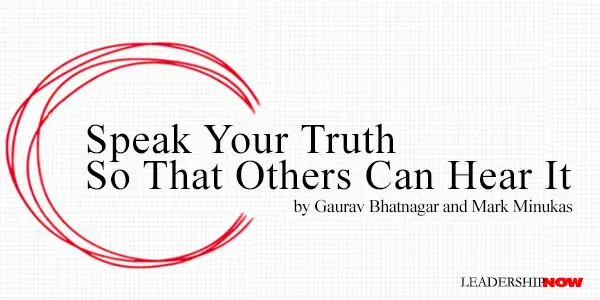
WE often live in the dilemma of sharing what’s on our mind directly and truthfully or mollifying and suppressing what we really think. This, however, is a false dichotomy. We don’t just have to share our truth in a toxic way or suppress it. The other choice is to learn to speak our truth effectively, in a way that doesn’t contribute to fear and dysfunction on a team. There are two maxims for speaking your truth effectively: own your perspective and be respectful: Own Your Perspective. The first part of speaking effectively in difficult conversations is learning to speak from a place of ownership. This might seem like a simple thing—just say what you mean!—but it goes much deeper than that. When we are truly taking ownership, we speak from a position of knowledge about what’s in our own minds and are clear about what we don’t fully know. And ultimately, there’s only one thing that we can speak directly about: our own perspective. Owning our perspective means that we acknowledge that our points of view and our interpretations are inherently limited. We don’t hold our views as absolute truth because they aren’t. To understand what we mean, we have to talk about the difference between observation and interpretation. An observation is a statement of fact, verifiable by others. Our interpretation is the meaning that we give that fact. A truly clear-minded and epistemically humble person recognizes that his or her interpretations aren’t inherently true or complete and acknowledges this in conversation. These people also recognize that they will always have more to learn about a situation. People who are misguided or fooling themselves will state their interpretation as fact and cling to it. Said differently, we tend to live as if the fictions unfolding inside our minds are really facts that are evident for everyone else to see. Clear thinking is not rejecting these fictions but seeing them for what they are—our perspective, not the perspective. To have effective difficult conversations, therefore, we must learn to separate observation from interpretation. This is harder than it sounds. Let’s have a little quiz. Which of these statements are interpretations and which are observations?
The last statement is the only observation. Every one of the other statements is an interpretation because they all have assumptions built into them. What does too long mean? What’s a great point? Who’s to say that the 10 percent growth in sales is very positive? To open a conversation with any of these statements without acknowledging that they are interpretations could lead to trouble. Communicators who take ownership of their perspective use versions of this phrase: “I observed [blank]. From that I interpreted [blank]. Is that accurate?” For example, instead of saying, “That meeting went way too long,” you can say “The meeting ended 20 minutes past schedule. When this happens, I interpret this as meaning that our team isn’t working very efficiently. How do others see it?” It might feel silly to use this language for something that seems relatively small. But it is vital to build this habit of communication so that in more pressing and stressful situations you don’t revert to a more toxic, interpretation-as-fact style in the midst of an amygdala hijack. Using this language is a powerful way to deliver a message to others without making them wrong. You’re not offering your interpretation as a statement of objective truth; you’re offering your interpretation. Given a dialogue and new information, you could very well change how you see things. Your interpretation isn’t the end of the conversation—it’s simply the starting point. Own it but hold it lightly. Stay curious, and update your interpretation as you learn more. Be Respectful. When speaking, we all have a responsibility to package our thoughts in words that can be received easily. If someone asks you what you think about a project and you say, “My interpretation is that it sucks,” you may be honest, but you’re not being respectful. This response would likely trigger an amygdala hijack in the other person, make that person defensive, and completely ruin any chance of productive communication. To be respectful, we need to share the values and concerns that have led us to the interpretation that we’ve made. In other words, we have to speak to the feelings and identity levels of the conversation. So, instead of saying that the project sucks, share what values are at stake and what concerns you have. You may value the opportunity to provide input on the project and share your thoughts openly, even if they’re not popular opinions. You may value the team and company putting time and resources into successful projects, but don’t want to see the company waste money on failing ones. In terms of concerns, you may be concerned that the team is throwing good money after bad. Or perhaps the team hasn’t applied the lessons learned from the last project that didn’t go so well. What’s important to keep in mind is that these are your values and your concerns, and they’ve led to your own interpretation. You own them. You’re not projecting a toxic interpretation of events onto other people. You’re simply expressing what’s important to you. And your interpretation is so important that you want to share it, without judgment and blame, with others. Now, when your boss asks for your opinion, you can tap into your values and concerns and share them: “Thank you for giving me the opportunity to share my views. Making sure this project is successful is important to me, and I think it’s critical that the company makes good use of limited resources. I’m concerned that this project is not on the right track, and we haven’t been able to make use of the lessons learned from the last project on this one.” This statement is honest and respectful. You say what you mean, you don’t make anybody wrong for what has happened, and you create the space for a learning dialogue. This is what difficult conversations are all about: learning to say what you mean while giving people room to say what they mean. It’s like a jazz musi-cian who learns how to play his own instrument and then makes sure to leave room for the rest of the ensemble to contribute their notes. Let the music begin. (Excerpt from Unfear: Transform Your Organization to Create Breakthrough Performance and Employee Well-Being by Gaurav Bhatnagar and Mark Minukas, McGraw Hill, November 2021)  
Posted by Michael McKinney at 11:09 AM
09.24.21

Why Content Isn’t King in Leadership Communications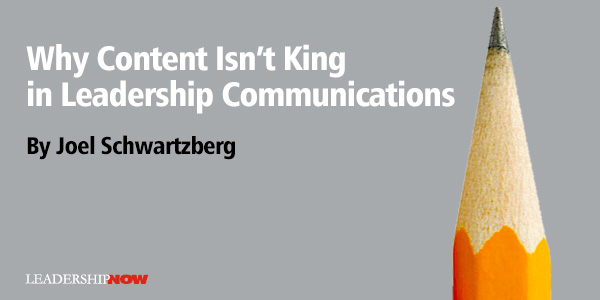
SOME of my executive clients believe, instinctively, that content is king. They maintain that “useful information” is a crucial driver of effective leadership—that their job is primarily to educate and inform their teams with facts and figures. As a result of this information-centric mindset, these leaders:
This inclination to inform may come from believing that information is inherently influential, whereas messages of inspiration are shallow and fluffy. But think back to the last time a communication inspired you. Were you inspired by long paragraphs or a memorable point? By content or commitment? By details or dedication? By a book’s table of contents or its blurb? In each of these examples, the former informs, and the latter inspires. I’m not saying information isn’t valuable. It is. Information may critically educate and enlighten. It also fills in gaps in understanding and provides essential context and updates. But while information informs, it doesn’t typically inspire. The Greatest Communicators Pair Knowledge with Inspiration Executive communication coach and author Laurie Schloff, whose clients include Bain Capital, Fidelity Investments, and Allstate, says that although many of her clients are experts in their fields, their greatest communication successes pair knowledge with inspiration. “One of my clients tended to focus on facts, research, and statistics about their product’s ingredients, which was interesting to them but overwhelming and boring to their audience of prospective customers,” Laurie told me. “With coaching, these executives shifted the focus of their communications from merely informative descriptions of their product to influential and inspiring messages about the health, well-being, and environmental impact of the product, resulting in a measurable increase in online sales.” While subject matter experts are qualified to share content, leaders have the official requirement of inspiring a team through clear and succinct expressions of hope, vision, and purpose. What might pairing information and inspiration look like in your business? Here are a few examples: “These statistics indicate where we should be focusing our efforts in the fourth quarter.”
“These three tactics will drive us toward our goal of becoming a much more diverse and inclusive organization.”
“Understanding how we got started gives us the best clues on where we should go next.”
Three Questions to Keep Your Communications on Target To ensure you’re focusing on inspiration—and not just information—in every communication, ask yourself these three questions:
Ultimately remember that you’re a leader, not simply a subject matter expert. When you focus on inspiration, not just information, you’ll find yourself engaging and inspiring your teams to follow your lead as well as your content.  
Posted by Michael McKinney at 07:48 AM
07.30.21

Raising Kids to Thrive in an Online World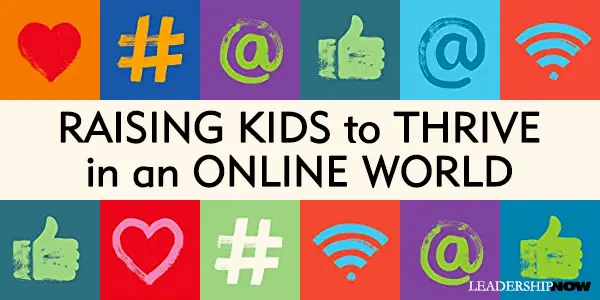
RAISING KIDS in the physical world is hard enough to get right, but now there is the added dimension of the digital world. While we spend a good deal of time preparing our kids for success in the physical world, Richard Culatta says, “we have put surprisingly little effort into making sure our kids are prepared to be safe and healthy” in the digital world. In Digital for Good: Raising Kids to Thrive in an Online World, Culatta writes that the “events that take place in the virtual world are not ancillary to their lives but are some of the most important elements in them.” For all the good the virtual world has to offer, it is also filled with wicked problems. Most of them stem from one fundamental flaw: we never took the time to establish the ground rules for meaningful participation. We have spent the last two decades excitedly finding ways to migrate all kinds of experiences to the digital world, but we haven’t stopped to ask how we will preserve our civil society as it also migrates there. For all the good the virtual world has to offer, it is also filled with wicked problems. Most of them stem from one fundamental flaw: we never took the time to establish the ground rules for meaningful participation. We have spent the last two decades excitedly finding ways to migrate all kinds of experiences to the digital world, but we haven’t stopped to ask how we will preserve our civil society as it also migrates there. With no expectation for acceptable behavior and near-complete anonymity, we have created an environment that is optimized for self-destruction. When we do try to teach our kids, our conversation about online safety is too limited, focusing on not sharing personal information, talking to digital strangers, or posting things they might regret later. We need to broaden the conversation “to articulate a broader, more meaningful vision for the use of tech to enrich our children’s lives.” And when we do have those conversations, we need to take a positive approach—not just a list of don’ts, but positive behaviors our kids can practice doing while in the digital world. Culatta, who is the CEO of the International Society for Technology in Education and the former Director of the Office of Educational Technology for the U.S. Department of Education, has developed a framework that we should use to guide our approach to teaching digital citizenship:
Using screen time as the primary factor for moderating tech takes away our children’s ability to learn to self-regulate. We want our kids to learn to move on to new activities when it is appropriate to do so, not just because a timer runs out. Change the conversation. Instead of saying you’re addicted to your phone, provide an example of a physical-world activity that isn’t getting enough priority. Culatta provides suggestions to reframe other common conversations like, “You’ve been playing that game too long,” Stop sitting around on the computer all day,” and You need to interact with real people.” And hold app reviews with your child.
Help them learn to identify useful information from junk. Emphasize asking better questions, selecting the best sources, and evaluating relevant answers. Helpful questions to ask are, “Can you validate the claims with another source?” “How old is the information?” and “Does the content us hyperbolic, alarmist, or emotional language?” Wikipedia never claimed to be a reliable source, but instead, it is a starting point to gather basic information for deeper learning journeys.
Mostly, algorithms “don’t just show us more of our same beliefs, but more extreme versions of those beliefs….It seems as if you are never ‘hard core’ enough for YouTube’s recommendation algorithm.” If we don’t prepare young people to understand how to value and respect multiple, opposing viewpoints, they may forfeit one of their greatest learning opportunities and, worse, treat people who hold opposing viewpoints disrespectfully. Of course, we have to model this in our behavior, even as outspoken individual, organizational, and governmental voices don’t.
Indexing projects “allow people worldwide to digitize important historical artifacts to make them searchable and discoverable online. There is an app that connects sighted volunteers to visually impaired people through their mobile devices. “If a blind person needs help with a particular task, say, reading the expiration date on a carton of milk or reading a phone number, they can connect with a sighted person through the app to have it read to them.” Additionally, they can help strengthen family relationships by connecting, capturing family experiences, and preserving family stories.
Culatta focuses on a positive approach that can be implemented now, even if you feel like the situation has already gotten out of hand. Young people will learn from our example. If we are to teach these positive behaviors to our children, it is assumed that we know them and practice them ourselves. All of this seems strangely helpful for adults to consider as well?!? Technology has no conscience—that’s our job. The same technologies that can solve our toughest human problems can also divide and destroy us with remarkable efficiency. 
Posted by Michael McKinney at 08:36 AM
09.14.20

Leadership is Language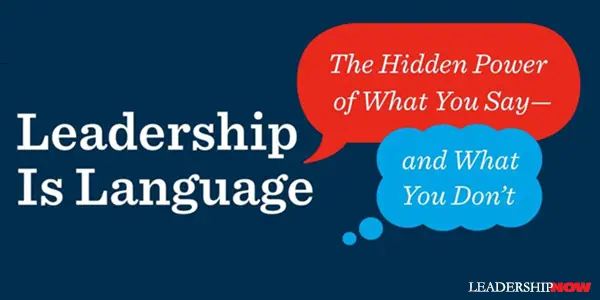
THERE was a time when it made sense to have a group that thought about the work and another group that performed the work. A manufacturing environment lends itself to this kind of structure. The thinkers and the doers. It was the most efficient way to build the momentum of the Industrial Revolution. This structure also helped to reduce variability, which is just what is called for in a manufacturing environment. When Henry Ford began to build his Model T, he didn’t need a lot of freethinkers on the assembly line. What he needed was people to consistently perform in an efficient manner. No variations. Reducing variability was the key to a great manufacturing environment. And we find that the leadership approaches and the language used aligned itself with that goal. This mindset is not only found in the manufacturing environment but just about everywhere else where humans are involved. We quite naturally like to reduce variability. But without variability, we don’t improve. We don’t innovate. We don’t grow. Today the workplace has changed. Along with the velocity of change we see around us comes the need to embrace variability just to stay relevant. We now need the people doing the work also to be thinking about the work. It is this need that David Marquet thoroughly discusses in Leadership Is Language. How we communicate with each other can help us to embrace variability and is our best shot at success. If we are not tuned into this principle, we reduce variability and risk irrelevance or even extinction. We were first introduced to Marquet and the USS Santa Fe, in Turn the Ship Around. In this account, we learn of his efforts to change his leadership approach from leader-follower or thinker-doer to a leader-leader approach that allowed for everyone to lead, think, and do. Moving from a leader-follower dynamic to a leader-leader dynamic requires a change in the way we approach and communicate with one another. This is the subject of Leadership Is Language. Arising from the thinking-doing playbook we have followed since the Industrial Revolution has been an imbalance in the rhythm between doing and thinking says Marquet. “Doing and thinking are the basic building blocks of all human activity. The correct balance of these two activities helps us achieve our goals.” He clarifies: In short, the right balance of doing and thinking drives learning. It keeps the company relevant and solvent. By doing, I mean physical interaction with the world. We need a new playbook. “We need to call the plays that will balance all that doing with more thinking at every level of the hierarchy, not just at the top.” The chart below provides some of the differences between doing, what Marquet calls Redwork, and thinking or Bluework. The key difference is “thinking benefits from embracing variability. Doing benefits from reducing variability.
Bluework sounds like this: “How do you see it? How ready are we for this? What can we do better? And What did we learn?” The Six Main Plays of the New Playbook 1. Control the Clock We are programmed to obey the clock—get it done, keep moving. Controlling the clock is the start of the redwork/bluework cycle. It is the deliberate move to exit redwork and shift to bluework. Controlling the clock is a mindful pause from all of our doing. It’s calling a time-out on ourselves to pause in order to learn, improve, and collaborate. We get there by not just calling a pause, but by making it possible. Avoid statements that erect barriers to questioning and reconsidering a decision, especially in the light of new information. To make it stick, practice doing it. Call a time-out even when no pause is needed. It may be hard for team members to call a pause because they “might be lost in redwork because of the stress of the clock.” 2. Collaborate, Not Coerce Sometimes collaboration is really an exercise in coercion. “Bosses try to be compelling, not curious. They ask leading and self-affirming questions. They suppress dissent and push for consensus. This is not collaboration. This is coercion disguised as collaboration.” “Build consensus” or “Get everyone on the same page” is another way of saying, “I’m right, and you need to change your thinking.” The solution is to let the doers be the deciders. Get their thoughts first before expressing your opinion. Instead of asking yes or no questions, ask how questions. Instead of, “Can we launch on time?” ask, “On a scale of 1 to 100, how strongly do you believe we should launch on time?” And in the face of an outlying opinion, ask, “What do you see that we don’t?” Marquet offers seven ways to ask better questions. “The point is that we do not want a ‘harmonious conversation.’ What we want is an accurate picture of reality.” He also makes a good point with “Give information, not instructions.” Very helpful. 3. Commit, Not comply If you want to keep your commitments, don’t make it about the behavior but more about who you are. Not, “I can’t,” but rather, “I don’t.” Compliance may have worked for simple, physical, repetitive, individual tasks, but it does not work for complex, cognitive, custom, team task. Compliance only gets minimum fulfillment of requirements, whereas commitment invites discretionary effort.
A way to execute this play is to focus on learning by “developing hypotheses to test rather than making decisions to execute.” This makes it easier to shift from redwork to bluework. Rather than “What are we going to do?” create a mindset of “What are we going to learn?” Instead of making a one-time decision, break it up into decision points. Make the redwork a “series of smaller increments divided by bluework decision points.” This was instructive: “Here’s the rule about the blue-red-blue cycle length: shorter periods of redwork increase learning but reduce production output, and vice versa. Therefore, in environments and under conditions of high uncertainty and unpredictability, we need to shorten redwork periods. As the product or exterior conditions become more defined, we can extend the length of the redwork.” 4. Complete, Not Continue The Industrial Age mindset is to continue—to keep on producing—nothing is ever complete. The idea was to maximize the time spent in redwork. Completion marks the end redwork. While in redwork, we benefit by having a prove mindset. However, our overall mindset guiding the redwork-bluework rhythm is on of improve. Focus on the journey, not the destination. When people think of their achievements in terms of mile markers in a journey, they are more likely to continue the behaviors that resulted in them reaching that goal. 5. Improve, Not Prove Improvement is the core purpose of bluework and is meant to improve redwork. Here we reflect, ask questions, and seek feedback. We run the improve play at the end of redwork. Now we need people to do both redwork and bluework. We are all both redworkers and blueworkers. This requires us to be able to step out of our roles as producers and look back at our production with the dispassionate eye of an improver. Marquet offers four ways to execute the Improve play. First, look forward, not backward. “What do we want to remember about this for next time?’’ Second, focus on others rather than the protection of the self. “If someone else had to take over this project, what would you say to them to make it even more successful?” Third, focus on the process and not on the people. This helps to minimize our defensiveness. “How could this be done better?” and forth, seek excellence rather than trying to avoid errors. 6. Connect, Not Conform Connect is the mindset behind all of the other plays, enabling them to work better. It is about caring— “caring what people think, caring how they feel, caring for their personal goals.” Instead of over, it is with. Connect is not a superficial “friendship” but caring for someo0ne else and wanting the best for them. Connect is love. Great takeaway here: “Never underestimate the power of fear to distort common sense in environments with a strong culture of control and compliance.” While Marquet provides ample examples from all walks of life, he concludes with specific examples of how these principles play out in the workplace. The language we use truly makes a difference. Don’t miss putting into practice the insight found here. 
Posted by Michael McKinney at 07:23 AM
05.18.20

Maintaining Social Interactions with Your Teammates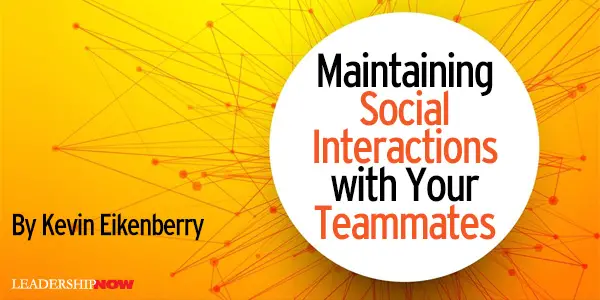
IN The Long-Distance Leader: Rules for Remarkable Remote Leadership, we included 19 Rules for remote leaders to follow. The first rule was the foundation for everything else: “Think about leadership first and location second.” The principles for successful leadership are the same, whether you are down the hall from your team, in the cubicle next to them, or they are working remotely. The practical application of leadership first, location second, is to adapt what has worked in the past to the new remote working situation. One of the big changes as we move to a remote working situation is maintaining social interaction. We’ve been asked to practice social distancing. While physical distancing has been needed, we want to promote social closeness and interaction even at a physical distance. Making this happen will require you to be intentional and creative. Replacing the Spontaneous Interaction Much of the successful social interaction at work comes from spontaneous conversations that happen throughout the day. It includes peeking your head around the corner to share a joke with someone nearby, sharing your weekend activities with a colleague while waiting for the pot of coffee to brew, and sharing a cup of coffee on a short break. Interactions like those help transform a group of individuals into a team united in reaching a common goal. When teams work remotely, however, those spontaneous conversations can no longer happen organically. Yet that social interaction is still critical to team development. How do we replace that when we are working remotely? Using Technology to Help Technology can be part of the answer. The communication platforms you are using can be used to create the same kinds of conversations we had at the office. What is required is awareness and permission. Most people think those tools are for work purposes. The fact is that the social interaction we are talking about is actually a part of the work itself! While we must value productivity, we must also let team members know it is still ok to reach out, share a joke, or just catch up. In fact, it may be more important than ever. Some Simple Examples Here are three simple examples. While you can use any or all of these, the purpose is to kickstart the creation of what will work for your team in your situation.
Use these as your starting point, not a complete list of strategies to maintain social interaction and closeness, even while you and your team are physically distancing. Share this article with your team as a way to jumpstart a conversation about what you can do as a group to stay together while working apart.  
Posted by Michael McKinney at 05:40 PM
02.07.20

The Trumpet and the French Horn: Two Styles of Communication
EFFECTIVE COMMUNICATION requires that we know how to best communicate with others. In other words, communicate with them the way they want to be communicated to. Diana Peterson-More shares two ways people like to take in information in her very practical book Consequential Communication in Turbulent Times, direct and indirect. Communication can be direct and straightforward, which often entails using the “w” words: “What do you think? What would you like me to do? What’s your answer? Why should we do it that way? Why her not me? Why not do it this way?” or “Which direction should we take?” To illustrate this concept, she introduces trumpets and French horns: For those who like the straightforward style of communication, let’s call them trumpets. The thoughts go straight from the brain to the mouth in an immediate exhale/response. “W” questions typically work with trumpets. 
Posted by Michael McKinney at 10:27 AM
09.13.19

The 10 Stories Great Leaders Need to Tell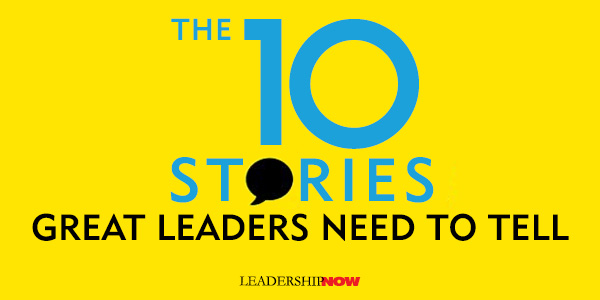
WE KNOW GREAT STORIES are the foundation of great communication. It’s not the idea but the story about the idea that begets followers. The question is, are you telling the right story? A leading expert in organizational storytelling, Paul Smith advises us that more important than how we tell a story is what story we are telling. And by story, he means “a narrative about something that happened to someone.” As such, it will include a time, a place, and a main character. That main character will have a goal, and there will probably be an obstacle getting in the way of that goal—a villain, if you will. And there will be events that transpire along the way that hopefully resolve themselves in the end. On the pages of The 10 Stories Great Leaders Tell—a book designed to be read in about an hour—Paul Smith reveals the ten most important stories a leader needs to tell and how to begin to craft our own unique story. Each story has a specific objective. These stories tell us why. The first four stories are about setting the direction for the organization: Story 1: Where We Came From (A Founding Story)
Story 2: Why We Can’t Stay Here (A Case-for-Change Story)
Story 3: Where We’re Going (A Vision Story)
Story 4: How We’re Going to Get There (A Strategy Story)
The next four stories are about who we are as an organization: Story 5: What We Believe (A Corporate-Values Story)
Story 6: Who We Serve (A Customer Story)
Story 7: What We Do for Our Customers (A Sales Story)
Story 8: How We’re Different from Our Competitors (A Marketing Story)
The last two are about you as a leader: Story 9: Why I Lead the Way I Do (A Leadership-Philosophy Story)
Story 10: Why You Should Want to Work Here (A Recruiting Story)
Smith has also produced a workbook to accompany this book to help you begin to tell the stories you need to be telling. Good examples accompany each of the ten stories. In conclusion, Smith offers an outline in the form of eight questions to help you to organize and structure the ideas and stories you have collected. Equipped with stories like these, you will become a more effective leader. 
Posted by Michael McKinney at 12:44 AM
01.07.19

What’s Your Story?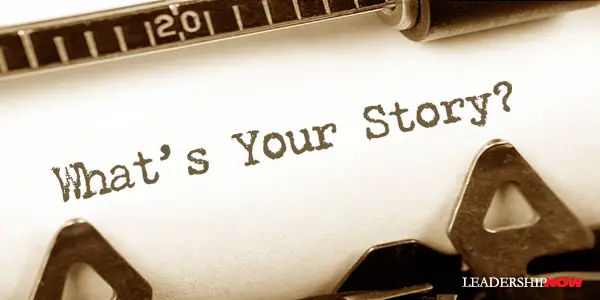
WHAT GREAT LEADERS have in common is their ability to communicate and create meaning from their words. Much of that ability speaks to the ability to listen and read between the lines to develop an understanding with those you lead. Great stories begin with great listening. From there, you can learn how to connect your perspective to theirs. Leaders are in a different place from those they lead. A story that is large enough that it aligns with their values inspires them to make the journey to where you are. This is especially important today when ironically, our ability to communicate in a meaningful way is deteriorating. The structures we used to have to develop that skill are diminished. Bursts of thought do not help to create the empathy we need to function effectively as a civilization. We don’t connect in bursts of thought but in shared stories. A good story can set the tone for a deeper connection and empathy for another’s perspective. In a September 2018 interview with Fast Company magazine, Doris Kearns Goodwin talks about her book, Leadership: In Turbulent Times, and the ability of the four presidents she delved into to communicate through stories. Each of the presidents she portrays could help their audience see themselves in the future they were describing. A well-crafted story has the power to give the audience ownership of the idea that is woven into the story. Goodwin is asked, “What’s the most important lesson that business leaders can take from these presidents?” If I were to pick one, it would be the ability to speak to audiences with stories. [Take] Abraham Lincoln: While we celebrate his beautiful language, his speeches really worked because they were filled with stories and illustrations. He believed people remembered anecdotes better than facts and figures. When he was young, he would listen as his father, and the people who would come by his little log cabin told stories. He’d go to bed at night and try to translate those stories into [his] words, so he could then go out on the field the next day, stand on a tree stump—he’s like eight, nine years old—and entertain his friends. Goodwin adds this about Theodore Roosevelt’s ability to relate—even today: What really interests me is thinking about which of these [presidents] would give a speech that would be relevant today. It would probably be Teddy Roosevelt. Think about where we were at the turn of the 20th century: The industrial revolution had shaken up the economy, immigrants were pouring in, cities were replacing towns. A gap was developing between the rich and the poor, and the social landscape was changing because of all these new inventions: the automobile, the telegraph, and the telephone. You had populist movements that called for restrictions on immigration, and the establishment worried about [giving] power to ordinary people. Ryan Matthews and Watts Wacker begin their book, What’s Your Story? with this observation: “Long before the first formal business was established, before the first deal, the six most powerful words in any language were Let me tell you a story. What’s your story?
Posted by Michael McKinney at 12:03 AM
12.27.18

Five Problems with Virtual Communication & What to Do About It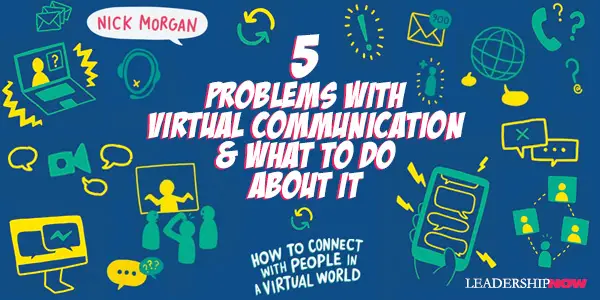
EVEN THOUGH WE have entered a new world of virtual communications, we still communicate in real-world ways that don’t always work in the virtual world. We’ve all sent an email or a text where we meant one thing and the recipient took it in a completely different way. They never saw the smile on our face, the touch of our hand, or the look of concern. There were none of the emotions that we take for granted in the real-world to guide them in the virtual world to a proper conclusion. We need new approaches and to become more conscious of what we are doing. We need to sharpen our communication skills in the digital world. We have to put the emotion back. Nick Morgan is here to do just that in Can You Hear Me? Nick Morgan is a master communicator and speech coach. And this book reflects that. His website Public Words is one of my favorite. The focus is public speaking, but the principles apply in most contexts including one-on-one conversations. Don’t miss it. The world of communication in the real-world and virtual world are very different with different dynamics. The same rules don’t apply. This leads to five major problems with virtual communication that need to be addressed. Problem One: The Lack of Feedback In the real world, there are two kinds of feedback: implicit and explicit. Implicit feedback is all of the non-verbal sounds, facial expressions, touches and body language that goes with conversation. Explicit feedback is the straightforward, unvarnished communication we get from others. In the real world, there is a mix of the two. But in the virtual world, implicit communication is almost nonexistent. In the real world, implicit and explicit work together to toughen the soft messages and soften the harsh messages. When we remove the implicit feedback from our communication, it’s little wonder we have misunderstandings, confusion, and often hurt feelings. (Emoji were introduced to help with this problem, but I find on important communications, an emoji doesn’t really convey the feelings behind our words.) Morgan says what has changed online is the nature of trust. “Trust in the virtual world is much more fragile, though perhaps easier to establish initially. But the big difference comes when something threatens the trust.” He explains: And feedback depends on trust. In face-to-face relationships where there is trust, one party may do something to screw up, causing friction, anger, and even a bit of mistrust to creep in. But if the connection is strong enough, the feedback begins. The issue will get thrashed out, the perpetrator will apologize, and trust will be restored. Indeed, once restored, the trust may be stronger than ever. Here are a few of Morgan’s suggestions to offer effective feedback in a virtual world: Virtual feedback should be appropriate and honest, but it doesn’t need to be cruel. “Leaven clarity with kindness.” Virtual feedback should be specific and focused on the relevant object, performance, or creation and not on the person. “A failed artistic performance doesn’t entitle you to judge the character of the performer. And general comments are far less useful—and far more damaging—than specific ones.” Virtual feedback should never be more about the giver than the recipient. We have all frequently seen where the feedback given “really concerns what the giver knows at some deep level to be the problem with his or her own work. If you’re going to offer feedback, you have to have enough security, distance, and impartiality to deliver an opinion that is truly helpful.” Problem Two: The Lack of Empathy Our virtual world robs us of real closeness and intimacy. “The distance provided by a virtual connection creates conditions where people are much more likely to behave badly to one another and are much less likely to be sympathetic to other’s feelings. There’s a lack of empathy.” When we are face-to-face, even the coldest of us find our mirror neurons firing when we are with someone who is experiencing an emotion. We laugh together, cry together, bond together. Put us in the virtual space, and empathy can’t work as well. The mirror neurons don’t fare as readily. We remain disassociated. The key lesson regarding empathy: “If you can possibly begin a relationship of any importance in person, you should do so. Period, full stop, end of discussion.” If you can’t, “do everything you can, especially early on, to be consistent, trustworthy, and transparent. In a virtual world, our stories are more important than ever. “Your online presence needs to meet four criteria: authenticity, clarity, comprehensiveness, and consistency.” Problem Three: The Lack of Control The virtual world is unforgiving. Online, “we hold others to rigid standards of behavior and are much less forgiving. In virtual space, this double standard is particularly compelling. If you behave badly, it’s because you’re a troll, and your mother and her mother before you, back a thousand generations. These feelings are not logical, but such is the nature of virtual relationships. Lacking emotional depth, we substitute brittle, intellectual, standards.” We don’t have control over what others say about us and others. And we rarely forgive inconsistent online behavior. So we need to be intentional about who we are and be consistent with that image. Decide now who you will be. Take control of your online life by creating a personal values statement. As an example of the kind of transparency, control and consistency Morgan is talking about, is Chris Palmer. Palmer is an environmental filmmaker with a personal mission statement (which you can find at the bottom of this page) he published on his website. Palmer told Morgan that publishing it “has transformed my life. I use it to guide my daily activities. Instead of confusion, I have clarity. Instead of feeling overwhelmed, I feel in control. Instead of ennui, I have purpose.” How do people see you online? What do you stand for? How could a personal mission statement guide your interactions online? Problem Four: The Lack of Emotion The emotions that come naturally in face-to-face communications is almost nonexistent in virtual communications. “Every face-to-face communication is two simultaneous conversations: the content (what you say) and the body language (how you say it).” Both are essential and very different. And when we take the emotion out we get bored, nasty or both. We are wired to make an emotional connection with others. Emotions are a vital part of our communications, and we base our decisions on emotion. “And removing that natural, easy, unconscious emotional data stream, as virtual communication does surprisingly well, is particularly crippling.” The virtual space we’ve created is uniquely set up to make it difficult for us to conduct our human business in the way that we’ve done for thousands of years. We think we’ve created something convenient, cost-effective, and efficient. Instead, we’ve created something that this stultifying, expensive in terms of emotions and decision-making, and wildly inefficient. Because of this, we need to consciously create tools that replace the unconscious connection tools we have in the real world. This would include becoming “exceedingly conscious about taking turns and allowing others to do so” and signaling that you are nearly ready to stop talking. Mediating conversations becomes more important. Morgan also suggests ways to add a three-stage “temperature” check to your conference calls. Problem Five: The Lack of Connection and Commitment Virtual communications aren’t as satisfying and emotionally compelling as our real-world interactions. Take the emotions out and we feel alone. We need to create engaging approaches that combine both the virtual and real-world behavior that leads to commitment in the end. Research Lynn Wu of Wharton found that the “more that individuals used social words in their chat with colleagues, like ‘coffee,’ ‘lunch,’ or ‘football,’ the less likely they were to be laid off.” Of course, these online tools can be misused, so balance is required. Nevertheless, connection with others and job security are closely tied. A few ways to create commitment in the real-world work well online. People look to others for cues, so use social validation to push people toward commitment. Remember the golden rule of reciprocity. A “strong feeling of cooperation allows people to connect, commit, and support each other.” Always be consistent. Look for similarity. “Similarity builds rapport.” Tell stories. “The best way to get and hold someone’s attention is to tell a story.” In part two of his book, Morgan provides specific techniques for various digital channels of communication: email, texting, conference calls, webinars, chat sessions, and sales efforts. All contain helpful advice to avoid misunderstandings. Our virtual relationships are more fragile and “these weaker ties mean we inhabit a more toxic world. The research shows that negative conversations stay with us longer than do positive ones because of how we metabolize oxytocin and cortisol differently.” In the real world, we let our unconscious minds do the heavy lifting—and pick up on those implicit messages. In the virtual world, we don’t have that luxury. My journey into the online world to understand the virtual communicator has led me to understand how profoundly inhuman many ways of virtual communication are. Our very human job now is to learn to put the emotional and memorable back into this attenuated world that has sprung up around us. 
Posted by Michael McKinney at 09:31 PM
08.03.18

The Communication Secrets to Get from Good to Great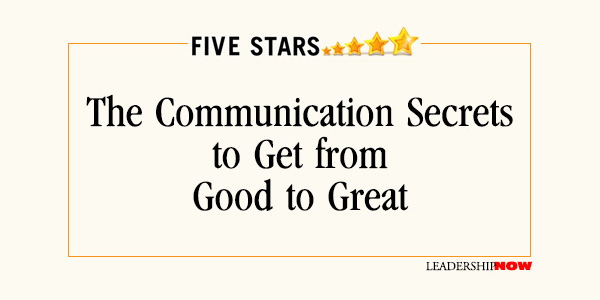
N The thing to keep in mind is that machines are machines and we are human. And if you are reading this, that’s your advantage. Specifically, your edge if your ability to communicate in imaginative ways, in a way that develops empathy with your listeners. Your ability to persuade and tell a story. In Five Stars, Carmine Gallo states that “your ability to communicate persuasively is the single greatest skill that will set you apart in the next decade.” Here’s the problem: finding people with the ability to communicate clearly and persuasively are “notoriously hard to find.” Aristotle gave us the foundation of good communication skills. The purpose of good communication was to encourage both the speaker and the listener to flourish. To this end, the speaker had to articulate the theme of the argument and then prove that their argument is both solid and logical. But a good argument moves us not on logic alone, but it also requires, Ethos (trust, wisdom, goodwill, or the character of the speaker) and Pathos (emotional appeal). Dr. Paul Zak says, “A compelling story with an emotional trigger alters our brain chemistry, making us more trusting, understanding, and open to ideas.” Geoff Ralston, a partner at seed accelerator Y Combinator, told Gallo: “I have to tell a story that is compelling enough for you to be a part of my story because I’ve created a change, something new and something interesting. And that narrative is something I want you to be a part of. That is how humans have created our civilization.” Gallo gives us example after example of how men and women have moved us through storytelling, by weaving a theme with logic, wisdom, and emotion. People like Neil deGrasse Tyson, Katelyn Gleason, Richard Branson, Richard Turere, Bryan Stevenson, and a host of others. Here are some takeaways: “Communication is more important than ever because we’re asking physicists, social scientists, biologists, to work together. In the past, they would work alone on individual projects and keep to their own discipline. –Anders Sahlman In 2012 Google began a three-year study called Project Aristotle to identify the habits of the most effective teams. They found that who was on the team matted less than how the team members interacted with each other. “Many meetings at Google now start with sharing stories and experiences—the emotional component of team building that bonds people together.” Next Gallo turns his attention to how we get from good or average to great—five star—communicators. He provides many ideas and examples but here are some key thoughts: Stories build an emotional connection with your audience. Create a signature story—a story unique to you and your brand. Brad Stone believes that “today’s upstarts have a critical skill that separates them from the previous generation of entrepreneurs—they can tell better stories.” Stories should be structured in three parts: The set-up (the trigger), the conflict (when all seems lost), and the resolution. Include details, a surprise, and empathetic characters. Stick to simple words and phrases. Think eight-grade readability. Simple takes a lot of work. “Great communicators make their work look effortless because they put a lot of effort into making it work.” Use analogies and metaphors. “To be a master of metaphor is the greatest thing by far…it is also a sign of genius,” wrote Aristotle. A former speechwriter to Bill Clinton, John Pollack wrote, “In many arguments, whoever has the best analogy wins.” Gallo says, “Persuasion cannot exist in the absence of analogy. Analogies force people out of conventional thinking. When an idea or a concept is truly different from what comes before, unconventional thinking is required to sell it.” Connect ideas from everywhere. Creative geniuses are not geniuses “because they are smarter; they are geniuses because they’re open to connecting ideas from different fields.” Gallo also covers how to deal with the fear of public speaking. “Neuroscientists have identified two techniques that will help you shine when the pressure is on: reappraisal and repetition. Reappraisal simply means reframing the way you think about yourself and the events in your life. Turning thoughts from negative to positive is the key to winning. Once you’ve transformed your thoughts, you have to put in practice time. Repeating a presentation over and over will boost your confidence for the big day.” There is so much in this book that will help you perform better in all of your communication. If only read one book on communication this year, read Five Stars by Carmine Gallo. 
Posted by Michael McKinney at 10:58 AM
01.24.18

The Power of Vulnerability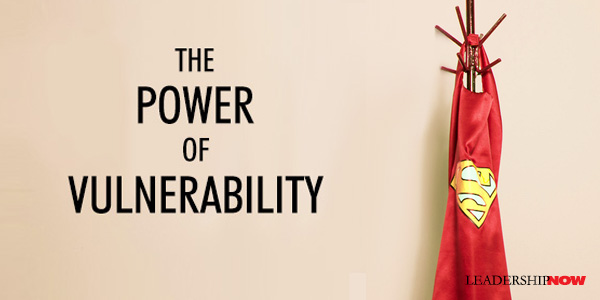
H In The Power of Vulnerability, Barry Kaplan and Jeffrey Manchester explain that the secret to unleashing the power of leaders, teams, and organizations, is through vulnerability. The more that leaders open their hearts, reveal their fears and show their authentic selves, the deeper the connections among team members will be, and the more the team will achieve. Part of what makes it work is that when we get behind the façades that we habitually put up, we begin to understand others better—their motivations, values, and beliefs. As we better understand what is going on inside of us, we will better understand what is going on inside of others and take their comments and behaviors less personally. We will begin to understand their points of view more completely. It generates respect and a willingness to share points of view that can strengthen the group as a whole. You don’t begin this journey to authenticity and vulnerability by giving away the store. There are real and imagined risks. Some environments carry more risk than others. “Imagine that there is a continuum of risk, on one end of the spectrum is where you shut down completely, and at the other end, you are wide open. You stand somewhere along that continuum as you subjectivity determine what’s what. That’s your spot of safety, where your internal risk manager allows you to play.” To take the first step, “you’ll need to get permission from your internal risk manager to take a small step, say to stretch just 10 percent, in showing vulnerability.” If you don’t believe it’s safe enough for you to share your opinions, you are not going to. Yet because you have clarity about what you want, you can now imagine the relational and team dynamics to ensure that you can express yourself more fully. Because you have clarity about your need to create safety, it’s already safer. As you also make it safe for others to show their vulnerabilities, it will become safer for you. Creating a safe space for others involves: 1. Getting Present: Set aside distractions. While you may feel safe in being disconnected, “if you’re going to be more open and vulnerable and show up in your power, then you must first shift from disconnection to the intentional practice of connection.” The authors suggest checking yourself mentally, emotionally, physically and spiritually. Where are you right now through these four energy centers? 2. Understanding and Committing to Guidelines and a Protocol for How We Are Going to Connect: For example, everyone commits to respect confidentiality, being present in the moment, staying when times get tough, speaking the truth, asking for what you want, owning your judgments and feelings, actively listening, and asking permission before offering feedback or advice. 3. Using the “Clearing and Resolution Model:” Clear the elephants in the room so that “everyone can be aligned with themselves and the people they work with.” There is a process of clearing that asks five questions; What are the facts? What are your perspectives? What are you feeling? What was your role in attracting the issue to you? What do you want specifically? 4. Completing Exercises to Take Steps Toward Authenticity: Break the ice with an exercise like everyone sharing a bit of themselves to get you to move out of your head to opening up emotionally to become more present. Create shared experiences. “The weekly or monthly meetings don’t count because the primary focus in those sessions is on the business of the company. Additional investment on a quarterly, semi-annual, and, at a minimum, annual offsite is required to help continue the momentum of trust and connection that has been established.” 5. Anchoring and Integrating the Process: Create a rhythm by creating rituals that serve to maintain the connection you’ve established. The heart of authenticity is connection. It has to be a conscious choice practiced over and over.
Begin the journey by practicing vulnerability in the hope that others on your team will really see you and seek a version of the journey for themselves. And hang up the cape.

Posted by Michael McKinney at 10:50 AM
01.04.18

You Unplugged: Prepare to be Spontaneous
M Judith Humphrey writes in Impromptu: Leading in the Moment, that “you must prepare to be spontaneous.” Because we don’t, it’s “not surprising that our daily conversations are often not geared to leadership and our encounters can be less than inspiring.” Interestingly, while the word impromptu is defined as “made or done without previous preparation,” it comes from the Latin in promptu that means “in readiness” or “prepared.” Not surprisingly, jazz musician and professor Stephen Asma wrote in a New York Times opinion piece, “The key to successful improvisation is getting your self out of the way. Usually, the ego tries to coordinate everything, but good improvisers dial down the ego and let the embodied system act, play and respond with reduced ego supervision.” He also states that “the ability to improvise is not just ‘winging it.’ It is built on foundations of study and practice that prepare the improviser for the moment of action.” When visitors lined the streets the night before his famous Gettysburg Address and asked Abraham Lincoln to say a few words, he responded by saying, “I appear before you, fellow-citizens, merely to thank you for this compliment. … I have no speech to make. In my position, it is somewhat important that I should not say any foolish things. The key to influential or leaderful impromptu communication is the right mindset. To be ready for that “moment of action” as Asma put it, Humphrey says the right mindset includes having the intention to lead, being a good listener, and being authentic, focused, and respectful.” To lay the groundwork for impromptu speaking, it is important that you know what you are talking about. You also need to keep your key leadership messages in mind. Your messages should support what you are about. “Whatever your organization, or team, or mission, write down your key message and supporting messages. Burn them in your mind, so you can draw upon them every time you speak. They will be the foundation of your many impromptu scripts.” Humphrey has developed a 4-part scripting template that can be adapted (expanded or contracted) to fit any situation. It is helpful for organizing your thoughts.  First, is the Grabber. This bridge to your audience can be a friendly greeting, reference to a previous discussion, or a segue from someone’s point. Your grabber should not only engage your audience, but it should also bridge to your message. Second, is your Message. This is your point. It is the heart of your impromptu script. It is one idea, engaging, and positive. Third, is the Structure. Create a compelling case for your message with clear, persuasive arguments. Fourth, is the Call to Action. Show how your message can be acted upon. It can be a handoff, or request a decision, give concrete steps, encourage, convey an ultimatum, or inspire collaboration. It motivates. Humphrey’s provides examples of how this can be used in various situations including how it can be expanded and contracted depending on the situation and timing constraints. Malcolm Gladwell explains in Blink that “Improve isn’t random and chaotic at all. It is an art form governed by a series of rules, and [actors] want to make sure that when they’re up onstage, everyone abides by those rules.” “Impromptu speaking,” explains Humphrey’s, “requires the same discipline that the best improvisational actors and jazz musicians use. It, too, is built on a set of rules as well as practice.” Be prepared to lead in any impromptu moment. 
Posted by Michael McKinney at 03:35 PM
12.15.17

Pass Judgment
P We learned this the hard way in NASA Mission Control’s management team. What started as a top executive trusting his senior managers to run their divisions rather than discussing challenges or weak performance in front of their peers, evolved into an expectation to keep your criticisms of the other divisions to yourself. Over time, this evolved even further to not even mentioning any significant issues or challenges in management meetings. The management team mantra became, “No ripples in the pond.” While this led to polite, non-confrontational, and seemingly collegial meetings, it also meant an ever-growing list of cost, schedule, and technical problems that were not being addressed or even on the radar screen of the senior management team running our $650-million/year enterprise. True to the stereotype of government organizations, we had become known as a “marching army” who cost way too much and still did things the way we had for almost 50 years. Our customer program managers were seeking to abandon us and find any other team to turn their spacecraft over to because they had lost faith in our ability to control costs, even though they still considered us to be the best operations team on the planet. Worst of all, most of their criticisms were well founded, and we had become culturally incapable of discussing and doing anything about them as a management team thanks to “no ripples in the pond.” Judgment Can Set an Organization Free Then we looked outside our walls by benchmarking operations teams in several different industries, in both the government and the private sector. We were shocked to find example after example of teams who not only were better than us but also made us look like amateurs in some areas, including some that we considered core competencies. That was the game changer we needed. From that realization, we knew we had to put the “ripples in the pond” and discuss where the organization’s performance was lacking. Choosing otherwise meant that instead of being part of the solution, we were the problem. We started passing judgment rather than hiding from it. We identified management practices that were contributing to our decline and those that we needed to change or implement to improve. The goal then became intentionally performing at the highest level, which we all knew was the intended standard of our high-performing organization all along. We weren’t making personal judgments about each other, but we became adamant in holding each other accountable to this transparent, value-driven, fully engaged style of managing. It set the tone for every discussion whether the decisions entailed our technical work, strategic risk, business management, personnel development, or any subject. Over time, it became a natural part of doing business. We completely upended “no ripples in the pond” with a formal policy of “clarity over diplomacy.” Rather than getting in our way, this level of candor and on-going judgment increased the trust across the team. This genuine and open collegiality also led us to management practices and business strategies we otherwise could not have developed without the talent and experience from across the full management team. As just one measure for how that affected organizational performance, in the course of two years we were able to reduce total costs to our customers by half while performing the same work and still delivering the expected high-quality support. Judgment Can Enable Personal Growth Learning to pass judgment about team behaviors is one thing, doing the same individually can still be a challenge. A respected senior executive once told me, “Nobody’s any better or worse, really. They’re all about the same talent level. There’s nothing you can really do as a manager to change that.” In practice, this individual version of “no ripples in the pond” feels nice because it avoids the discomfort that can accompany passing judgment. But it also keeps us stuck, because, of course, we are not all the same. We all have different strengths and different weaknesses, and top performance requires us to first understand both. In the same way that benchmarking helped our management team, personality assessments (Myers-Briggs, Birkman, DISC, etc), feedback, and executive coaching are all great tools for gaining insights into our individual strengths, weaknesses, and how we affect others because of them. With that awareness, we can then make judgments about which of our behaviors help the organization be successful and which get in the way. Rather than being critical, these judgments are aligned to the team’s success, and with them, we can choose to deliberately improve. See The Ripples in the Pond The ripples are already in the pond in everything we do. The question is: Are we willing to acknowledge them and proactively do something about them? High-performing teams and individuals do not ignore the ripples in the pond – the indicators of problems that could erode success and lead to failure. They learn to see them and do something about them. That requires passing judgment, but this isn’t about judging individual worth. It is about judging our behaviors and how well aligned they are to the team’s success. With that understanding, critical judgment becomes less threatening, and the actions required to improve likewise become easier to identify and implement. From those judgments, the highest performing teams are able to harness the strengths from across the team, while also working around or improving each of our individual weak areas. They are then best equipped to handle challenges and identify opportunities. That’s leading.    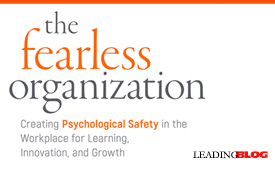
Posted by Michael McKinney at 07:19 AM
08.03.17

How to Work with People You Don’t Agree with or Like or Trust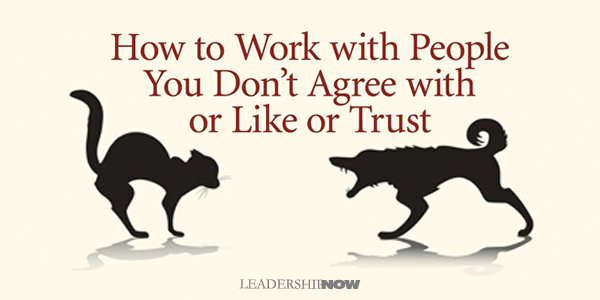
I Faced with our country’s overwhelming problems, we have two options: a practical option and a miraculous option. The practical option is for all of us to get down on our knees and pray for a band of angels to come down from heaven and solve our problems for us. The miraculous option is that we work things through together. If we (and they) choose to collaborate, how do you work with people you don’t trust, who have incompatible agendas, and histories of dislike? What do you do when you need to come together to solve a problem but they can’t see it your way? Part of the issue is we come into the collaboration with the idea that we can control the process; we can get people to make the changes we need them to make. When a situation with others becomes hopeless or dire, we double-down and try to find a way to convince them, even force them to change in order to bring them into alignment with our thinking. Underlying this approach is the belief that I/we know what is best and it is my duty to make them change for their own good. When faced with others different from us we tend to label them as enemies. We demonize and vilify them. Call them names even. Our enemfying, which feels exciting and satisfying, even righteous and heroic, usually obscures rather than clarifies he reality of the challenges we face. It amplifies conflicts; it narrows the space for problem solving and creativity; and it distracts us, with unrealizable dreams of decisive victory, from the real work we need to do. We need a better approach and mindset. Kahane introduces an idea called stretch collaboration. We need to shift our thinking in three ways: The first shift is instead of focusing on a narrow focus over the good and harmony of the team, we should embrace the conflict and connection within and beyond the team. In short, we have to affirm the legitimacy of every perspective of the group. Each participant brings a perspective that they care about and by acknowledging all we can form a more complete picture. The second shift deals with the process. Instead of insisting on one right view of the problem, the solution, and the plan, we need to move toward experimenting systematically with different perspectives and possibilities. We learn together. We think through the issues and solutions together to see what could work. The idea is to cocreate new options as we—together—work through the issues. The final shift requires us to see ourselves as part of the whole and as one orchestrating the collaboration. We are a participant as much as everyone else. We tend to overlook ourselves as part of the problem. Bill Tobert once told Kahane that “if you’re not part of the problem, then you cannot be part of the solution.” Ego is always an issue. “When we are faced with a challenging situation, we focus our attention first and foremost on what other people are doing or not doing or out to be doing.” Kahane adds, “Blaming others is a common and lazy way to avoid doing our own work.” These shifts require us to move outside ourselves. “Self-centeredness means that we arrogantly overestimate the correctness and value of our own perspectives and actions, and we underestimate those of others.” Keep in mind, “Your enemies can be your greatest teachers.” 
Posted by Michael McKinney at 12:57 PM
04.14.17

Conflict without Casualties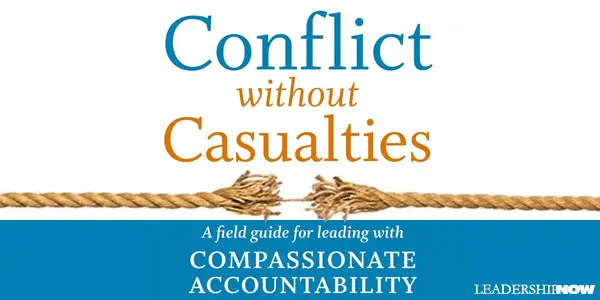
C Conflict is energy, and can be used in positive or negative ways. Negative conflict becomes drama, and it is costly to companies, teams and relationships at all levels. In fact, according to a Gallup Poll, negative conflict drains the U.S. economy by about $350 billion a year in lost productivity and wasted energy. In Conflict without Casualties, author Nate Regier believes that the misuse of conflict energy is the biggest crisis facing our world, and that we haven’t even begun to harness the creative potential of conflict. When people embrace the fullest meaning of compassion as a process of “struggling with” others in creative conflict, they can transform lives, companies, and the world. It is understandable that we try to avoid conflict considering all of the drama and negative fallout that always seems to accompany it. But Regier says if we use conflict correctly, we can use it to create. “Eliminating the casualties of conflict cannot happen by repressing the conflict and just ‘being nice.’ It happens by stewarding the energy inherent in conflict to make something positive, even amazing.” That seems like a tall order, but it makes sense. Compassionate Accountability The way forward is to practice Compassionate Accountability. Compassionate Accountability is a method for resisting the negative pull of drama—“I gotta win.” Negative conflict becomes drama. “Drama is the mismanaging of the energy of conflict. It diverts energy towards the pursuit of self-justification, one of the strongest human urges and the one that almost always gets us into trouble.” (Chapter 2 on drama is one of the clearest discussions of drama I’ve read.) To be compassionate is to struggle alongside with others; to struggle with instead of against. “Compassion is the result of people taking ownership of their feelings, thoughts and behaviors, and choosing to spend the energy of conflict pursuing effective solutions that preserve the dignity of all involved. Compassion is more than care and concern for others. It’s about the willingness to get in the trenches and struggle together as an equal with others.”
Openness
Resourcefulness
Persistence
These three skills are a process that starts at Open, moves to Resourceful, and finally to Persistence. They are three interdependent ways of feeling, thinking, and acting that work productively together. When Regier’s model is placed inside the Drama Triangle (developed by Steven Karpman), the author creates a useful visual for understanding where we often end up if we don’t intentionally stay the Compassionate Accountability course. Regier writes: “Drama inevitably pushes us into corners, where we cling to distorted worldviews that compel us to do the same thing over and over, expecting different results. Compassion, on the other hand, keeps us moving, searching, nimble, effective, and capable of adapting to change.” It also keep us from being mired inside our own head and thus limiting our responses and our ability to reframe the conflict. We get stuck. 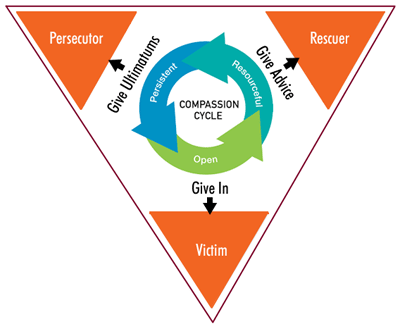 It would seem that if you stop at Persistence then you become stagnant and eventually irrelevant. A state of non-judgmental receptivity would seem to go hand-in-hand with progress, the inevitability of change, and the understanding of others. “As a species, human beings seem to have a very difficult time returning to Openness in order to keep the cycle going. We take up residence at Persistence, which inevitably morphs into Persecutor as we fight to protect what we’ve built and save ourselves from the consequences of our own creation.” He adds, “Each point on the Compassion Cycle has a purpose. When that purpose is fulfilled, it’s time to move. Lingering after the purpose has been achieved is a recipe for stagnation and drama.” If you want to end the drama in your life or organization then you have to replace it with something else. Compassionate Accountability is the cure. Regier concludes the book with a section devoted to implementing this concept into everything you do. A very useful user’s manual. 
Posted by Michael McKinney at 06:01 PM
12.11.15

Are You Trading Influence for Attention?
PEGGY NOONAN brought up some great thoughts in her editorial, A Rash Leader in a Grave Time that would be good for us to consider in any time. She was referring to the presidential campaign of Donald Trump, but too frequently we see the tendency of leaders in all walks of life, to use their “mouth as a blunt instrument” whenever they feel they are in the right, have a just cause, want to get attention, or simply want to put their foot down. Their comments may not be as flamboyant as Donald Trump’s, but they are just as dismissive. Some people find that to be an admirable quality in a leader, until of course, they don’t. When the leader steps on their toes, then the undisciplined rhetoric comes across as contemptuous. Noonan says that the problem arises when a leader “doesn’t think it through, doesn’t anticipate legitimate pushback, doesn’t try to persuade, only declares.” It is disrespectful and shows a lack of self- and situational-awareness on the part of the leader. 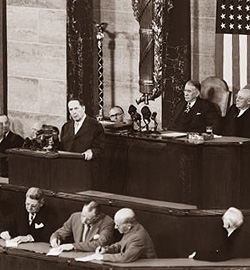 She uses the word politesse in this regard. In a time when grabbing attention is more important than civility, politesse it not a practical value. Taking the time to be civil or polite and to polish our words is a luxury we can’t afford or we may miss adding our voice to what’s trending. The pressure to respond doesn’t often leave us the time to be thoughtful, measured, and disciplined on our approach. We have to fight the forces that would intimidate us. That doesn’t mean we can’t be remarkable in our speech. Noonan encourages, “It is possible for candidates to be vivid but careful, dramatic but responsible.” Politesse is a word that implies sacrifice which is at the core of good leadership. Sometimes we have to sacrifice our raw emotions for disciplined thought; our efficient bluntness for long-term understanding.
Posted by Michael McKinney at 03:11 PM
08.12.14

Designing Moments of Impact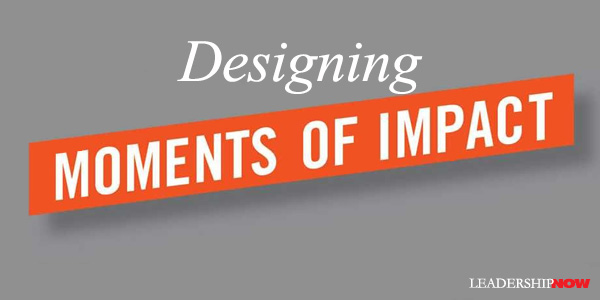 IN A WORLD of adaptive challenges—messy, open-ended, and ill-defined—your garden variety meeting isn’t going to cut it. What you need is a strategic conversation. But these kinds of conversations don’t just happen—they need to be designed.
IN A WORLD of adaptive challenges—messy, open-ended, and ill-defined—your garden variety meeting isn’t going to cut it. What you need is a strategic conversation. But these kinds of conversations don’t just happen—they need to be designed.
Moments of Impact by Chris Ertel and Lisa Kay Solomon will help you to do just that. A moment of impact is created at the intersection of design, strategy and conversation. Pierre Wack described the challenge as: It happens when your message reaches the microcosms [mental models] of decision makers, obliges them to question their assumptions about how their business world works, and leads them to change and reorganize their inner models of reality. Mental models matter. The real challenge is “not to find the right answer to an adaptive challenge but rather to help shape people’s perceptions of the problem—and thus of potential solutions.” 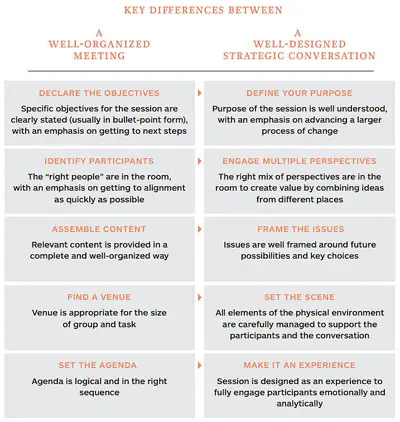 Here are the five core principles for designing strategic conversations:
Moments of Impact is really two books in one. Included is a comprehensive 60-page Starter Kit. It’s a collection of tools and tips that will help you start designing strategic conversations. Well worth the price of the book alone. 
Posted by Michael McKinney at 10:58 PM
04.04.14

Five Ways to Reduce Conflict When There Are No Right Answers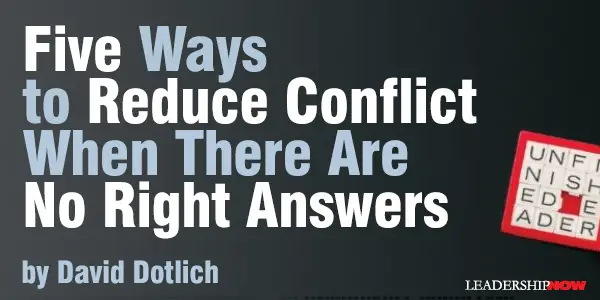
TO be a leader today in almost any organization means you are daily, if not hourly, bombarded with problems and challenges that don’t have clear-cut “right” answers. Or, even more confounding, there are many “right” answers, depending on your perspective. Such challenges include meeting contradictory needs (for example, tending to your “stars” while building the team as a whole), delivering quarterly results while investing for the future, maintaining consistent standards and policies while accommodating unique customer requirements, or staying focused on results while adhering to your company’s purpose and values. The list goes on and on. In the face of these complex contradictions, many leaders choose to deny them and just “get the job done.” But like Marley’s ghost, unresolved and unacknowledged issues keep reappearing. And as leaders ignore or deny them, conflicts begin to emerge, positions solidify, and resolution becomes increasingly difficult. Just to be clear: I am not talking about conflict as it refers to disagreement over how to make a decision in which the facts point to a clear outcome or personal disputes in which one or the other party feels slighted or bruised. Rather, I am referring to those disagreements which emerge in teams or organizations due to how a potential course of action is defined, often in “either/or” terms. By not recognizing the difference between a problem and a paradox, leaders unintentionally generate conflict. This results in both parties adopting a win/lose stance because the problem has not been framed effectively. By not acknowledging the paradox and encouraging “both/and,” not “either/or,” behavior from the outset, paradoxes such as, “How do we maintain global consistency while encouraging local customization?” can easily devolve into conflict, tension, and disputes. And when conflict rages, leaders often attempt to “solve” it by adopting lose/lose compromise solutions in which no one is happy. In my 30+ years of work as a leadership executive and coach for Fortune 500 companies, as well as through interviews with 100 CEOs and top leaders, I’ve identified five effective ways to successfully manage conflict when faced with paradox:
By understanding different viewpoints and then aligning through customer insights and the organization’s higher purpose, people can successfully resolve conflict and come together around meaningful and impactful answers.  
Posted by Michael McKinney at 10:14 AM
01.30.14

4 Ways Spin Harms Us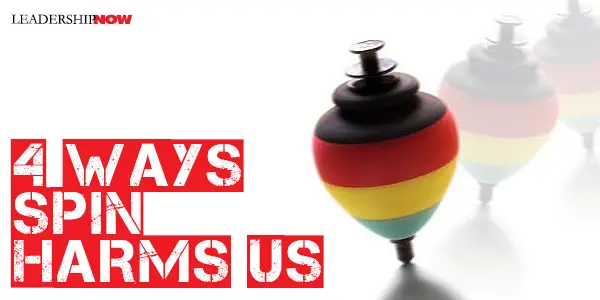
WE ALL SPIN—just a little. We all tell stories in such a way as to make ourselves look good or at the very least understandably wrong. Of course, there’s good spin and bad spin. Each play with reality a bit, but good spin is never a lie. It’s always on the level. It’s designed to highlight the positive and the uplifting. It opens us up to possibilities that were not readily apparent to us. Bad spin is a lie. It misleads and exaggerates. It’s opportunistic; design to benefit the spinner. It distorts reality and narrows our possibilities. It’s short term thinking. It may benefit us in the moment but it spoils us in the future. Bad spin harms us in a number of ways: First of all, it demonstrates a lack of personal responsibility. Rather than facing the facts and dealing with them, it displays our penchant for changing the facts to justify our mistakes. Second, it signals that we are immature in our understanding of success and failure. We should celebrate lessons learned and communicate that mistakes are a part of the growth process. Bad spin communicates that winning is the only thing and is to be valued more than teamwork and support. Third, it nullifies the feedback we get. The feedback we get is critiquing the spin and not the reality—it becomes delusional. Feedback based on spin confirms what we want to believe but it is worthless because it’s critiquing a lie. Only feedback based on reality is helpful. Fourth, it distances us from each other. We become cynical of each other. We lose trust. We lose respect for each other. We want straight answers from each other but we are never sure if we are going to get it. It becomes more difficult to be open, transparent, and non-judgmental. We crave smooth answers in times like these. Uncertainty makes us crave comfortable answers. Fear makes us accepting of reassuring rhetoric. But if it isn’t honest, it only dumbs us down. We can avoid bad spin if we respect each other, seek the truth, welcome growth, and make ourselves and others accountable for what we say and do.
Posted by Michael McKinney at 11:04 PM
11.13.13

Speaking with Presence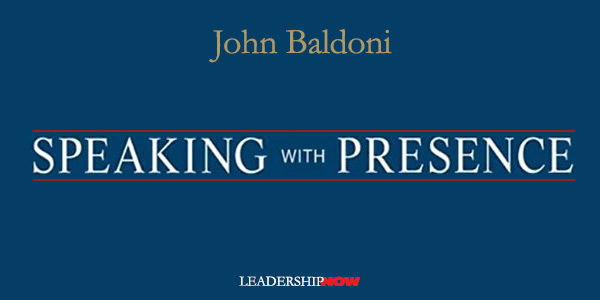
GOOD COMMUNICATION is at the core of good leadership. And speaking from who you are gives you credibility—an earned authority—and opens the door for you to turn listeners into followers. When you connect with an audience from who you are, you are speaking authentically. You have leadership presence. In The Leader’s Guide to Speaking with Presence, John Baldoni has gathered together what he has learned from his own experience and from others he works with. It is a valuable collection of principles to help us develop our leadership presence when speaking. Like a good speech, it is clear, concise, friendly, and can be put to use immediately. He begins with the sound of our speech. He asks us to think of our speech as a piece of music delivering variations in melody (rises and lowers according to the words), harmony (facts and stories blended for meaning), and rhythm (tempo, fast slow, matches mood and meaning). Speech delivery is an art that can be mastered if we practice. (Yes, the best practice their speeches.) Presenting effectively can be a huge challenge for many of us. But learning a few simple techniques about connecting with the audience can go a long way toward establishing a platform for confident delivery, and, more importantly, it can put the audience in a mood to listen to you. Most importantly, it affirms your leadership strengths and gives people a reason to follow your lead. Baldoni has an eye for the easily overlooked fine points of communication. He explains how and why to connect with an audience before, during and after a presentation. He advises on the proper use of stories to inform, to involve and to inspire. How to show optimism without looking like you don’t really know what’s going on. He includes nine key steps for developing a speech. How to use PowerPoint so it doesn’t look like a crutch but rather a well-crafted learning aid. He explains the importance of clarity over nuance for leaders. This guidebook is full of practical tips and insights to help you speak authentically—with leadership presence. Each chapter ends with questions to apply to your presentation or delivery—little details that make a big difference. His approach is founded on respect for your audience. Because ultimately it’s about them, it’s so important that you are aware of how you are coming across. This book will explain the mindset of leadership presence and the mechanics that make it work. Standing up in front of a live audience requires practice. The more you do it, the better and more comfortable you are likely to become. Keep one key point in mind. The audience wants you to succeed. No one likes to see a speaker “die” onstage. So be cool, be brief, and keep smiling. You will do just fine. 
Posted by Michael McKinney at 09:10 AM
01.24.13

Remember, It Was Once Someone’s Good Idea
MANY, if not most good ideas are not good forever. Over time they lose the luster they once had. They become irrelevant and ineffective. The universal danger we all face, is that we get so comfortable with what we do that never recognize that moment when it no longer serves the why. So it is good to periodically take a look at why we do what we do. But it is important to remember that they were once good ideas. Someone once fought to get the idea implemented that you are now trying to change. When we want to change the status quo, we need to approach it from the knowledge that someone had a good reason to make the decision they made. We should honor that. If we approach it in a way that is adversarial, judgmental or dismissive, we diminish and dishonor ourselves and others. When advocating a change, we need to be sure we are informed with the thinking behind the decisions of those that have come before us. When we do, we demonstrate that we are: Reasonable. We see the value in taking advantage of the experience of others.
People are more likely to look at your vision if they know that you have first taken the time to understand theirs. It promotes trust and creates a connection from which to lead.
Posted by Michael McKinney at 04:56 PM
01.21.13

5 Things Smart Risk Takers Do Well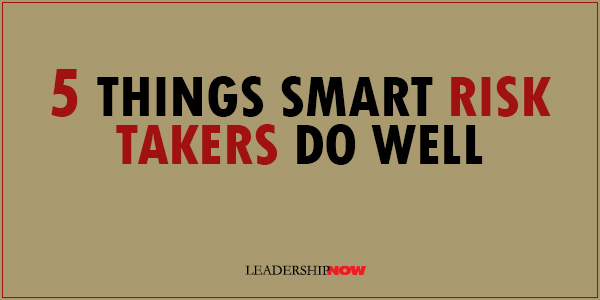 Doug Sundheim’s book, Taking Smart Risks, isn’t really about making your next risky decision smarter or safer; it’s about pushing all of your choices to be riskier, but smarter on a daily basis.
Doug Sundheim’s book, Taking Smart Risks, isn’t really about making your next risky decision smarter or safer; it’s about pushing all of your choices to be riskier, but smarter on a daily basis.
We tend to view our choices as risky or safe. Safe is good while risky is well, risky. You’re taking a chance with a risky choice; it could lead to ruin. Sundheim says that view doesn’t capture the essence of what taking a risk is all about. Taking a risk is “exposing oneself to the possibility of loss or injury in the hopes of achieving a gain or reward.” It’s really the reason we would consider taking a risk rather than just playing it safe. It’s not an either/or proposition—safe or risky. But because we perceive it that way, we tend to do all we can to avoid risk and stay in our comfort zone.  • You don’t win.
Are you caught in the comfort zone? Here’s a thought we can all relate to: Being caught in the comfort zone doesn’t mean that you’re sitting around doing nothing. It’s more nuanced than that. You could be making progress, but not quickly enough. You could be taking chances, but not boldly enough. You could be going out on a limb, but not far enough, and the extra push is what will make a difference. What Sundheim is advocating is a change in our mindset regarding risk. Rather than perceiving risk as negative (“Things may not be perfect now, but they’re not all that bad. If I make a move, things could end up worse. I’d better not risk it.”), we should view it as a balanced focus on both the downside of taking risks and not taking risks (“I’ll regret it if I don’t pursue this thing. I’ve got to find some smart ways to take risks to move it forward.”). A limiting mindset versus a liberating mindset.
Smart risk takers consistently do five things well to disrisk whatever they’re up to:
Communication is a critical element of each of these stages. “At every stage of any risk, improving the way in which you discuss thoughts, plans, and actions is the single most effective way to derisk the risk, that is, to make it smart.”

Posted by Michael McKinney at 10:34 PM
01.10.13

The Secret to Leadership Growth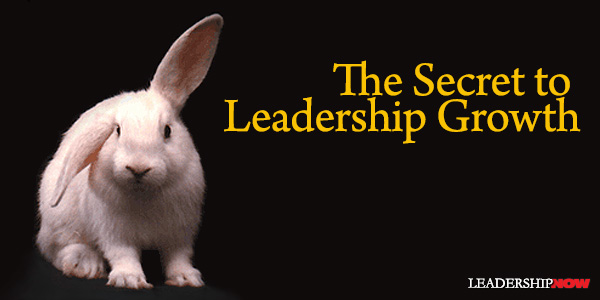
THE NUMBER ONE way leaders grow is by listening. Leadership feels like a talking role, but it is predominately a listening role. That can be hard to accept. It feels counterintuitive. A leadership role often makes us feel like we should be talking all the time; like we’re the most important person in the room. We’re not. Listening takes us outside our own heads. It gives us a chance to see things from a different perspective. It creates options. It creates the space for serendipity. Listening takes us beyond our egos. Without it we begin to miss very elementary things. When we miss elementary things we crash and burn in a self-made morass of complexity. Listening clarifies. Listening renews and refreshes. Without it we get stuck and tedious. When we help others grow, we grow. Leaders guide people and then listen. Listening is the best way to turn someone from a victim (of your talk) to a supporter of your idea. Listening gives others the chance to take ownership. Listening is the catalyst for making individuals a community. Listening creates the space for leadership.
Posted by Michael McKinney at 09:53 AM
10.30.12

In This World, You Can’t NOT Communicate!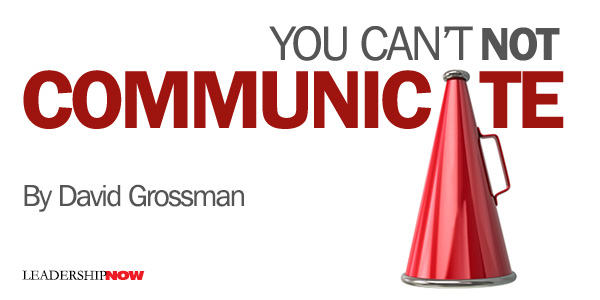
IN OUR WORLD – and in the world of business – virtually nothing is neutral. Sharks swim to stay alive – even while resting or sleeping. A carefully wrapped present says something quite different than a present that’s not wrapped so nicely. Similarly, everything you do or don’t do, and everything you say or don’t say, communicates something to those around you. As a leader this is vital because all eyes are on you – all the time. People read into your comments and actions. Who gets recognized in a meeting regularly? Did it look like your mind was wandering during that conversation? Is your door often closed? Do you smile? Everyone creates perceptions of you based on your actions and their experiences and biases. The reality is – You can’t not communicate. If that’s the case, you might as well get better at it. Communicating in business Effective leaders recognize their ability to achieve results from their direct reports – to generate engagement, to motivate, to get their team headed in the right direction – often succeeds or fails based on their ability to communicate. Their business results, and their ability to move people to action, are achieved by communicating strategically and doing it well; they are Leader-Communicators. In business, communication that has meaning is a difference maker. It can be used to build understanding, and make teams and individuals more efficient. It can be used to recognize good work and reinforce critical behaviors. It can be used to coach or mentor one person, or lead organizational change. It can share a vision, inspire confidence, strengthen a business and build a legacy. Real communication is a differentiator that can make you a business superhero. Become a “superhero” It’s not that difficult to be a communication superhero. And when you consider the strengths it offers you as a leader, I’d say it’s relatively easy. It might not feel that way all the time. In fact, sometimes it feels easier to just say nothing and keep going – but remember by not communicating you actually are communicating. What does it take to communicate well? Just like any learned skill, practice – simple, consistent practice. Here are a few tips to practice:
Like any great speaker, listen to feedback – then apply it and keep practicing. Learn the skill; understand the fundamentals, practice, practice, practice. You too can be a communication superhero! Now that you know you can’t not communicate, what are you actually communicating today?  
Posted by Michael McKinney at 09:08 AM
10.22.12

Renegades Write the Rules
AMY JO MARTIN has written a book about connecting. About being human. Renegades Write the Rules is about how to connect with other people using the medium of social media. But you’ll find you can apply the principles in many other ways too. She stresses the importance of just being you. Especially when it comes to exposing yourself using social media, that can be an uncomfortable place. “We all have the tendency toward the creation of a veneered version of our brands that we think is more acceptable, more compelling, more marketable to our audience. … Ultimately it makes you less human.” You begin by using social media to listen; to find out what matters to your audience. And then consistently deliver it. Importantly she notes, “Being excellent still earns an audience these days, but to keep them and attract more requires giving them something more personal….Without the ability to nurture loyalty through human connection, your brand’s value relies solely on performance.” Let that sink in. People don’t buy your what, they buy your why. Martin takes you through 8 essential renegade rules using good examples from her own experience and the organizations and people she has worked with like Dwayne Johnson (@TheRock), Shaq (@shaq), and Tony Hsieh (@TonyHsieh). Her philosophy is that “Renegades experiment and fail early so when everyone else jumps on the bandwagon, their best practices are being polished while others’ are just starting to fail. Sometimes it’s not about being the best or smartest; it’s about being the first to try and the first to learn from failure.” I found all of the chapters helpful, but one of my favorite sections came in the appendix. Martin shares fifteen lessons she wishes she had known from the beginning. Here are eight of them:

Posted by Michael McKinney at 11:01 PM
10.19.12

Leading Apple With Steve Jobs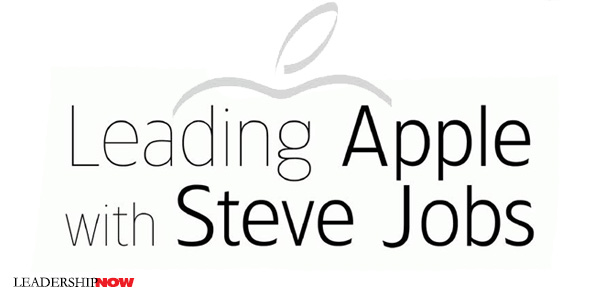
JAY ELLIOT, former Senior Vice President of Apple, has spent a lot of time with Steve Jobs. In Leading Apple with Steve Jobs, he writes that “Isaacson’s Steve is not the Steve I knew.” He believes that there has been too much focus on the negative aspects of how Jobs dealt with people and not enough on the positive. “I think,” he writes, “most people who worked for him, including me, would say they did the best work of their lives for him and don’t regret the experience a bit.” While his stories regarding his time with Jobs don’t do much to polish his image, he does bring out aspects of his thinking that undoubtedly have given people the opportunity to feel that in spite of the negative aspects of Jobs' behavior, Apple is where they wanted to be. When analyzing anything, it always a challenge to pull out the important lesson and learn how to integrate the good without the bad. We are all a complex mix of motivations and behaviors and everything we do seems like an indispensable part of achieving our success (or not). But we can always improve—diminish the negative and emphasize the positive. It is not unusual for any of us to find ourselves in a position where our intention is admirable but we lack the skill to implement it in the most beneficial way. Frequently, we can find ourselves stuck without alternatives to our own patterns of behavior. As leaders, we have to constantly be learning—by reflection and reading about the lives of others—to discover where we could expand our thinking and therefore our options. Not only does Elliot help us understand why Jobs was the way he was, he does a good job of explaining the development of and reasoning behind much of the Apple mystic that is worth implementing. Jobs said that “It’s not my job to pull things together from different parts of the company and clear the ways to get resources for the key projects. It’s my job to push the team and make them even better, coming up with more aggressive visions of how it could be.” Jobs believed that accountability, attention to detail, perfectionism, simplicity, and secrecy, would sustain innovative leadership at Apple. Getting the right people was as important to Jobs as creating a new product. “When you’re in a startup, the first ten people will determine whether the company succeeds or not.” Elliot says that he learned from Jobs the value of “knowing your own values so well that you can instinctively recognize someone who shares those values.” It would be good to reflect on our own values from this standpoint. Another way of thinking about this would be to consider: if you don’t know why you do what you do, why would anyone want to follow you? The right people make the difference. “A leader in the Steve Jobs model needs to have a set of lieutenants who can translate his goals and vision into detailed action plans. The success of Apple through the years has largely been due to Steve’s talent for surrounding himself with people who could bear the heat when he wasn’t satisfied, were strong enough to stand up to him when he was wrong, and were able to relay not just his instructions but his commitment, drive, and vision to the crew.” 
Posted by Michael McKinney at 02:54 PM
08.08.12

Leadership by Choice LEADERSHIP is always a choice. In Leadership by Choice, author Eric Papp says it means “making a conscious choice to positively influence those around you by managing yourself and leading others in four areas: communication, leading teams, productivity, and personal development.”
LEADERSHIP is always a choice. In Leadership by Choice, author Eric Papp says it means “making a conscious choice to positively influence those around you by managing yourself and leading others in four areas: communication, leading teams, productivity, and personal development.”
Communication — How well do you listen, ask questions, and speak with influence? How many of our problems are caused by a lack of listening? We listen better to people we like, but we can learn to listen with liking to anyone. What prevents us from doing so is preconceived ideas and ideas that we have about someone. “Sometimes while listening to someone, thoughts flood your mind – “can this person do anything for me?” “I probably won’t like this person,” or “Who likes them anyway?” – influencing how you listen.” Listen with liking. Leading Teams – How well do you establish trust, healthy conflict, and achieve results with others? A culture of blame teaches people that they can avert their own responsibility by blaming others. “When you breed and teach a culture of no accountability, it’s very hard to reach anything above mediocrity.” Without accountability you can’t lead. Papp suggests five ways to hold yourself accountable: 1. Don’t overextend yourself; 2. Take action before you speak. Actions speak louder than words; 3. Have an accountability partner; 4. Chart your progress. Write down daily or weekly actions that chart your continual growth; 5. Aim for consistency, not perfection. Productivity – How well do you spend your time and how focused are you? You are responsible for being productive. Know where your time is going, plan the day before, focus on high-payoff items, and delegate for results and not the process. (Forcing someone to do things your way is not delegating for results. It makes for a very stressful environment and is also counterproductive.) Personal Development – What are you doing to develop yourself? Where do leaders find their inspiration? “When we retreat to silence, we tap into the inner calm that allows us to search for answers.” Lead with silence. We must learn to deal with stress. Papp suggests that we enjoy silence, create a gratitude list, get your sleep and take naps, allow for mistakes, help someone (giving is a great stress reducer), and make a decision to enjoy life. 
Posted by Michael McKinney at 08:25 AM
10.14.11

5 Leadership Lessons: EntreLeadership Dave Ramsey defines EntreLeadership as “the process of leading to cause a venture to grow and prosper.” Entreleaders know how to blend their entrepreneurial passion with servant-like leadership that motivates employees through persuasion instead of intimidation. EntreLeadership is a book about how business works from a practitioner. His advice, on nearly every facet of running a business, is based on solid principles. Here are just a few of his thoughts on leadership: 
Posted by Michael McKinney at 05:25 PM
09.28.11

The 3 Core Elements of Delegation
Without delegation no organization can function effectively. Yet, lack of courage to delegate properly, and the knowledge of how to do it, is one of the most general causes of failure in organizations.Every time you delegate work to a teammate, three inescapable core elements of delegation are in play. Authority, responsibility, and accountability form an integrated process and must be applied by you as a unified whole. Authority Can Be Delegated As a leader, you can transfer pieces of your formal authority to another teammate when assigning a task to that person. In essence, you can deputize your teammate to take action on your behalf within the boundaries of the delegated (transferred) authority. Authority chiefly comes from the power of position. The more authority you have, the greater your ability to delegate higher-level, more meaningful and challenging tasks to others to help them learn, develop, and grow. Responsibility Cannot Be Delegated, but It Can Be Assigned As a leader, you can assign responsibility to another teammate in terms of the results that need to be achieved. However, you need to keep in mind that you only assigned responsibility to your teammate. If your teammate “fouls up the thing royally,” your manager will censure you, not your teammate. In short, you can never fully hand off any of your responsibilities to someone else. Assigned responsibility should be made in terms of the goals or results to be accomplished, not the detailed specifics for doing the job. Accountability Means Obligation Accountability is the moral compulsion felt by a teammate to meet the goals and objectives of an assigned task. As a result of accepting a task assignment, your teammate in effect gives you a promise—either expressed or implied—to do her best in carrying out the activities associated with it. Having taken on the task, your teammate is obligated to complete it, and thus is held accountable by you for the results produced. Adapted from Building Team Power: How to Unleash the Collaborative Genius of Teams for Increased Engagement, Productivity, and Results by Thomas A. Kayser
Posted by Michael McKinney at 12:09 PM
09.14.11

Advocacy: How to Champion Ideas and Influence Others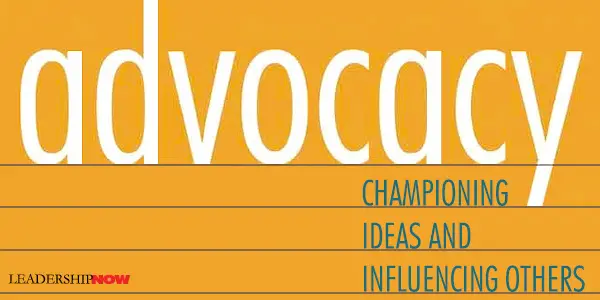
EVEN a great idea can be stopped. An idea is like play. It needs a good producer and a good promoter, even if it’s a masterpiece. Otherwise, the play may never open; or it may open but, for lack of an audience, close after a week.All ideas need to be sold; up, down, and across. You have to become an advocate. “Advocacy,” says John Daly, “is an exhausting but necessary skill.” Tom Peters recently tweeted: “Remember, all of implementation is politics, like it or not—and you damn well better learn to like it.” Daly defines advocacy as “persuading people who matter to care about your issue. It’s about getting listened to, being at the table when decisions are made, being heard by people who make decisions. It’s about facing and overcoming resistance. It is about speaking and writing in compelling ways that make decision makers want to adopt your ideas.” Advocacy by John Daly, is a comprehensive handbook on influence. He covers the complex factors involved in selling an idea, supported by examples and current research in the fields of persuasion, power relations, and behavior change. Here are some of the ideas he shares: Communicate Your Idea With Impact: Decide what you want to communicate before you ever start talking. Restate key aspects in alternative ways. Don’t get defensive or humiliate those who ask questions. Alan Greenspan’s advice: “Make every member of Congress look like a genius for asking a particular question, even when the question is truly idiotic.” Frame Your Message: Successful advocates communicate their ideas in ways that fit decision-makers’ schemas. When pitching proposals, wise proponents seek agreement on the problem before discussing possible solutions. Encourage people to buy into the problem the way you want it defined. Build Your Reputation, Create a Brand: Regardless of how good your idea is, if it doesn’t fit your brand name, people aren’t likely to buy it. Form Alliances: Understand people’s basic needs—inclusion, control, efficacy, and affection. People want to matter. Let others feel indispensable to the success of the idea. Be proud of what you tout; how you talk and act about your idea shapes how others respond. Your Idea Is Only as Good as Its Story: Influential narratives are short, fresh, easily understood, and engaging, and they arouse curiosity. If you can’t craft a good story around your idea, interesting and relevant factoids are the next best thing. Network!: It’s not who you know that matters, it’s who knows you. Put yourself in the place of most potential. Befriend those without friends. Lyndon Johnson: “Remember, your opponent today may well have to be your ally tomorrow. Never burn personal bridges.” Timing Is Everything: The answer to “why now?” is your persuasive case. Problems have four features—magnitude, predictability, complexity, and affected parties. Address these. Random—not regular or cyclical—problems get the decision maker’s immediate attention. Make the Idea Matter: Inexperienced advocates often spend too much time trying to sell the features of their ideas before pitching their benefits. Demonstrate Confidence: Shorter words are remembered better than longer ones. Avoid hedges, disclaimers, disfluencies, and tag questions. Even the most experienced advocate will be able to refine their skills and increase their influence by incorporating the advice found in this handbook. 
Posted by Michael McKinney at 09:07 AM
08.22.11

Relationship Trouble? Try Another PerspectivePeriods of crisis and testing are helpful for what they bring to our attention. When things are going well it is all too easy to ignore the hard issues we would be better served by addressing. Times of testing show who we really are.Diana Smith identifies one such issue in The Elephant in the Room: relationships. “No longer,” Smith writes, “can we count on slow markets or sloppy competition to make up for the inefficiencies poor relationships create. We face a crisis not only of leadership but of relationship.” When faced with a relationship problem, there are two ways we can look at it: Individual Perspective: Based on the assumptions that there is one right answer, people either get it or they don’t get it, and when they don’t, their dispositions are largely to blame. Relational Perspective: Based on the assumptions that different people will see different things, that solid common ground can only be found after exploring basic differences, and that the strength of a relationship will determine how well and how quickly people can put their differences to work. “The assumption that ‘you alone are responsible’ and ‘you are either mad or bad’ lead people to locate the cause of problems in individuals and outside their own influence.” The relational perspective actually puts you in the frame of mind to take responsibility for any part you may have in the difficulty. Reflecting on the relationship between Churchill and Roosevelt she observes that “they looked to the other’s circumstances, not his character, to find out why” they did what they did. Karl Popper wrote in Conjectures and Refutations, “While differing widely in the various little bits we know, in our infinite ignorance we are all equal.” Smith says that understanding this “leads people to assume that we all see things others miss, that disagreements are inevitable and valuable, that those disagreements will at times cause frustration, and that people will be better off if they help each other build relationships that can handle those differences well, especially under pressure. While it makes sense to take the relational perspective, it can be hard to do especially when we are in the heat of the moment. One reason for this is that it is hard to step out of the moment and reflect on and reframe the situation in a productive way. And when we do reflect it’s easy to get sucked into what Smith calls “armchair reflection.” This is reflection that is really nothing more than gossip, blaming, imputing motives and conclusions like, “He just doesn’t get it.” It doesn’t lead to understanding and a forum for the other person to fill in what is missing from the picture. Not all relationships are created equal and Smith offers techniques to sort those out too. But when we want to improve a relationship, if we are waiting for the other person to change, she says we’re in for a long wait. “To improve a relationship, you need to focus on changing the relationship, not just yourself or the other person.” Smith offers tools and practices to do this. Before you even begin to work on a relationship, there is an interesting paradox to think about: “They know each other so well, they no longer know each other at all. All they see are the caricatures in their heads—he’s so sensitive, she’s so competitive.” Smith adds that despite the “very efficiency these caricatures give, they also take away because they make a person’s underlying complexity—sure to emerge under stress—harder to handle or to understand. That’s why, early on, the single most important thing people can do is slow down and take a closer look at each other and how their relationship works. Your effectiveness as a leader depends on your relationships. The Elephant in the Room highlights a better perspective to take than the standard individual perspective we usually employ in dealing with our relationships. A relationship is a system of behaviors that can be analyzed and understood. Smith’s insights will help you to productively influence them.
Posted by Michael McKinney at 03:50 PM
07.26.11

Have a Nice Conflict!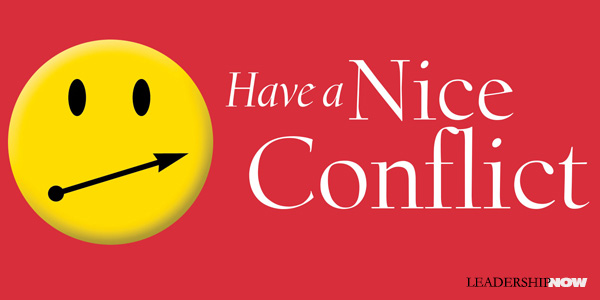
READING Have a Nice Conflict was like listening to my Dad again. He first met “Doc” Porter in the early seventies and they clicked almost immediately. Elias Porter’s Relationship Awareness Theory, on which the book is based, resonated with my Dad. Behaviors are the tools we choose and use to support our self-worth.Have a Nice Conflict is the story of sales manager John Doyle who has been passed over for what he believes is a well-deserved promotion. He has lost some of his top performers because he rubbed them the wrong way. When he turns up at an old friend and client’s office to explain yet another change in sales reps, he puts him on to Dr. Mac to help him improve his people skills at both work and home. Dr. Mac explains to John that there are many ways of interacting with others. We have default ways of behaving and when in conflict we often shift into other behaviors to maintain our self-worth. While we are trying to do the “right thing” to maintain our self-worth, conflict can happen when our “right thing” appears to be the “wrong thing” to another person. Conflict can be prevented by seeing contentious behavior as merely a different style instead of a direct challenge or threat aimed at annoying you or derailing you. He introduces him to the Strengths Deployment Inventory (SDI) which is a tool to help you understand the motivations behind your own behaviors and to better discern the motivations of others. By giving you a framework it helps you to understand what you and others are feeling and then helps you be better able to respond. Having a nice conflict is about taking personal responsibility for the interaction. To create movement toward resolution, we need to show the other person the path back to self-worth—where they feel good about themselves. That path may be different than yours. The concept should be taught in schools, however, the thought process is essential for leaders. The book alone offers valuable insights into the process and methodology, but coupled with the SDI you’ll have greater success. The authors offer a discount on the SDI to readers of the book. 
Posted by Michael McKinney at 05:08 PM
07.20.11

Information Overload and What You Can Do About ItKnowledge workers think for a living to varying extents, depending on the job and situation, but there is little time for thought and reflection in the course of a typical day. Instead, information—often in the form of e-mail messages, reports, news, Web sites, RSS feeds, blogs, wikis, instant messages, text messages, Twitter, and video conferencing walls—bombards and dulls our senses.Consider this: A 30-second interruption can result in as much as 5 minutes of recovery time. In total, interruptions plus recovery time consume as much as 28% of the knowledge worker’s day. The volume of information we have today “throttles productivity, reduces our capability to absorb and learn, puts our physical and mental health at risk, and interferes with personal and business relationships.” Jonathan Spira, CEO of Basex, a research firm focusing on issues companies face in the knowledge economy, explains in Overload! why we are in the state we are in and what steps we can begin to take to better manage it. Even as dry as information tends to be, this is an absorbing book. Spira claims that the changes in how we use and view information that will happen over the next 50 years will not only reshape the globe but turn it inside out. Today, information overload costs the U.S. economy a minimum of $900 billion per year in lowered employee productivity and reduced innovation. To manage successfully in the knowledge economy, we must recognize key differences in how knowledge workers work. Their tasks can be categorized into six overarching tasks: searching, creating content (sometimes re-creating), thought and reflection, sharing knowledge, and networking. Interestingly, a 2010 Basex study found that of these tasks, knowledge workers only spend only 5% of the day engaged in thought and reflection. The one task that is essential for all the rest we spend so little time performing. We must allow [require] workers more time for thought and reflection if they are to be more productive, efficient, and effective. Too much information without reflection can stall our productivity. It affects our ability to manage thoughts and ideas, contemplate and even to reason and think. We develop a state of what has been termed, continuous partial attention; to give only partial attention continuously. Science writer Steven Johnson described it this way: It usually involves skimming the surface of the incoming data, picking out the relevant details, and moving on to the next stream. You’re paying attention, but only partially. That lets you cast a wider net, but it also runs the risk of keeping you from really studying the fish.Researcher Linda Stone adds this: It is motivated by a desire to be a LIVE node on the network. Another way of saying this is that we want to connect and be connected. We want to effectively scan for opportunity and optimize for the best opportunities, activities, and contacts, in any given moment….It is an always on, anywhere, anytime, any place behavior that involves an artificial sense of constant crisis. We are always on high alert when we pay continuous partial attention. Although there are tens of thousands of things we could do says Spiria, he offers ten tips that, when observed, will help lower information overload for everyone:
Posted by Michael McKinney at 08:56 AM
06.28.11

Civility is the Precondition to Democratic Dialogue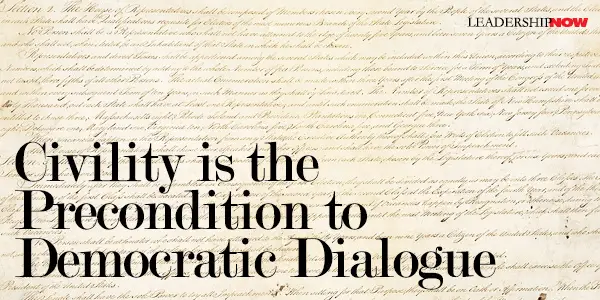
 When you see the lack of civility, characterized by harsh words, yelling, finger-pointing and name-calling, it most often serves to describe the mind of the antagonist than the object of their wrath. We call the world the way we see it—that is, the way we see ourselves. As Anaïs Nin is said to have written, “We don't see things as they are, we see things as we are.” Unfortunately the antagonist will go on to tell story after story of how they have been victimized and will never find peace until they take responsibility for their own mind. Only then will their story change and only then can there be real dialogue. Carter writes: Democracy demands dialogue, and dialogue flows from disagreement. But we can, and maybe must, be relentlessly partisan without being actively uncivil. Indeed, the more passionate our certainty that we are right, the more urgent our need to practice the art of civility—otherwise, we make dialogue impossible, and the possibility of dialogue is the reason democracy values disagreement in the first place. 
Posted by Michael McKinney at 01:58 PM
06.07.11

Transforming an Ordinary Moment into a TouchPoint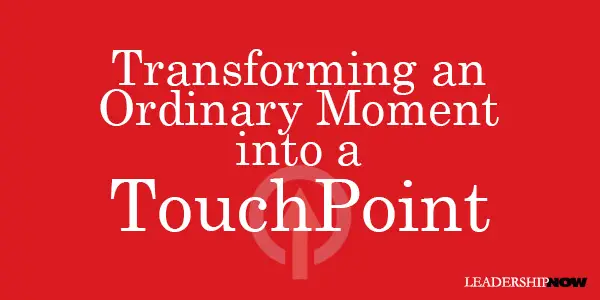
WE ALL have those moments when we are too busy for the people around us. But those moments are the work of leaders. Those are the moments when we can help to move things from what they are to what they could be. Campbell CEO Doug Conant said, “To me, they’re not interruptions. They’re opportunities to touch someone and improve the situation.” TouchPoints, by Doug Conant and Mette Norgaard, describes a new way of thinking about the work of leadership. TouchPoints are those moments in the day when you have the opportunity to touch the lives of other people. Each has the potential to become a high point or a low point in someone’s day. “Each is an opportunity to establish high performance expectations, to infuse the agenda with greater clarity and more energy, and to influence the course of events.”Every TouchPoint is spring-loaded with possibilities. Each one can build—or break—a relationship. Even a brief interaction can change the way people think about themselves, their leaders, and their future. TouchPoints exposes the extreme responsibility that leadership is. A responsibility that in our overloaded age, we often overlook. To make the most of your TouchPoints, they have created the TouchPoint Triad: listen, frame, advance. In any moment you begin by asking, “How can I help?” Then you listen intently. This prepares you and helps you find out what is really going on. Be curious and keep listening for the real issue. Next, you frame the issue to be sure that everyone in the TouchPoint is on the same page. Third, you advance the agenda. People come to you because they want results. Once you know what is needed, do what you can in that moment to advance the agenda; decide on what the next step is, and who is responsible to do it. After the TouchPoint is over, make a point to check-in and see how well the action plan is going by asking something like, “How did it go?” or “Is there anything else you need from me?” It’s a reminder that you care and lets you know if you were genuinely helpful.
A TouchPoint is about really connecting with others and improving results. It’s about engaging in a way that is alert, abundant, authentic, and adaptable: You need to be alert to the real issues. “When you are fully present, you can see the gaps in someone’s line of logic and pick up bits of information that provide clues to what is going on.” You need to be abundant in your thinking; rejecting the either/or scarcity mindset. To be authentic is to embrace the work of the leader and “live by a very clear code that provides an underlying clarity and consistency in every TouchPoint.” “The secret to being adaptable is to develop a broad range of skills, so that you can adjust and adapt in the moment.” Throughout TouchPoints, you will find many nuggets of relationship wisdom to help you, as they put it, “work with, not against, the nature of things.” The authors insist that you clarify your own leadership model so that you can apply it consistently. To that end, they suggest that you answer two vital questions: What makes people give the very best of themselves? What makes for ever-stronger performance in an ever-changing world? Your answers will help you to define how you see yourself, other people, and the world around you. 
Posted by Michael McKinney at 11:06 PM
05.26.11

5 Leadership Lessons: Redesigning Leadership
JOHN MAEDA is the president of the Rhode Island School of Design. In Redesigning Leadership, he—with co-author Becky Bermont—pulls the leadership lessons from the ups and downs of his time there. In his transition from MIT to RISD he found that the two words “free pizza” were a powerful motivator to convene large numbers of students. “Making people work together can be fairly challenging, but getting them to eat together is somehow vastly easier. A meal is often a catalyst for a conversation that can lead to a collaboration, and a meal is a natural happening to signify closure when the collaboration has been completed.” Leadership is never easy and it is made more difficult by what I perceive is a growing sense of entitlement we all feel in our culture. It’s not all good or bad, but it is something to deal with. Redesigning Leadership is a slim book, but it is full of great thoughts like these:

Posted by Michael McKinney at 09:52 AM
05.24.11

Got Drama?
YOU can’t stop The Drama. There will always be drama. But that’s not the problem says Marlene Chism, author of Stop Workplace Drama. “The amount of time you stay in the drama—and the effort you put toward it—is the problem. Complaints, excuses, and regrets only serve to keep the drama alive.” Your drama—what you add to The Drama—is the problem.Chism defines drama as “any obstacle to your peace and prosperity.” Drama is the result of not recognizing or taking care of the little signs of bigger problems when they first presented themselves. At the core of drama, you will find one of three common elements (if not all three): a lack of clarity, a relationship issue, and/or resistance. So, says Chism, when you experience drama you need to ask yourself three questions: 1. Where am I unclear?
Chism presents eight principles for dealing with drama, but “lack of clarity” struck me as the most common and excuse-laden trap there is. Too often this is where we get stuck.
“Any type of discord, abuse, confusion, or game-playing always boils down to a lack of clarity.” A loss of focus. Sometimes we create drama because we want something on our terms. We imagine that we can’t do something because we can’t do it the way we think it should be done—our way. Chism relates a clarifying example of this with the recently divorced Joe who is having visitation issues with his ex-wife Patty. She’s not letting him do what he wants in the way that he wants. Many people get stuck in the drama of what should or shouldn’t be. Yes, you can fight that battle, if winning a battle is what you want. But again, in order to clear the fog and help Joe get clarity, I asked, “If there are two islands you can go to, and one means winning a battle with your wife and the other island is getting to see your kids and be a father to them—then which island would you choose?” This kind of dynamic plays out every day in our business and personal lives. When we are not clear about what we want, what our values are, what we are committed to, it is easy to lose our focus, to drift off course Solution: Clear the fog. Chism has written a good-natured and practical book that will change your thinking and in the process help you to control the drama in both your personal and professional life. As leaders, we have the responsibility to be very clear with ourselves and our team so that we don’t get pulled into negativity, gossip, power plays, resistance and … drama. Chism suggests asking the following questions: What are my top 10 principle-based values?

Posted by Michael McKinney at 10:00 PM
05.09.11

5 Mistakes People Make When Reading Your Body LanguageWhen we communicate there are two conversations going on. Verbal and nonverbal.Our brains are hardwired to respond to nonverbal signals. Unfortunately we often don’t even know how we are reacting to them or how others are reacting to us and therefore are unable to use them to our advantage. This becomes very apparent when we are reacting to nonverbal communication from people from different cultures. Thus what might seem right in one culture may be ineffective or offensive in another. Communications expert Carol Kinsey Goman wrote The Silent Language of Leaders to help us become more aware of the messages we are sending and to better read the signals of others. When there is a disconnect between your verbal and your nonverbal communication, you don’t make sense. People will tend to disregard what you say and focus on what you don’t say. My mother always told me, “It doesn’t matter if what you say is right, if your tone is wrong, then it’s wrong.” Goman would add: “How can sometimes be more revealing of your true meaning than the what contained in the words. Leaders must therefore keep in mind that when they speak, their listeners won’t only be evaluating their words; they will also be automatically ‘reading’ their voices for clues to possible hidden agendas, concealed meanings, disguised emotions, unexpected surprises—anything, in short, that will help determine whether or not they can rely on what they're being told.” Goman defines our nonverbal communication—body language—as the management of time, space, appearance, posture, gesture, vocal prosody, touch, smell, facial expression, and eye contact. Goman says that people look for leaders to project two sets of nonverbal signals—power and authority and warmth and empathy—and it’s important to employ the right signals at the right time. Which means that the body language signals that work so well when announcing a new business strategy are not helpful (and in fact may sabotage your efforts) when building collaborative teams. Successful leaders don’t memorize “the right” physical gestures and facial expressions to display at appropriate times as though they were some kind of preprogrammed robot. But they are aware that their body language dramatically impacts colleagues, clients and staff. They understand that for a variety of reasons, even the most well-meaning behaviors will sometimes be misinterpreted, and they are ever alert to finding authentic ways to align their nonverbal communication with the messages they want to deliver.Reading nonverbal communication can be tricky for a number of reasons. Here are five mistakes people make when reading body language:
When it comes to building collaboration, even the seating arrangement in your office makes a difference. “Seating people directly across from your desk places them in an adversarial position. Instead, place the visitor’s chair at the side of your desk, or create a conversation area (chairs of equal size set around a small table—or at right angles to each other) and send signals of informality, equality, and partnership.” Gorman has made available on her web site, videos and articles to reinforce the material presented in her book. Interestingly, Goman predicts that because of new visual technologies, body language skills will become even more crucial than they are today. Video communication exposes a leader’s body language to evaluation to a greater degree. She also predicts that with the emphasis now on more collaborative structures, a leader’s body language will have to project trust, inclusion and rapport. Look for more Body Language Notes on the LeadershipNow Facebook page. 
Posted by Michael McKinney at 10:04 PM
04.12.11

From Values to Action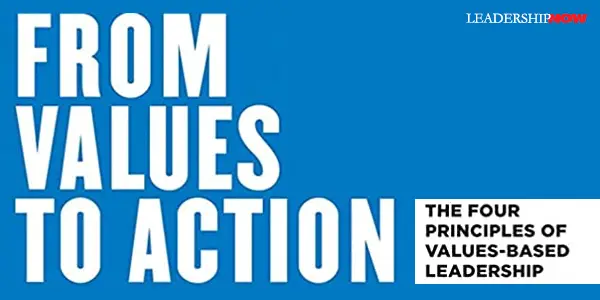
FORMER chairman and chief executive officer of Baxter International, Harry Kraemer, has written a genuine, back-to-basics book on value-based leadership: From Values to Action. He presents four interconnected principles that build on and contribute to each other: Self-Reflection is the most important and is central to your leadership. “If you are not self-reflective, how can you truly know yourself?” writes Kraemer. “If you do not know yourself, how can you lead yourself? If you cannot lead yourself, how can you possibly lead others?” Self-reflection allows you to transform activity into productivity for all the right reasons. It means “you are surprised less frequently.” It is essential in setting priorities. You can’t do everything. So reflection makes it possible to answer key questions like What is most important? and What should we be doing? in a way that is in line with your strengths and values and organizational goals. Engaging in self-reflection on a regular, ongoing basis (preferably daily) keeps you from becoming so caught up in the momentum of the situation that you get carried away and consider actions and decisions that are not aligned with who you are and what you want to do with your life. Balance and Perspective is the ability to understand all sides of an issue. Pursuing balance means you will have to grasp the fact that leaders don’t have all the answers. Kraemer says, “My task was to recognize when a particular perspective offered by one of my team members was the best answer….Leadership is not a democracy. My job as the leader is to seek input, not consensus.” Because he believes we are more effective if we balance all areas of our life, he prefers the term “life balance” over “work-life balance.” It’s not an either-or proposition. “When you identify too closely with your work, you can easily lose perspective and become unable to look at all angles in a situation.” He recommends implementing a “life-grid” to keep track of where you are spending your time and to hold yourself accountable. True Self-Confidence is know what you know and you don’t know; to be comfortable with who you are while acknowledging that you still need to develop in certain areas. (Comfortable not complacent.) Why TRUE self-confidence? There are people who adopt a persona that might make others think that they have self-confidence, but they are not the real deal. Instead, they possess false self-confidence, which is really just an act without any substance. These individuals are full of bravado and are dominating. They believe they have all the answers and are quick to cut off any discussion that veers in a direction that runs contrary to their opinions. They dismiss debate as being a complete waste of time. They always need to be right—which means proving everyone else wrong. Genuine Humility is born of self-knowledge. Never forget where you started. “Genuine humility helps you recognize that you are neither better nor worse than anyone else, that you ought to respect everyone equally and not treat anyone differently just because of a job title.”
Kraemer describes a values-based leader well: “Self-reflection increases his self-awareness. Balance encourages him to seek out different perspectives from all team members and to change his mind when appropriate in order to make the best possible decisions. With true self-confidence, he does not have to be right, and he easily shares credit with his team. Genuine humility allows him to connect with everyone because no one is more important than anyone else.” From Values to Action is an outstanding book and filled with important concepts that any would-be leader would benefit from. 
Posted by Michael McKinney at 04:13 PM
04.07.11

Leadership is about Creating ConversationsPoet and Fortune 500 consultant David Whyte said that “The core act of leadership must be the act of making conversations real.” Conversations—sometimes difficult conversations—are what build relationships. Conversations that provide the opportunity for possibility. Conversations about choice.Leaders create the opportunity for conversation. By bringing people together for conversation they increase engagement, commitment and accountability. Leaders ask people to share their own genius and assume personal leadership. At that point the ability to listen becomes paramount. Accountability isn’t only at the top. It lies with all of us. All of us are responsible. Possible futures are not the work of one person. They are made possible by the conversations and resulting accountability of a community of leaders. Leadership is about creating conversations.
Posted by Michael McKinney at 07:18 PM
03.18.11

5 Leadership Lessons: The Velocity Manifesto In today’s high-velocity environment, Scott Klososky believes you need to understand how to guide your organization in the implementation and usage of technology—in short, how your organization “does” technology. [As a leader], you—not the IT department, nor the VP of IT, nor the chief information officer (CIO)—must understand, drive and be accountable for how technology is structured in order to reach the strategic goals of the operation….Technology enables velocity—the speed of getting products to market, the speed of delivery, the speed of analytics, and the list goes on. Speed is our friend in almost every case. An organization’s digital plumbing is what facilitates this speed, and it has become the single most important variable for success in many organizations.The Velocity Manifesto 
Posted by Michael McKinney at 04:54 PM
02.23.11

Socrates on Communication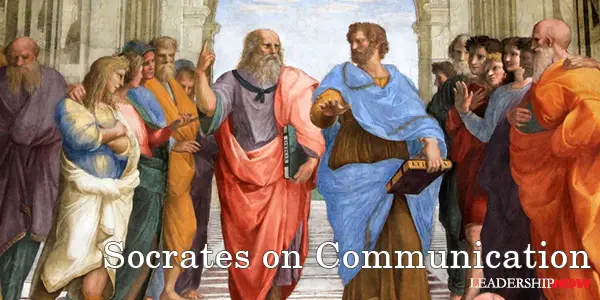
BETTANY HUGHES, author of The Hemlock Cup—a fascinating portrait of Socrates and Athenian society—says that “He reminds us to keep debating the meaning of life, to keep questioning, to keep speaking to one another, to keep looking for answers. However you value him, you cannot argue with the central tenet of his philosophy. Because he beseeches mankind not to be thoughtless.”  Socrates was wary of the written word. His anxiety was that it could neither account for itself nor answer back. Words were everywhere in Athena’s city, but Socrates, unusually, did not set his own down on papyrus with an inky flourish. In a city filled with authors of every kind, he was anxious about the impact of writing without the accountability of face-to-face contact. “I cannot help feeling, Phaedrus, that writing is unfortunately like painting; for the creations of the painter have the attitude of life, and yet if you ask them a question, they preserve a solemn silence.” Socrates was living through his own information revolution. He shares with us the same concerns. 
Posted by Michael McKinney at 11:12 PM
02.04.11

The Power of Meeting People Where They Are
IN Split-Second Persuasion, Cambridge psychologist Kevin Dutton asks why some of us are better at the art of persuasion than others. He recounts a story about Winston Churchill’s encounter with war hero James Allen Ward that illustrates the power of meeting people where they are:

Posted by Michael McKinney at 10:12 AM
01.10.11

The Power of Framing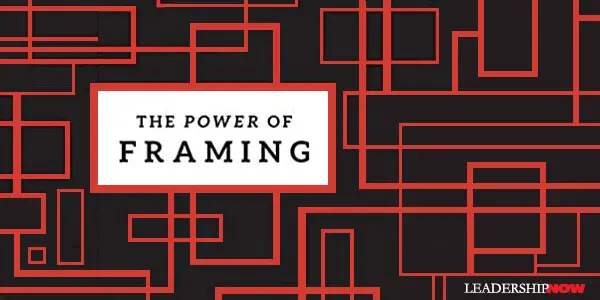
“Language becomes a key issue not just in our own sensemaking, but in how effectively we impact the sensemaking of others,” writes Gail Fairhurst. As leaders, we recognize that we cannot accomplish our objectives on our own, so this becomes important when we are trying to align the interests of others with our own. The Power of Framing by Gail Fairhurst is about understanding the meaning—the shared reality—created in our communication. Paraphrasing Michel Foucault, she writes, “people know what they say, and they usually know why they say what they say. What they do not understand is what they say does. The Power of Framing is an essential leadership book that will help us to understand the context-shaping features of our language so that we can then better manage the meaning of our communication. Recently, we have seen many examples of leaders creating unintended “realities” from the content of their communications alone that only served to make a big problem, bigger.People with the skills to communicate reality in a meaningful way often emerge as leaders, she observes. What we often fail to consider, is that when communicating, we are not just reacting to the environment; we actually shape or create it by how we interpret and talk about it. Being conscious of our framing then becomes critical. Self-awareness plays a major role in framing our communication to have the impact we intend. She begins by presenting six guiding rules for constructing reality: Rule 1: Control the Context. Leaders often cannot control events, but they can control the context under which events are seen if they recognize a framing opportunity. Rule 2: Define the Situation. At its most basic level, framing reality means defining “the situation here and now” in ways that connect with others. Rule 3: Apply Ethics. “Reality” is often contested. Framing a subject is an act of persuasion by leaders and imbued with ethical choices. Rule 4: Interpret Uncertainty. It is the uncertainty, confusion, and undecidability of “the situation here and now” that opens it up for interpretation and provides an opportunity for the more verbally skilled among us to emerge as leaders. Rule 5: Design the Response. Ultimately, leadership is a design problem. Leaders must figure out what leadership is in the context of what they do and, through framing and actions, persuade themselves and other people that they are doing it. Rule 6: Control Spontaneity. Effective framing requires that leaders be able to control their own spontaneous communications. With these rules in mind, Fairhurst explores framing as a skill that leaders must master to communicate vision and set priorities, a science that shows leaders how to think on their feet and frame on the spot, an art form that leaders must hone like a craft with story, metaphor, argument, and visual images as their primary tools, a set of emotions that leaders must deploy to complement their message and as an ethical response in order for leaders to achieve and maintain believability. As a science she explains the concept of priming for spontaneity. It’s more than just thinking through what you want to say in a given situation. It involves thinking through your mental models. She writes, “If you take the time to consciously and periodically think through your mental models as a leader, you are priming your unconscious to select and interpret new information using the models as a reference point.” What we say reflects our thinking and view of the world. Emotions are a part of leadership and emotional intelligence is required for framing. When emotions are running high you have an opportunity for framing. “Emotional regulation is a part of emotional intelligence, and two framing concepts play a role in this regard,” says Fairhurst. “Priming for spontaneity can assist in controlling one’s emotions in advance of a situation if one envisions a wide range of responses are likely to occur. Also, framing after the fact, or reframing, allows leaders to correct the emotionally charged messages they wish to modify.” In regards to ethics, she reminds us that “how we frame is a window into our ethics whenever we act in a leadership capacity.” This is closely tied to the concept of priming. We reflect and communicate our mental models in all that we do. To use in conjunction with this book, Fairhurst has created some valuable downloadable framing tools. There are links to additional resources for specific topics raised in each chapter, including films, documentaries, news clips and PowerPoint teaching slides. 
Posted by Michael McKinney at 11:52 AM
11.24.10

The Laws of CharismaEven though charisma is thought of as something intrinsic to the individual, a person cannot reveal this quality in isolation. It is only evident in interaction with those who are affected by it. Charisma is, above all, a relationship, a mutual mingling of the inner selves of leader and follower.Charisma is often thought to be something in your DNA. You either have it, or you don’t. But as Kurt Mortensen makes clear in The Laws of Charisma, it “is a trait that can be taught and mastered.” Charisma is about connecting with others. Mortensen defines it as “the ability to easily build rapport, effectively influence others to your way of thinking, inspire them to achieve more, and in the process make an ally for life.” Like leadership, it can be used positively or negatively. It depends on where the emphasis is: self or others. For example, he lists some of the differences between ethical and unethical uses of charisma:
Ultimately, charisma will only take you so far. Without character and competence, it is fleeting. Our greatest roadblock to developing charisma, Mortensen points out, is that we lie to ourselves. We think we are better than we are. We think our weaknesses aren’t that noticeable, and it gives us a false sense of security and no starting place from which to begin to make the improvements we need to make. Mortensen has created a self-assessment for 30 attributes that define a charismatic individual. Chapter by chapter, he takes you through each of these, describing them, showing how they are applied with real-world examples and what the counterfeit version of each looks like. For instance, passion is not hype or bouncing off the walls. It’s more like conviction that radiates from within. You may think you’re coming across as confident, but you could be perceived as either arrogant, cocky, or condescending. Arrogance is about self, and confidence is about others. Control is not power. It creates short-term compliance even as it drains the life out of people and creates long-term resentment. The attributes are organized into four areas: The elements of presence—how to radiate charisma through passion, confidence, congruence, optimism, positive power, energy and balance, and humor and happiness. Tapping into and developing the core inner qualities of charisma: self-discipline, competence, intuition, purpose, integrity, courage, creativity, and focus. Delivery and communication—how to use presentation skills, people skills, influence, storytelling, eye contact, listening, and rapport to speak with conviction and get heard. Empowering others through inspiration, esteem, credibility, motivation, goodwill, vision, empathy, and respect—the components of contagious cooperation. Other things to consider are how you communicate (both verbally and non-verbally), how you look, and your feelings and moods. Each chapter is well thought out as he looks at each attribute from different angles. Each attribute is just a piece of the total charisma picture. The more you develop, the better you will be able to connect with others. While some of these attributes will come naturally to you, some will take a concerted effort. Taken as a whole, these thirty attributes are overwhelming. Take them one at a time. It’s a lifelong process. 
Posted by Michael McKinney at 12:31 AM

Seven Charisma KillersIn The Laws of Charisma, Kurt Mortensen lists a number of things we do that repel people. He writes, “These mistakes are silent charisma killers. Most people will never say anything to you that will alert you to the fact that they are being repelled. They are more comfortable lying to you so that they don’t hurt your feelings. They walk away and simply never deal with you again.” Here are seven of the most common charisma killers adapted from Mortensen’s list that you may not even know you are doing:
Posted by Michael McKinney at 12:24 AM
08.11.10

5 Leadership Lessons: Scott Berkun on Public Speaking Even if you don’t speak professionally, you will find Scott Berkun’s Confessions of a Public Speaker, helpful in navigating any speaking situation. Berkun is refreshingly candid about his own mistakes and successes. It is an entertaining and practical behind-the-scenes look at the speaking profession; the good and the bad. He shares what has worked and what hasn’t in getting over the fear of speaking, creating a talk that people want to hear, and what to do when things go wrong. More Scott Berkun on Twitter / Web
Posted by Michael McKinney at 09:37 PM
06.18.10

Maxwell Connect: 7 Things You Can Do to Become More Interesting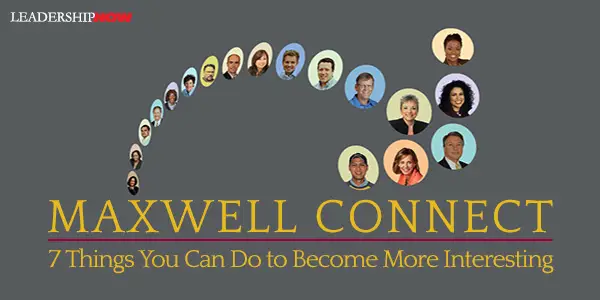
IF you want friends, show yourself friendly. If you want to connect with others, become the kind of person others want to connect with. Be the kind of communicator that you would like to hear. “Connectors,” says John Maxwell, “create an experience everyone enjoys.” A big part of being an interesting person is being interested in other people; making them feel interesting. You’ll be amazed at how interesting you become to them. In Everyone Communicates, Few Connect, Maxwell recommends seven things to make yourself more interesting. They were presented in the context of speaking to audiences, but as you will see, they have application to one-on-one communication as well.
“There are different ways that you can measure people's greatness. And the way I like to measure greatness is: How many people do you affect? In your time on earth, how many people can you affect? How many people can you make want to be better? Or how many people can you inspire to want to do what you do?” —Will Smith, Vanity Fair, July 1999
John Maxwell asks, “In the end, what good is our communication if its impact ends the moment we stop speaking?” 
Posted by Michael McKinney at 12:21 AM
06.16.10

Maxwell Connect: 4 Barriers to Finding Common Ground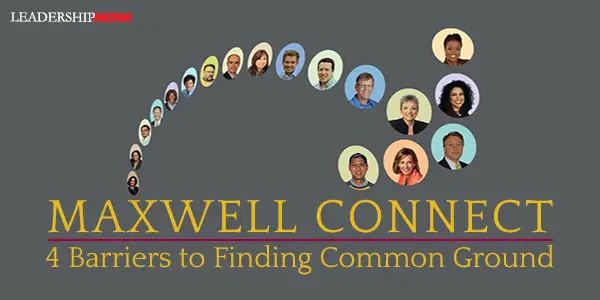
THE first rule of connecting is to find common ground. Again, this requires an other-focus. In Everyone Communicates, Few Connect, John Maxwell writes, “It is difficult to find common ground with others when the only person you are focused on is yourself!” We can’t find common ground if we are trying to make other people into a version of ourselves. Each of us sees the world from our own unique perspective. Terry Felber, author of Am I Making Myself Clear? There are many reasons people neglect to find common ground, Maxwell says, but here are the top four:
Taking down these barriers is a matter of choice. It means making yourself available, listening to others, asking questions, being open, being adaptable to people and situations, and most importantly, being humble. “I will think of myself less so I can think of others more.” Civil rights activist Cornel West says, “Humility means two things. One, a capacity for self-criticism…. The second feature is allowing others to shine, affirming others, empowering and enabling others. Those who lack humility are dogmatic and egotistical. That masks a deep sense of insecurity. They feel the success of others is at the expense of their own fame and glory.”

Posted by Michael McKinney at 07:34 AM
06.14.10

Maxwell Connect: Everyone Communicates, Few Connect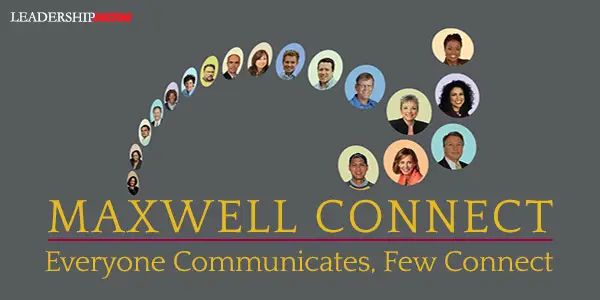
GEORGE BERNARD SHAW said, “The greatest problem in communication is the illusion that it has been accomplished.” How true. One of the biggest reasons leaders fail is their inability to communicate. Most of the time, we unconsciously leave it to chance. Just because we say something doesn’t mean we have communicated it. As John Baldoni observed, “The ability to speak is not the same thing as the ability to communicate….The capacity to construct a message, address it to another, listen for feedback, process that feedback, and continue to communicate in ways that are understood is one of the hardest things a leader will have to do.” But it can be done if we are willing to make the conscious choice to connect with others. John Maxwell has written a clear and well-organized book (with his writing partner Charlie Wetzel) about connecting with others one-on-one, in groups, and before an audience. It’s a practical book about bridging the gap between you and the people you are trying to connect with. Everyone Communicates, Few Connect is oriented towards leaders, which is to say, any of us that decide to make a choice to intentionally influence others. Connecting is basic to human relations. Maxwell puts it simply: “If you want to succeed, you must learn how to connect with others.” He asks, “Have you ever heard of someone who is said to have a charmed life? Usually, those are people who have learned how to connect. When you connect with others, you position yourself to make the most of your skills and talents.” How does connecting happen? Not surprisingly, it all begins with your attitude. “The ability to connect with others begins with understanding the value of people.” As with leadership in general, connecting is about other people. In a word, selflessness. It is about asking yourself, “Am I going to make this about them or me?” Maxwell points out that “understanding that your focus must be on others is often the greatest hurdle people face in connecting with others.” It’s all too easy to get caught up in what we are doing to the point where we place it and ourselves at the center of the universe. Maxwell writes, “Good teachers, leaders, and speakers don’t see themselves as experts with passive audiences they need to impress. Nor do they view their interests as most important. Instead, they see themselves as guides and focus on helping others learn.” He tells a story from when he began his career as a minister. He felt frustrated and unfulfilled. He kept asking himself questions like, “Why aren’t people listening to me? Why aren’t people helping me? Why aren’t people following me?” He writes, “Notice my questions centered on me because my focus was on me….I was self-absorbed, and as a result, I failed to connect with people….I realized that I was trying to get ahead by correcting others when I should have been trying to connect with others.” It is all too easy to focus on our needs instead of the needs of others. There are three questions people are always asking about you: “Do you care for me?” “Can you help me?” and “Can I trust you?”Connecting begins when the other person feels valued. We need to have the attitude and approach of “What can I do to increase my value of others?” The ideas he presents are not new nor should we expect them to be. While technology has changed some of our tools of communication, it has not changed the principles of connecting. Ironically, technology has not made it any easier or better. Today's technology won’t communicate a selfless attitude any better than using smoke signals if it is not the foundation of the communication in the first place. Forming connections with each other has not changed over time. We must always be reminded of the principles behind it. 
Posted by Michael McKinney at 11:59 AM
05.20.10

Share Your Ideas Liberally Scott Belsky makes the case in Making Ideas Happen for sharing your ideas with others. To make it part of the corporate culture you may even have to “move people around and literally share people to share ideas.” Former Belsky colleague Steve Kerr, even went so far as to say that “’hording information is an integrity violation,’” making the case that failing to share a best practice with your team or department was essentially akin to stealing from the company.” Belsky explains the rationale for sharing ideas liberally: The notion of “sharing ideas liberally” defines the natural instinct to keep your ideas a secret. Yet, among the hundreds of successful creatives I’ve interviewed, a fearless approach to sharing ideas is one of the most common attributes. Why? Because having the idea is just one tiny step along the road to making that idea happen. During the journey, communal forces are instrumental in refining the very substance of the idea, holding us accountable for making it happen, building a network that will push us to go above and beyond, providing us with valuable material and emotional support, and spreading the word to attract resources and publicity. By sharing your idea, you take the first step in creating the community that will act as a catalyst to making it happen. He who receives an idea from me, receives instruction himself without lessening mine; as he who lights his taper at mine, receives light without darkening mine. That ideas should spread from one to another over the globe, for the moral and mutual instruction of man, and improvement of his condition, seems to have been particularly and benevolently designed by nature. Adapted from Making Ideas Happen: Overcoming the Obstacles Between Vision & Reality by Scott Belsky.
Posted by Michael McKinney at 04:31 PM
03.30.10

Leading Views: The Leader as Communicator
Speech is a part of manners, and the able businessman must learn to express himself in English which is clear as well as colloquial.
Posted by Michael McKinney at 07:33 AM
03.25.10

5 Leadership Lessons: Colonel Bob Stewart on Leading Under Pressure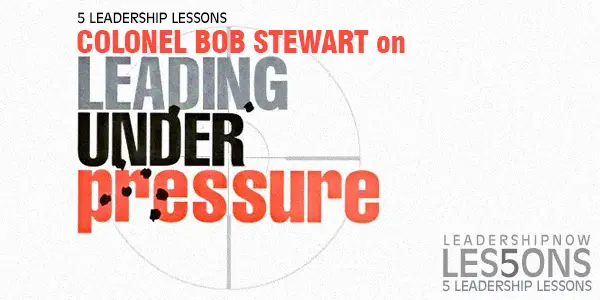
Leadership Under Pressure is a book of lessons learned and shared in personal stories by Colonel Bob Stewart. He was the first British United Nations Commander in Bosnia. On return from Bosnia Stewart was awarded the Distinguished Service Order for “cool courage and inspirational leadership.” Stewart believes that leadership is universal and is not confined to a few special people. “It is universal, normal and quite ordinary too…. Leading in its basic form is the ability to show the way and guide others to achieve something.” Here are just several of the lessons he presents:

Posted by Michael McKinney at 02:09 PM
02.18.10

How Fascinating is Your Message?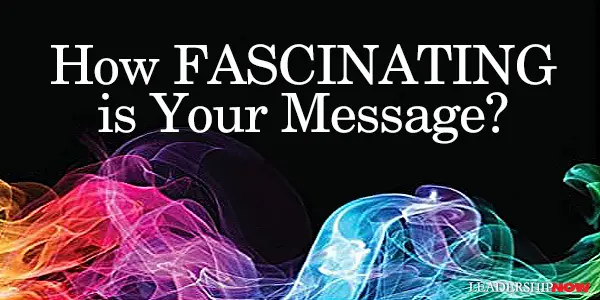
ROBERT LOUIS STEVENSON said, “Everyone lives by selling something.” Leaders are always selling something—an idea, change, themselves or even their example. It’s influence. While we know a clear consistent message is necessary it is often hampered or even marginalized by competing messages and issues. Sally Hogshead is an expert at delivering messages and changing people’s minds. In her book Fascinate: Your 7 Triggers to Persuasion and Captivation, she writes, “A competitive environment demands a more captivating message.” A more captivating message is a more fascinating one. Fascination is the connection we make with others that causes them to change their mind and behave differently. “People won’t change a preference, start a thought process, form a bond, or make a behavioral shift unless they’re provoked to change their opinions or actions.” Fascination provides the provocation. A fascinating message steps outside the norms in one or more of the following ways: provokes strong and immediate emotional reactions (love it or hate it), creates advocates, becomes “cultural shorthand” for a specific set of actions or values (people identify with it), incites conversation, forces competitors to realign around it, and/or triggers social revolutions (forces us to think differently). The key to mastering fascination is learning to effectively activate the seven triggers:
The point of all this is that you can make your message (or yourself for that matter) more fascinating. “All seven triggers affect decision making whether or not we intend them to.” She offers tools for evaluating your message, developing the appropriate triggers and then executing those triggers. She says there’s no “right” way to fascinate and that’s a good thing because we all operate a bit differently and tend to utilize different combinations of the fascination triggers. On her web site you can find out your fascination score (F Score) by taking a short test. In an interesting example concerning teenage drinking and driving she notes that a graphic photo of a car wreck doesn’t seem to effectively dissuade teenage drivers. For teens, fear isn’t necessarily a reason to avoid something. How do you provide a fascinating message for this group? Luke Sullivan, a legendary advertising writer, solved the problem. Luke knew that teems don’t fear death in the same way as adults. He also figured out what does create alarm among these drivers: Losing their license. Armed with that fact, he threatened teens with the ultimate dire consequence. How could you change your message to make it more fascinating and thus more effective for your audience? Throughout the book she blends art and science to demonstrate what fascinates people and why. You might be surprised to find out which fascinations are driving your own behavior. Her writing style and examples are very entertaining. “Whether we realize it or not—whether you intend to or not—you’re already using the seven triggers,” she writes. “The question is, are you using the right triggers, in the right way, to get your desired result? By mastering the triggers, your ideas become more memorable, your conversations more persuasive, and your relationships more lasting.” How do you try to change people’s minds? Could you make your message more fascinating? 
Posted by Michael McKinney at 05:47 PM
12.14.09

Lift: How to Be a Positive Force in Any Situation
TO OVERCOME the force of gravity—that which pulls us down—we have to generate an opposing force greater than gravity. That force is lift. Any opposition to lift is called drag. In the same way that we use the laws of physical science to lift a plane off the ground, we can use social science to lift “ourselves and others up to greater heights of achievement, integrity, learning, and love,” thereby becoming a positive force in any situation. It’s the pressures of daily living that drag us down. Instead of experiencing lift we fall back into our comfort zones, become reactive, self-centered and fatalistic. To intentionally experience lift and to be a positive influence for others, we have to make a conscious choice. In Lift: Becoming a Positive Force in Any Situation, authors Ryan and Robert Quinn present this fitting metaphor, to explain how we can intentionally experience lift, to rise above the constraints of everyday life and lift the people around us. “All of us have a choice: we can choose to be the kind of people who drag others down or to be the kind of people who lift…. We are relational beings. Who we are at any time depends on who the people around us are, and who they are depends on who we are.” That last sentence can’t be overemphasized. It carries with it a great deal of responsibility, especially for us as leaders. The authors describe lift as “a psychological state in which a person is purpose-centered, internally directed, other-focused, and externally open.” What exactly are these four characteristics of lift? In a very relatable and revealing example—the parenting of a young son, Mason—the authors show how this plays out in real life. I can’t reproduce the example here, but I think from the inferences you will get the idea the authors are trying to convey. The following is paraphrased from their work: Purpose-centered is the opposite of being comfort-centered. The desire to stay comfortable is a characteristic of a normal psychological state. My son Mason’s behaviors were comfortable for me. In my desire for comfort, what had not occurred to me was the possibility that perhaps Mason was behaving differently because of the changes that had happened recently in his life. We need to ask, “Are the results I am trying to create about me and what I am comfortable with or are they about what is best for the other person?” Internally directed is when people experience the dignity and integrity that comes with exercising the self-control necessary to live up to the values that they expect of others. External direction, on the other hand, is a characteristic of a normal psychological state. If Mason was building with his Legos or playing a game when I asked him to do something, I expected him to put those things aside and do it. Yet, if I was involved in an activity and Mason interrupted me, I would expect him to wait until I was done with my activity before I did what he asked. I expected him to show respect to me, but I was not doing the same for him...When people are externally directed, they let circumstances (such as the need to get Mason to clean up or go to bed) drive their behavior instead of their values (such as respect for others’ time and activities). Other-focused is to be open to other people’s feelings and needs. We then empathize with them and feel impulses to be compassionate. When we are self-focused, we are concerned only with our own needs, feelings, and wants. We see other people as objects that either helps us or impede us in our goals. In my case, Mason was an object that was preventing me from my goal of showing that I was a good father. Externally open is openness to external cues. When we are open we learn, grow and adapt ourselves to the situation unfolding before us. When we are internally closed, we ignore and deny feedback. We ignore or deny feedback out of fear that the feedback says something about our worth as human beings. So as a result, we tend to get angry. Again with Mason, I was not showing him the respect that I wanted him to show me. As I opened myself to the possibility that I might be wrong, I also opened myself up to what Mason was feeling, and to what his needs might be and became other-focused. Using scientific research to provide “insight into why lift is important, what the characteristics of lift are, and how our psychological states influence others,” they formulated four questions that capture the nuances required to intentionally move ourselves from a normal state into lift.
This post is getting long, but I would like to share several more thoughts for you to contemplate: When a new situation disrupts our previous expectations, though, it is more productive to change our expectations than to try to make the world conform to our old expectations. The book is full of great examples and scientific evidence to back their perspective. The scientific evidence is really just icing on the cake. The relational principles at work here are sound, but they require much thought and self-examination. This is a book that needs to be read and re-read. Inertia is our biggest enemy. Inertia will keep us from benefiting from this book and becoming a positive force; the kind of leaders that provide lift in our own lives and those we influence. 
Posted by Michael McKinney at 11:10 PM
12.11.09

Is Your Story Winning Hearts and Minds?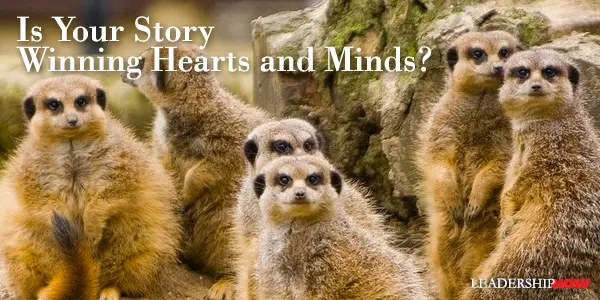
LEADERSHIP is part of a story. Leaders answer the why; they tell the story. Leadership is paradoxical because while leaders must manage the realities, they lead in the ideal. In The Visionary’s Handbook, Watts Wacker and Jim Taylor advise leaders to have the right story—a simple, consistent story that connects the past, present and future. But it needs something more: It should have some melodrama; some action; climax and resolution; a plot that turns toward the good at the end on the strength of a key virtue; a beginning, middle, and end—all the things that were taught in Literature 101 because in the last analysis a great story must be just that: a great story. Negative capability is an interesting concept. It was coined by John Keats in a letter to his brothers (George and Tom), dated December 21, 1817. He wrote: I had not a dispute but a disquisition, with Dilke on various subjects; several things dovetailed in my mind, and at once it struck me what quality went to form a Man of Achievement, especially in Literature, and which Shakespeare possessed so enormously - I mean Negative Capability, that is, when a man is capable of being in uncertainties, mysteries, doubts, without any irritable reaching after fact and reason-Coleridge, for instance, would let go by a fine isolated verisimilitude caught from the Penetralium of mystery, from being incapable of remaining content with half-knowledge. Keats thought, that one of the qualities of great people is their ability to sublimate their own individual assumptions and persona—that is, to make themselves a negative—and thereby contemplate the world without the desire to try and reconcile contradictory aspects or fit it into closed and rational systems. This requires being a good listener and the ability to say, “I don’t know.” 
Posted by Michael McKinney at 03:13 PM
11.26.09

Gratitude: The Habit of Noticing
GRATITUDE is a way of investing ourselves in others. A particularly overlooked aspect of the art of gratitude is the habit of noticing. When we notice others and show our appreciation, it pays huge dividends. Additionally, by noticing others we become more attuned to life’s vitality, intensity, and diversity. I related the following story from the book Growing the Distance, a few years ago, but it bears repeating: Arden Barker had planted a 50-acre field of wheat that was now golden-brown, very full, and ready for harvest. It was a sight to touch the heart of any farmer. When his Uncle Harry came to visit, Arden proudly took him out to look at the field of wheat. Harry looked around, put his hand over his eyes to peer into the distance, and fixed his gaze on a boulder that had been too large to move in the middle of the field. “Is that a stone on the hill?” he asked. He said nothing about the field of wheat. Arden was crushed by his lack of enthusiasm. Too often, leaders, managers, and parents think that it is crucial to their role to point out where people could improve—to be critical. Certainly, there is a time for that, but it happens all too often. Effective leaders will look for the positive and show gratitude and appreciation for it. People often look to others for direction and support and if it is not forthcoming it can kill the spirit and impede growth.
Posted by Michael McKinney at 12:19 AM
08.10.09

Taking Control of the Story: Four Helpful Questions to AskWhen emotions run high we tend to throw everything we know out the window. Staying in dialogue and in control of the stories we create about the events in our life isn’t always easy, but it is possible.It begins by taking control of and responsibility for the emotions you have created for yourself. As the authors state in Crucial Conversations, “Emotions don’t settle on you like a fog. Others don’t make you mad. You make you mad.” With that understanding you can decide to control them or be controlled by them. When you experience something, there are the facts of the situation and then there is your story about it; your conclusions, your interpretations, your judgments, and your spin on it. The most common trap is to assume that our emotions are the only valid response. Consequently, we charge ahead justified that our story is accurate and we make no attempt to change or even question it. It’s our stories that can get us into trouble and cause us to behave in ways that we know we shouldn’t. Again in Crucial Conversations they stress that we need to separate stories from facts. “When you generate stories in the blink of an eye, you can get so caught up in the moment that you begin to believe your stories are facts. They feel like facts. You confuse subjective conclusions with steel-hard data points …. ‘He’s a male chauvinist pig’ is not a fact. It’s the story Maria created to give meaning to the facts. The facts could mean just about anything.” We create stories to justify our behavior. They suggest we ask ourselves four helpful questions to get ourselves into constructive dialogue: Am I pretending not to notice my role in the problem? Why would a reasonable, rational, and decent person do this? What do I really want? What would I do right now if I really wanted these results? We must always remember that there are more stories than the one we have created. “As we tell the rest of the story, we free ourselves from the poisoning effects of unhealthy emotions. Best of all, as we regain control and move back to dialogue, we become masters of our own emotions rather than hostages.” And we free ourselves from unnecessary regret. Crucial Conversations is an indispensable guide to learning to handle your most difficult conversations and improve the quality of your life and those you lead. Make sure everyone on your team has one.
Posted by Michael McKinney at 03:19 PM
06.08.09

Lead, Sell, or Get Out of the Way Lead, Sell, or Get Out of the Way by Ron Karr provides more evidence that leadership isn’t just about a few titled people at the top. It is a choice to think differently. Leadership is a choice to think differently about anything you do. Selling is no exception and is closely linked to the functions of a leader. Leadership is not always about people we “lead” in the conventional sense, but is frequently about people we must influence. Karr writes, “Whether you sell a product, a service, or an idea, you must be able to influence other people as leaders do.”
Lead, Sell, or Get Out of the Way by Ron Karr provides more evidence that leadership isn’t just about a few titled people at the top. It is a choice to think differently. Leadership is a choice to think differently about anything you do. Selling is no exception and is closely linked to the functions of a leader. Leadership is not always about people we “lead” in the conventional sense, but is frequently about people we must influence. Karr writes, “Whether you sell a product, a service, or an idea, you must be able to influence other people as leaders do.”
It begins with being able to and understanding the need to engage others in continuous strategic conversations as part of the normal way of doing things—a process Karr has termed Integrated Dialogue. Integrated dialogue is a conversation of shared purpose that draws people out “to create a powerful relationship, one that identifies whole new zones of mutual opportunity, addresses far-ranging issues, and positions you as an invaluable resource: a leader.” As with all leaders, salespeople too will succeed when they fully appreciate the many relationships inherent in their success. Sales leaders lead a whole cast of people in their own organizations from the customer service, tech people to accounting and senior management. In addition, they lead not only their customer or end-user but also many points of contact in their customer’s organization that are likely to have some input on the buying decision like operations, accounting, purchasing, and senior management. Gone are the days where everything filters through the salesperson. “Your success as a salesperson depends on your ability to build and sustain coalitions both inside and outside your organization. You must create and lead the coalition, no matter what you are selling.” This will resonate with any leader: Your job is to manage multiple constituencies and alliances and to use those alliances to identify new and better ways of generating the desired results. Your job is to do what most salespeople don’t do: lead the conversation with your prospects and customers about the results they need, the problems they have, and the obstacles they face. To make this happen you must possess and develop the belief that you have everything you need and can build on that, the belief that you can improve any area of your life, everything is possible, preparation maximizes your potential, and your customers—the people you need to influence—come first. After laying the groundwork, Karr defines and explains the seven traits that great sales leaders share:
Karr demonstrates how to move from task-oriented selling (which is what most salespeople do) to purpose-oriented selling. These principles are worth bearing in mind on a personal development level as well. Karr encourages, “The bottom line is that you have the ability to increase your sphere of influence and sales just by the way you act toward those you are trying to influence.” Change your conversations, change your outcomes. Leaders in any field will find much here to assimilate into their daily activities. Read it and grow. 
Posted by Michael McKinney at 11:15 AM
05.08.09

Your Acknowledgment List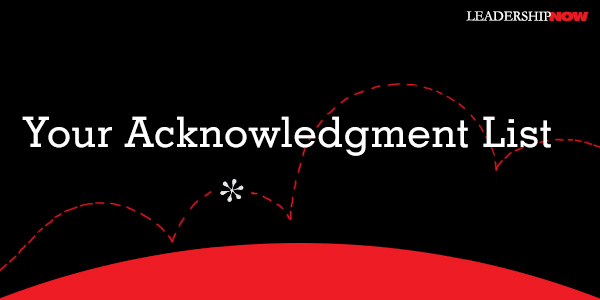
I WANT TO to draw your attention to two closely related posts by Rick Smith. They address two important issues. First, the need to get good, solid support and feedback, and second, the importance of appreciation. Here are some of the key points he shared: Earlier in my career, I was an executive recruiter, and what always struck me is just how lonely these men and women were. Not Tom Hanks on a desert island lonely – these people were surrounded by people clamoring for their attention. Rather, they were lonely in the sense that they rarely if ever could find a safe place to collaborate with peers around real problems. Their superiors were always looking for the answers, their subordinates were looking for direction. When they were able to interact with those outside of their companies, it was almost always at functions for their industry (i.e. their competitors). Everywhere these executives go, that have to present themselves as if they know the answers, as if they are supremely confident. But guess what? Even the most heralded execs share the same uncertainties as the rest of us. They just aren’t allowed to show it. 
Posted by Michael McKinney at 10:31 AM
04.03.09

Newswire: What the French Revolution Can Teach America
Posted by Michael McKinney at 11:29 AM
03.09.09

Strategic Presence: The Power that Fuels LeadershipTony Jeary, author of Strategic Acceleration: Succeed at the Speed of Life, is a coach to some of the world's top CEOs. In his book he brings together practical ideas to help you get out of your own way. A critical aspect of getting things done through others is presence – your presence. To influence others you need to know how they perceive you and adjust your communication with them accordingly. Here, Tony discusses what he calls strategic presence:The goal of leadership is to produce superior results on purpose and that makes leadership a results contest. The challenge of leadership is to persuade and motivate those they lead to produce the results they want. When people voluntarily and enthusiastically do what their leaders ask them to do and the desired results are achieved, leaders are considered to be effective and successful! The question is how do leaders really get others to voluntarily and enthusiastically produce the desired results? There are many parts to this puzzle, but there is none greater than a condition I describe as Strategic Presence. Here is a great story that illustrates Strategic Presence and also illuminates its effect. A student from a foreign country was enrolled in the middle of a school year. During the first day of class, the other kids in the class were doing what kids do. There was a lot of giggling and staring and posturing for the new arrival. The new student was dressed in a way that did not meet the expectations of a few of the other children and eventually one of them (the class clown) began to make jokes about the new student's appearance. As the scene was progressing toward chaos, the teacher was about to intervene when a girl stood up and told everyone to stop picking on their new classmate. The girl reminded them that it was scary to be new in a school and they needed to be kind to the student and make them feel welcome She reminded them they should treat this new person as they would want to be treated if they were in a new country and a new school. After class, the teacher called the girl aside and said, "That was a very brave thing you did. Why did you do that?" The girl replied, "Because that is what my Mom and Dad would expect me to do!" This story powerfully illustrates the essence and the effect of what I call Strategic Presence. The girl had merely done what she knew her parents would want her to do. Her parents had succeeded in creating a positive presence in her mind, which gave her the willingness and courage to do what she did. Most importantly, the presence of her parents was so authentic that they did not have to be physically present to inspire their daughter's good behavior. Leaders create impressions that exist in the mind of every person they lead. It is a presence that defines the perceptions people have of their leaders and what they believe about them. It is this overall persona that I am referring to when I use the term Strategic Presence and there are two types: Positive and Negative. Leaders are constantly creating and presenting images of influence that produce both. The most important fact about Strategic Presence is that it produces two possible reactions in others. It either produces voluntary cooperation or it produces various forms of resistance. If leaders generate positive Strategic Presence, people will be more likely to support what they want, most of the time. However, if perceptions of leadership are negative people will substitute resistance for cooperation. The possibilities of how people will respond to Strategic Presence are limited to cooperation or resistance. There is not much middle ground between them. As someone once said, "you are either for us against us!" It is easy to see why creating an authentic, positive strategic presence is critical for the execution of a vision. Creating positive Strategic Presence is not a strategy of manipulation. The positive strategic presence leaders project must be authentic. Failing the test of authenticity means the very image leadership hopes to establish will be perceived as deceptive and disingenuous, or worse. People are very perceptive and they will see through efforts to project a phony persona for the purposes of manipulating their behavior. So, why shouldn't a leader's strategic presence just be allowed to be what it is?" That is a great question and the answer is simple. Many leaders are misunderstood and create perceptions that really don't match their intent. So, understanding how Strategic Presence is created will minimize the possibility of being misunderstood. So, how is strategic presence is created? What are the things about leadership that speaks the loudest about it? What creates the perceptions that combine to produce Strategic Presence? There are two components that contribute to strategic presence: values and behavior. Our values are established by what we believe to be right, wrong, true, false, acceptable, unacceptable, appropriate and inappropriate. Let's face it, we have all developed deep, strong opinions about many things as we live our lives. Our opinions spring forth from your values and your values influence what we actually do. Our values and beliefs impact 5 categories of that drive our behavior, and it is our behavior that creates Strategic Presence. The five categories that drive behavior are:
Posted by Michael McKinney at 05:54 PM
02.06.09

Mastering UncertaintyNeal A. Hartman, a senior lecturer in behavioral and policy sciences at Sloan School of Management, MIT, offers this advice in the Financial Times, concerning how a leader should behave in this uncertain business environment.Managers must also pay close attention to their own actions during uncertain times. Because many people perceive uncertainty as frightening, leaders need to display behavior that brings about a sense of trust and credibility. Uncertainty is often a source of stress, but it is how people react to this stress that determines the kind of decision-making that occurs. Effective managers are those who develop the emotional maturity to behave rationally and confidently in stressful and uncertain situations and they must nurture this ability in their employees as well.
Posted by Michael McKinney at 12:26 PM
01.30.09

Communication Crib Sheet for Crisis Times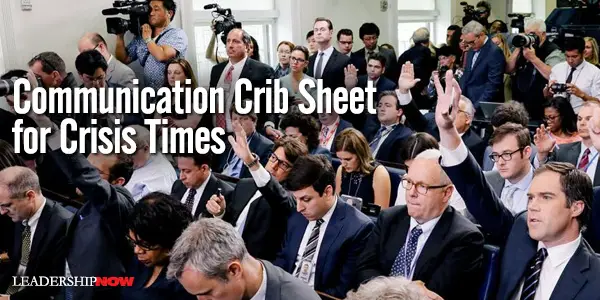
IN AN excellent series of special reports on Managing in a Downturn produced by the Financial Times, Paul A. Argenti, professor of corporate communication at Tuck School of Business, Dartmouth College, observes that “many companies flail by failing to act or by taking the wrong kind of action when communicating with distressed stakeholders.” People are eager to listen and by acting quickly and thoughtfully, “a company can build reputational capital and weather the storm to come out on the other side perceived as a long-term leader.” During a crisis, companies can uncover opportunity by adhering to a few simple guidelines when communicating with investors, employees, the press and the general public.
Posted by Michael McKinney at 10:45 AM
01.20.09

The Top 5 U.S. Inaugural Speeches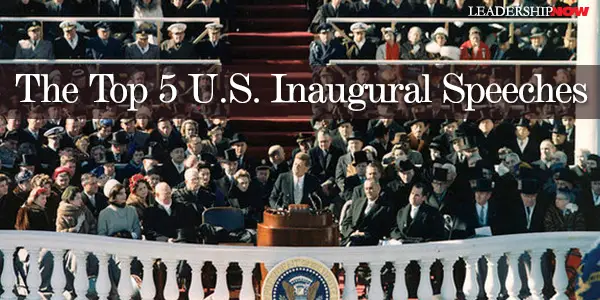
DAVID GREENBERG, a professor of history and of journalism and media studies at Rutgers University, offers his view of the five best inaugural speeches in the Wall Street Journal. “Over the decades, indeed, only a few have gained canonical status – for the sublimity of their prose, the eloquence of their delivery or the aptness of their message for a concurrent crisis.” I would place Lincoln’s short but powerful second inaugural address in 1865 as the best, but here is Greenburg’s list: 5. John F. Kennedy – 1961 “And so, my fellow Americans: ask not what your country can do for you—ask what you can do for your country.” 4. Thomas Jefferson – 1801 (First Inaugural Address) “But every difference of opinion is not a difference of principle. We have called by different names brethren of the same principle. We are all Republicans, we are all Federalists. If there be any among us who would wish to dissolve this Union or to change its republican form, let them stand undisturbed as monuments of the safety with which error of opinion may be tolerated where reason is left free to combat it.” 3. Franklin D. Roosevelt – 1937 (Second Inaugural Address) 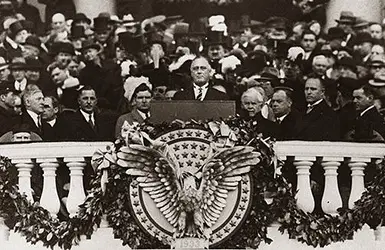 2. Abraham Lincoln – 1865 (Second Inaugural Address) “With malice toward none, with charity for all, with firmness in the right as God gives us to see the right, let us strive on to finish the work we are in, to bind up the nation's wounds, to care for him who shall have borne the battle and for his widow and his orphan, to do all which may achieve and cherish a just and lasting peace among ourselves and with all nations.” 1. Franklin D. Roosevelt – 1933 (First Inaugural Address) “This great Nation will endure as it has endured, will revive and will prosper. So, first of all, let me assert my firm belief that the only thing we have to fear is fear itself—nameless, unreasoning, unjustified terror which paralyzes needed efforts to convert retreat into advance.”
Posted by Michael McKinney at 01:08 PM
01.15.09

Living Within the Lie
BRITISH economist John Kay wrote in the Financial Times about the power of words to send us off into the wrong direction. More specifically, weasel words. There are some good thoughts here. Here is an excerpt: In western liberal democracies, no one exhibits slogans calling on the workers to unite. But you see similar displays in reception areas of businesses and even in government offices. They urge us to pursue excellence, to delight our customers, to be wholehearted in our embrace of change. Employees place these exhortations on desks and walls with the same resignation as the Czech greengrocer. The modern analogue of the address to the party congress is the business speech, in which tired clichés relentlessly follow each other, to similarly sycophantic applause.
Posted by Michael McKinney at 09:33 AM
12.24.08

Using Information to Develop Productive RelationshipsIn any field, the ability to immediately connect with others through knowledge of a particular subject is vital to solidifying relationships, getting ideas across, and gaining trust. But using tricks and shortcuts to artificially produce this affect – such as peppering conversation with jargon or random facts – can seem transparent at best, and will often backfire … sometimes with disastrous results.How to Become an Expert on Anything in Two Hours, written by Gregory Hartley and Maryann Karinch sounds like something more akin to a con job. But it’s not about fooling people. It’s about connecting with people. Nobody can really be an “expert” in two hours. But anyone can learn to master information to the extent that they can establish trust and create a basis from which to go forward. There are specific techniques you can use to make information relevant to others; to use information to make a difference in other people’s lives. An expert, in this sense, can take specialized knowledge and give it context. Greg Hartley is a former military interrogator. He presents here, basic communication skills that will help you to understand human nature, identify different types of people you might encounter and assess to what extent you must plan and prepare for those different types of people in order to present yourself as an expert. He explains: In my world of interrogation, I use questions and tidbits of information to convince the source that I know enough to be taken seriously and to make him comfortable so that he will talk to me. I create an ally through the way I use information. In some cases, "ally" means nothing more than a common understanding that we're both soldiers and we're both professionals. I don't presume that I'm going to turn the source into a buddy, but I use information to establish common ground. If I know the same things he knows, then maybe I believe the same things he believes. That common ground gives me more credibility with him than if I came in yelling obscenities and threats. I use whatever facts and images I think will constantly remind him that he's part of the same thing that I am: a military outfit, a family, the human race. In this acute situation, I do what is takes—through a combination of planning and preparation and knowledge of human nature—to be an expert in his eyes.The authors present five general information-sorting styles and approaches to interacting with people. Understanding how they work is important to gaining someone’s acceptance of you as an expert. Technician: A detailed-oriented person who needs the facts. “If you are such a person, you place great emphasis on the source of information, and you could end up being your own biggest skeptic in trying to present expertise. If a person of this type is in your audience, one of his requirements for accepting you as he expert is going to be detail.” Generalist: People of this type “absorb information about lots of subjects and show agility in quickly grasping correlations….The generalist understands things in terms of how they relate to one another better than she understands vast amounts of details about a specific area. If you are a generalist you have a natural edge as an expert….Remember that al of your details mean nothing to the generalist unless you can translate them into meaning.” Storyteller: “The storyteller can create a bridge between the generalist and the technician without ever becoming either of them. The storyteller needs to tell stories that have a message that addresses questions squarely, allays concerns, and reminds the listener what is in it for him.” Sponge: “Strongly affected by other people’s opinions and gullible about information, the sponge will easily accept someone’s expertise because of that person’s affiliation, among other reasons.” If you are a sponge, you need to make sure you properly vet your sources. “When you are dealing with people like this, you may create a tense situation when you challenge something that they believe to be true. And the facts may have little to do with their truth.” Romantic: These people are “fanciful adventure seekers who are idealistic. Being affected more by the meaning of information than by the facts, romantics are prone to disregard the facts in favor of feelings. If you are a romantic, learn to home in on practical information in you research….When you see something that supports your belief, look past it to get more facts. If you are dealing with a romantic, try not to rain on his parade; instead, show him how to use the information you are offering to feed his picture of the world.”
Posted by Michael McKinney at 12:45 AM
10.15.08

Communication: Keep it Simple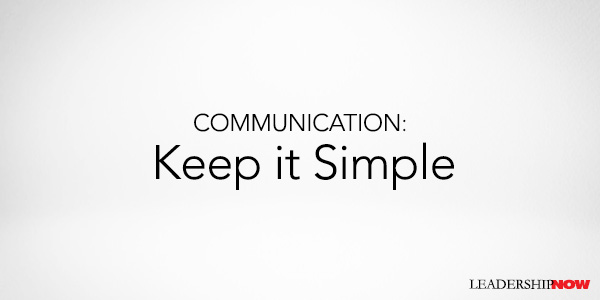
PROCTER & GAMBLE Chief Executive A. G. Lafley believes that simplicity is the key to good communication. He told the U.S. News and World Report: Repeat after me. If that sounds simplistic, Lafley is the first to admit that it is. Yet in a company where more than half the employees don't speak English as their first language, he says his Sesame Street- simple slogans, repeated over and over, keep everyone trained on what's important. Human beings "don't want to stay focused," he says. "So my job is to get them to focus their creativity around the focus; focus their productivity around the focus; focus their efficiency or effectiveness around the focus." Jack Trout, a promoter of simplicity, suggests in his book The Power of Simplicity, that these famous adages wouldn’t be so famous if they had been written with a heavier hand and fancier words: • Pulchritude possesses profundity of a merely cutaneous nature.
• It is not efficacious to indoctrinate a superannuated canine with innovative maneuvers.
• Visible vapors that issue from carbonaceous materials are a harbinger of imminent conflagration.
• A revolving mass of lithic conglomerates does not accumulate a congery of small green bryophitic plants.
Posted by Michael McKinney at 11:57 PM
05.15.08

Out of Context: More Isn't Better. Better Is BetterMost presentations aren’t better for being longer, most conference calls aren’t better for being extended, most meetings aren’t more productive because you spent more time in the room. It’s just that in this age of super-sizing everything from hamburgers to automobiles, we’ve become addicted to the idea that more is better. I am here to ask you to join my revolution, to tattoo on your brain, if not your backside, that “More isn’t better. Better is better.” —Frances Cole Jones,
How to Wow: Proven Strategies for Presenting Your Ideas, Persuading Your Audience, and Perfecting Your Image
Posted by Michael McKinney at 10:05 AM
04.14.08

Getting the Information You NeedIn the Spring issue of the Leader to Leader Journal, authors Mark Ronald and Robert Shaw tackle the issue of getting the good information needed to make informed decisions in Developing Peripheral Vision. The problem we are often faced with is that people are reluctant to talk about their concerns. They write, “For a variety of reasons, individuals often communicate in subtle or even misleading ways in regard to how they feel about a key decision.” There is a lot that we as leaders, can do contribute to the problem of open and clear communication.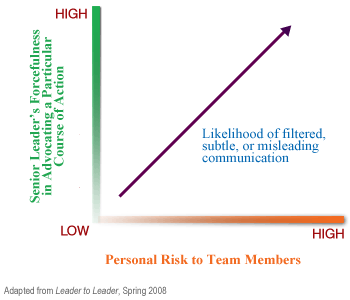 They list six behavioral flags or signals that might mean that the leader needs to take more direct action to get the information they need. In brief: Silence: In leadership teams, members who don’t support the trend of a decision often simply disengage from the dialogue and remain silent rather than pose a contrary point of view—particularly if the leader appears to support the decision or the group is moving quickly to closure. Who has checked out? Non-answers: People can opt out by appearing to agree with the leader when, in fact, they do not. “If you think it’s the right decision, that’s good enough for me.” Omissions: It is often what is not said that is most critical—particularly on issues that the leader believes will be problematic. Specific language: People surface their true feelings in hundreds of subtle ways. Leaders need to pay attention to the specific use of words that are flags suggesting that more discussion or follow-up is needed. Offline input: Often, the insights people bring to a leader (or each other) during the breaks of meetings or in informal hallway conversations are more important than what is said in formal discussions. E-mail traffic: In many firms, e-mail offers insight into potential issues that may require a leader’s attention. For example, an overly formal e-mail message with multiple people copied (or blind copied) is often a protective action taken by a team member with concerns. It is up to the leader to determine what is important and what is simply noise.
Posted by Michael McKinney at 01:26 AM
04.09.08

The Lack of Substance in Public Speeches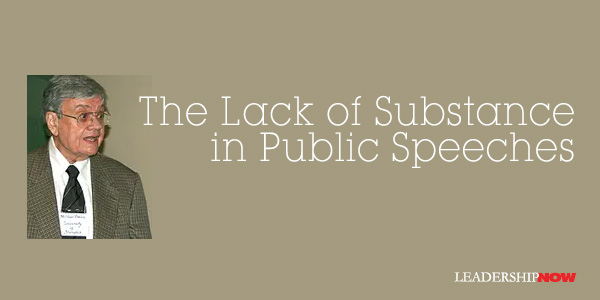
PUBLIC speaking expert Michael Osborn recently delivered a speech to the Georgia Communication Association, where he stated that he has watched a problem become a crisis. The crisis is the lack of substance in the speeches we hear. He states: It is the declining quality of reasoning, the neglect of evidence both by speakers and listeners. It is the erosion of standards that lets so much slide by unquestioned—and that results sometimes in tragically flawed policies and practices. It is our impatience with debate and our unwillingness to play active roles as citizens in deciding public policy. As leaders, are we leading or pandering? It’s time to build up our thinking, reasoning and reasearching skills to counter “an increasingly mass-mediated and cynical culture.”
Posted by Michael McKinney at 09:21 AM
02.13.08

How to Start Strong with Any AudienceIn Brian Tracy’s new book, Speak to Win, he presents 8 tips for taking command of the podium before even speaking a word:
Posted by Michael McKinney at 01:11 PM
01.30.08

5 Leadership Lessons: Inside Welch's Communication Revolution at GE Lane asks: "What jobs are you disqualifying yourself from because of poor presentation skills? These efforts are fairly easy to acquire, and involve the architecture and effort in the presentation itself, rather than theatrics and what color dress you wear."
Posted by Michael McKinney at 09:24 AM
12.07.07

Roger Martin on Assertive Inquiry READERS have had some questions about "assertive inquiry" as presented in Roger Martin’s book The Opposable Mind. Here are some explanatory excerpts from the book:
READERS have had some questions about "assertive inquiry" as presented in Roger Martin’s book The Opposable Mind. Here are some explanatory excerpts from the book:
“When we interact with other people on the basis of a particular mental model, we usually try to defend that model against any challenges. Our energy goes into explaining our model to others and defending it from criticism. “The antidote to advocacy is inquiry, which produces meaningful dialogue. When you use assertive inquiry to investigate someone else’s metal model, you find saliencies that wouldn’t have occurred to you and causal relationships you didn’t perceive. You may not want to adopt the mental model as your own, but even the least compelling model can provide clues to saliencies or causal relationships that will generate a creative solution.” Ask:
Not:
Obviously tone is important here. If your attitude is one of really seeking to understand and build bridges, it will come across. Otherwise, it is just another way you’ve picked up to try to argue your point and that will come across too. Martin continues, “Assertive inquiry isn’t a form of challenge, but it is pointed. It explicitly seeks to explore the underpinnings of you own model and that of another person. Its aim is to learn about the salient data and causal maps baked into another person’s model, then use the insight gained to fashion a creative resolution of the conflict between that person’s model and your own.” 
Posted by Michael McKinney at 08:38 AM
11.23.07

Why Leaders Don’t ComplimentIn Results that Last, Quint Studer lists six myths and excuses as to why too many leaders resist giving people much needed compliments.
Charles M. Schwab (1862-1939), founder of the Bethlehem Steel Company, said, “I have yet to find the person, however great or exalted his station, who did not do better work and put forth greater effort under a spirit of approval than he would ever do under a spirit of criticism.” In the often cited study by Gerald Graham, Ph.D. of Wichita State University, it found that employees consider personal, immediate recognition by their managers to be one of the most powerful workplace motivators. However, 58 percent of the respondents said their manager rarely, if ever, offered such simple praise. Graham concluded, “It appears that the techniques that have the greatest motivational impact are practiced the least, even though they are easier and less expensive to use.” Who should you be thanking?
Posted by Michael McKinney at 09:41 AM
11.19.07

Reframing Conflict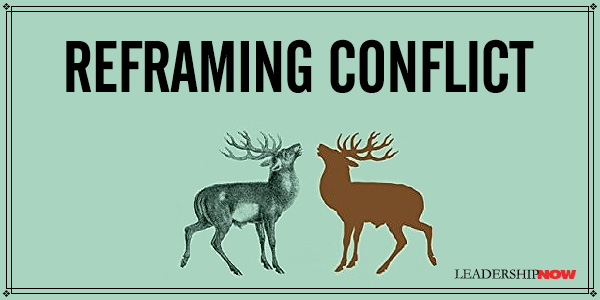
NEGOTIATION expert and Harvard Law School professor, Roger Fisher talks about how we communicate through conflict in Managing Conflict. Reframing the situation we find ourselves in to reflect a concern for he other person’s point of view can move us through a perceived impasse. Fisher’s rethinking process excerpted here, is helpful in this regard: “So I come and try to put myself in your shoes: How do you see it? How can I help you see it in a way that will be helpful to you, where you can go forward? I’m not telling you what to do; I’m not fighting with you.” “I have to get on your side, understand what you’re thinking about; what you’re worried about—your concerns, your interests—and how I can help you deal with your side.” Fisher adds: “Negotiation is recognizing that it’s not just the other side that has the problem but that we have a problem together. When you negotiate, you want to understand each other’s perceptions. How do you see it? How do I see it? How do we change it from adversarial to side by side, so that we’re both working on this?” 
Posted by Michael McKinney at 05:03 PM
11.05.07

The Art of Winning Others Over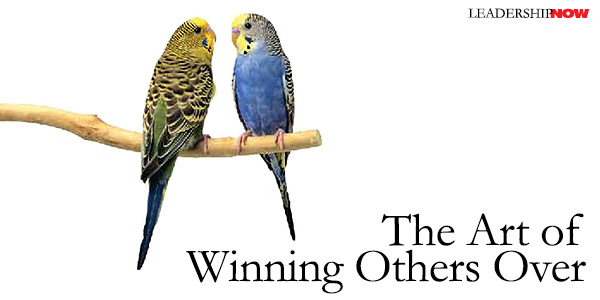
If there is any secret of success, it lies in the ability to get the other person’s point of view and see things from that person’s angle as well as your own. IN The Art of Woo or "Winning Others Over," authors Richard Shell and Mario Moussa, make the case that wooing is one of the most important skills in a manager's repertoire. Research would seem to support this claim as people with strong social skills have been shown to command higher fees and salaries than equally talented but less socially adept colleagues. And they are no doubt more pleasant to be around. Winning others over is an art. It is the ability to sell “your ideas to people within the context of ongoing, important relationships.” They maintain, “If you want to be a player in your organization, a successful partner with your customers or suppliers, a leader in your community, or even a good parent, you need to woo people to your point of view by putting your ideas across in convincing, relationship-friendly ways.” To that end, they remind us that the idea in persuasion is not to defeat the other person but to win them over. The place to begin is in understanding your own persuasion style. They have identified five types—The Driver, The Promoter, The commander, The Chess Player, and The Advocate—and have included a Persuasion Style Assessment to get you started. Whatever your preferred style tends to be, the idea is to strike a balance between what the authors identify as the "self-oriented" perspective-where focus is on the persuader's credibility, and point-of-view and the "other-oriented" perspective, which focuses on the audience's needs, perceptions, and feelings. They have created a systematic strategy or Woo Process, to aid you in skillfully getting your point across. In brief, they are: Step 1: Survey Your Situation, that is
They note that authority plays a background role in most interactions and while it can be useful in some situations, it should not be relied upon especially where there are multiple stakeholders. They say, “The formal roles people occupy are the starting positions for a complex dance of organizational influence.” They also note that actually, the higher up you go in an organization, the less authority comes into play and the more important relationship and persuasion skills become. 
Posted by Michael McKinney at 09:03 AM
09.14.07

Taking It Personally“Foolish is the person that takes offense when none was intended. More foolish is the person that takes offense when it was intended.”The above statement rings true, because either way we lose. In egonomics, David Marcum and Steven Smith describe the difficulties that arise when we get our identity confused with the topic being debated—when we take things personally. When we get into a vigorous debate, it’s quite common to find that we respond to a perceived attack with behavior that indicates our ego is in trouble. When we respond to a statement or question by comparing ourselves, seeking acceptance, showcasing or getting defensive, it often means that we think our identity is under attack. In other words, we forget about the debate of ideas and respond as though who we are is being threatened and we take it personally. It’s not unusual that we have a tough time separating our ideas from our identity? Trial attorney Gerry Spence explains, “We all have a personal image that he must protect. For example, I do not want to be seen by others, and particularly my myself, as weak, as ill advised, as less than worthy, as stupid, as someone who cannot be respected. I will do whatever is necessary to preserve my personal image of myself. The more fragile my self image, the harder I will struggle to preserve it.” Marcum and Smith explain it this way: “If we can’t distinguish who we are from what we do, what we have, or who we do it with, we won’t see past our titles or tenure in a discussion. If we say to ourselves or others, ‘I’m the Vice President,’ ‘I’m the CEO,’ ‘I’m the Director of Public Relations,’ or even ‘I’m the creative one’ or ‘I’m the advocate for diversity here,’ then we’re parading our identity, and take it personally.” In egonomics, Marcum and Smith examine an exchange between Fred Rogers and Senator John Pastore at a Congressional hearing to effectively explain this point. It clearly showcases the benefits of maintaining a separation between identity and ideas and keeping your ego in check with humility. They explain, “In the intensity of debate, humility is like a two-way surge protector; it keeps us from making it personal or taking it personally.” Of course, the trick is to avoid this negative response cycle in the first place. The authors borrowed an idea from Carl Rogers to give form to an essential attitude to take when faced with a vigorous debate (or when dealing with people in general). The idea is to treat people with unconditional positive regard. That is to say that “everyone is worthy of respect and capable of contribution, even when they don’t particularly act that way or even feel that way about themselves.” We want to assure others that we aren’t trying to change who they are, but we are interested in presenting another viewpoint. If you find yourself in a situation where things have gotten beyond productive, then the author’s suggest using one of the following opening statements before we begin asking questions: “You might be right…” “Even though that’s hard to hear, I’m glad you’re saying something…” “Okay. Let’s talk that one through.” “Say a little more about that.” It doesn’t signal agreement, it expresses a mind open to understanding. Debate needs to follow understanding or people often begin to defend themselves and not their ideas. Finally, in the spirit of vigorous debate and deepened understanding, humility prompts us to ask, “Who cares if I’m right at this instant if we get it right eventually?” If we’re devoted to progress, it doesn’t matter who has the answer, but that the answers are found.In the balance of the book, Marcum and Smith show that shifting conversations from statements and judgments to exploration requires not just humility, but the relentless application of two more principles—curiosity and veracity. They maintain a good blog that is worth checking out also.
Posted by Michael McKinney at 12:33 AM
07.12.07

Having Trouble Listening?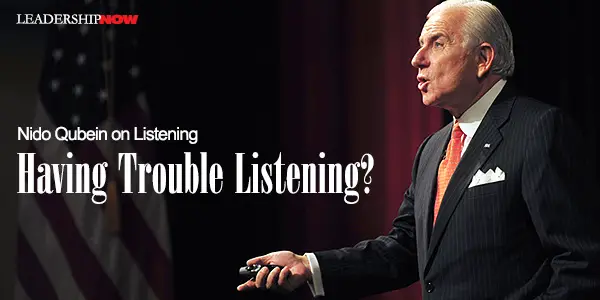
EFFECTIVE leaders will make a concerted effort to listen to and learn from those around them. In How to be a Great Communicator, author Nido Qubein, suggests that if you are having trouble listening, the following factors may be behind the problem: Prejudice: We all have biases. It’s all too easy to ignore a person because of something we don’t like or value about them. “It’s best to overcome our prejudices, but while we’re overcoming them we must learn to override them.” Jumping to Conclusions: Listening can be difficult, especially when you think you have heard it before. When you get that bored feeling and begin to drift away, bring yourself back to the present and “accept the challenge of drawing from the speaker some ideas and information that will be of value to you personally." Assumption: Related to the above, Qubein writes, “You may assume that you already know what the speaker is going to say, so your attention drifts elsewhere….Make it a game to look for something new to take away from the conversation.” Inattention: We can think almost four times faster than we can speak. In the lapse between the two it’s easy to place your attention elsewhere or begin to formulate what you want to say. In doing so you may miss important information. “The remedy is to use the ‘spare’ time to evaluate and interpret what the speaker is saying.” Selective Listening: Our minds are tuned to hear what we want to hear; those things that confirm what we already think. “Once again, the solution is to evaluate and interpret. Look for information and ideas that challenge your own ideas.” Excessive Talking: If we’re talking, we’re not listening. It’s easy to use someone else’s comment as a jumping-off point to your monologue. “Be conscious of the amount of time you spend talking, and be alert for signs that your listener has something to say. Be willing to yield the floor at reasonable intervals.” Lack of Empathy: Try to listen from the other person’s point of view. Knowing where the other person is coming from can give you a lot of insight into what they are saying. Fear: When you don’t like what someone else is saying or if you think it might make you look bad, instead of listening, we often begin to formulate an argument or begin to plan our escape. Force yourself to hear the other person out. Qubein cites Patrick Henry, “…Whatever anguish of spirit it may cost, I am willing to know the whole truth; to know the worst, and to provide for it.” 
Posted by Michael McKinney at 10:03 AM
06.13.07

Andy Stanley on Communication and Leadership "Here's an incredibly important principle. You cannot communicate complicated information to large groups of people. As you increase the number of people, you have to decrease the complexity of the information. Congregational rule, when you're trying to make a complicated decision, works against the principle. So consequently, the guy with the microphone and the clearest message always wins. The most persuasive person in the room is going to win. Whether right or wrong." He was asked about criticisms that some churches seem so corporate in their leadership structure with the pastor as CEO. He says there is a sound principle behind the structure: “‘Follow me.’ Follow we never works. Ever. It's ‘follow me.’ God gives a man or a woman the gift of leadership. And any organization that has a point leader with accountability and freedom to use their gift will do well. Unfortunately in the church world, we're afraid of that. Has it been abused? Of course. But to abandon the model is silly.” I would add that we can find many that are afraid of that concept outside the church as well. It's often why we see leadership theory taking strange twists and turns in the literature today. Learning to operate without abusing the influence or power that goes with leadership at any level, requires a proper perspective as to why you are leading in the first place.
Posted by Michael McKinney at 03:10 AM
04.11.07

A Tutorial On Letter Writing
 To — Lith
Posted by Michael McKinney at 09:19 AM
02.26.07

The Art of CommunicationIn Communication Arts, designer and communications strategist Cheryl Heller asks if there has “ever been a better time to ponder the art of communication? Or a time when the fate of life as we know it hangs on our ability not only to communicate but to actually understand each other?”She observes that all of us are communicating but wonders what it is we are not talking about that we should. T.S. Eliot asked, "Where is the wisdom we have lost in knowledge? Where is the knowledge we have lost in information?" Communicators should be about helping people to process all the banter they experience into meaningful thought. That activity, often referred to as the four levels of learning—a progression moving from raw data to information, to knowledge and finally to wisdom—is not always an easy one. There are many things that conspire to keep us from getting there. 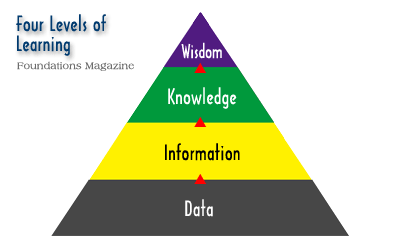 Heller asks, “How can we get people’s attention and begin to tell the truth? How can we learn to listen differently so that we know what the truth is?” A couple of key questions. Overcoming our own biases, preconceived ideas and faulty thinking make that all the more difficult. Heller offers some ideas. Two of the most important are, first, having the courage to say less. “This is the opportunity to evolve from being paid for how much you can do to being paid for how well you think.” Secondly, and frankly the most crucial, is making time to think. She suggests, “Pay quality attention to the things that matter, and give our brains some time to digest.” Make the time. More on developing wisdom:
Posted by Michael McKinney at 08:47 AM
01.15.07

Martin Luther King Jr. and Adaptive Change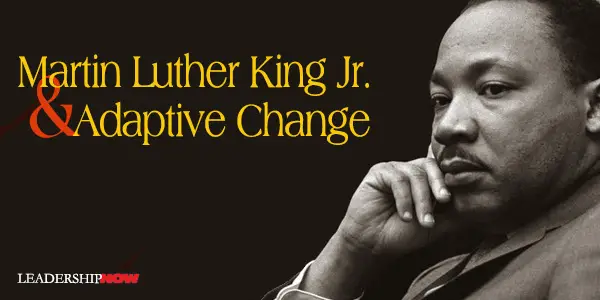
W In Leadership on the Line, authors Ronald Heifetz and Marty Linsky explain, “To sustain momentum through a period of difficult change, you have to find ways to remind people of the orienting value—the positive vision—that makes the current angst worthwhile.”  “As you catalyze change, you can help ensure that you do not become a lightning rod for the conflict by making the vision more tangible, reminding people of the values they are fighting for, and showing them how the future might look. By answering, in every possible way, the “why” question, you increase people’s willingness to endure the hardships that come with the journey to a better place.” This is what Martin Luther King Jr.’s accomplished in his famous I Have a Dream speech. He painted a tangible vision when he said: I have a dream that my four little children will one day live in a nation where they will not be judged by the color of their skin but by the content of their character. I have a dream today. Interestingly enough, the civil rights speakers who were to speak on that day—August 28, 1963—argued amongst themselves who would speak when and for how long.
Posted by Michael McKinney at 07:11 AM
12.13.06

Who Will Succeed or Fail in the Corner Office?
CAROL HYMOWITZ asked in Monday’s Wall Street Journal, “which CEOs have the skills to survive the New Year’s challenges?” In her article she writes: The true test of enduring leadership success is how well business leaders handle setbacks and failures. They can advance by outperforming others, but they can't always be in control. A leader’s communication flexibility and consistency is important in this regard. Leaders are not only expected to influence their direct reports, Gene Klan writes in his new book, Building Character, but “are also expected to influence their superiors, board members, peer, customers, clients, suppliers, the news media, community officials, political leaders, government regulators, negotiators, environmental authorities, special interest groups, Wall Street Analysts, and any number of other stakeholders…. [E]ach group requires different tactics to be influenced and led both effectively and positively. Leaders need flexibility and many different skills to communicate credibly and interact with all these parties for maximum results.” Consistency is a matter of character. “For leaders,” Klan continues, “consistency means always reflecting the same basic principles in practice. It means that one’s behaviors conform and agree with one’s past words and actions regardless of pressure, criticism, and advice to do otherwise. It means maintaining the habitual positive behaviors that are key to winning trust and respect and achieving effectiveness overall. It means being seen and known as a pillar of dependability and reliability, not changing or wavering based on opinion polls, internal disapprovals, or external condemnations." "Consistency also implies that a leader’s behaviors and character are not compartmentalized between work and personal life. You are who you are, and that doesn’t change when you arrive at the office or at your own front door. Your character is such that you find consistent standards for behavior in any context. Responsibilities, stresses, and personalities may vary, but your character does not. All the politically correct arguments to the contrary do not change that reality. Behaviors reflect a leader’s character regardless of the context. In every context, your character will be noticed and judged.” It is these leaders that have to best chance of surviving the challenges that lie ahead in the coming year. 
Posted by Michael McKinney at 08:52 AM
10.13.06

How To Fine Tune Your Listening Skills
“Why do most of us like to talk so much? Because we want to be noticed. We get a charge out of being the center of the universe. But when you yap on, you use up all of the oxygen and energy in the room, which is debilitating for everyone else” say authors Linda Kaplan Thaler and Robin Koval in The Power of Nice. Often times, more communication is less communication. They suggest five ways to fine tune your listening skills: Let the Other Guy Be Smarter. When you let the other guy’s brilliance shine through, you not only gain new information, you also earn their goodwill. Everyone likes to be around people who make them feel intelligent. Keep It Simple. Sometimes the simplest answer is the best one. By listening rather than pontificating you will often hear the simple connection that makes the difference. Ask, Don’t Tell. When you ask questions, you tell people that you care about them, that you’re interested in what they have to say. You also send an oh-so-subtle message that you’re a bright, inquisitive individual who would like to know more. That’s why even the smallest question can have a huge impact. Don’t Argue So Much. Whenever problems or conflicts arise, there is a natural tendency to try and “talk your way out of it.” But sometimes you win your case by shutting up and listening your way out of it. Everyone Is Worth a Listen. Jay Leno says, “We live in a society of exclusion. There is this idea that you should try to keep people out—‘Oh, you can’t come into this club, you have to be a member, you don’t have enough money, you’re not handsome enough.’ But if you go through life with the opposite attitude and try to include everybody, it opens up doors.” Remember Dale Carnegie's quote: "You can make more friends in two months by becoming interested in other people than you can in two years by trying to get other people interested in you." 
Posted by Michael McKinney at 08:59 AM
10.04.06

Teaching as MarketingSeth Godin wrote an excellent post on his blog about communication through speeches or talk. He writes about the dynamics of speech: “Speech is both linear and unpaceable. You can’t skip around and you can’t speed it up. When the speaker covers something you know, you are bored. When he quickly covers something you don’t understand, you are lost.” This is both the advantage and the challenge of speech. A speech has always been a platform to sell ideas, but we often forget that and just drone on presenting what perhaps is important to us (often the audience can’t tell) without regard to our listeners. Godin adds, “If marketing is the art of spreading ideas, then teaching is a kind of marketing. And teaching to groups verbally is broken, perhaps beyond repair. Consumers of information won’t stand for it. We’re learning less every time we are confronted with this technique, because we’ve been spoiled by the remote control and the web.” Godin suggests, “If you teach—teach anything—I think you need to start by acknowledging that there’s a need to sell your ideas emotionally. So you need to use whatever tools are available to you—an evocative PowerPoint image, say, or a truly impassioned speech.” Speech isn’t broken; we just don’t take the time to do it well. A well crafted speech has the potential to cut through the clutter and hold your attention more intimately than nearly any other form of communication.
Posted by Michael McKinney at 12:17 AM
|
BUILD YOUR KNOWLEDGE
 

How to Do Your Start-Up Right STRAIGHT TALK FOR START-UPS 
Grow Your Leadership Skills NEW AND UPCOMING LEADERSHIP BOOKS 
Leadership Minute BITE-SIZE CONCEPTS YOU CAN CHEW ON 
Classic Leadership Books BOOKS TO READ BEFORE YOU LEAD |
|